A Trip to Granada, Spain (November 2019)
#1
Original Poster
Join Date: Jan 2019
Programs: Flying Blue Gold, Sas EuroBonus, Thon Hotels Discovery Gold.
Posts: 45
A Trip to Granada, Spain (November 2019)
My previous trips reports:
A Trip to Romania and Moldova (September 2019)
Background for this trip was to do a short visit the old folks, and at the same time get a chance to gaze upon the marvel that Alhambra is.
Travel Day # 01
Departure BGO – AMS - ALC.

Travel itinerary.

Travel itinerary - Bus and car.
Bergen, (Flesland Airport)
Amsterdam, (Schiphol Airport)
KL1188 Operated by KLM - Aircraft type: Embraer 190
Travel class: Economy Class
10:00 – 11:45.
Transfertime: 01h40
Amsterdam, (Schiphol Airport)
Alicante, (Alicante Elche Airport)
KL1509 Operated by KLM - Aircraft type: Boeing 737-700
Travel class: Economy Class
13:25 – 16:05.
The journey started with an early wake up, getting to the airport with bus and tram connections.
Arriving 8:40, I went straight for the baggage drop off, before proceeding through the Fasttrack.
Had a coffee before boarding started at 09:30, with self-scanning for priority passengers (that’s a new one for me). Unfortunately there is no lounge for SkyTeam members at BGO Flesland airport.
Since it was a full flight, everybody was offered free check inn for carry-ons luggage to final destination (this seems to be a very common issue on Bgo – Ams / Ams – Bgo flights).
By 09:45 boarding was complete, and we where cleared for take off soon after. Flight time was set to 1hour 25 minutes. Service was the usual small piece of cake, a coffee/tea and drink/water/beer.
At 11:20 we touched down at grey and rainy Amsterdam Schiphol airport.
Bus to gate today.
KLM Crown Lounge (Schengen side) was super crowded and busy, as always at this time.
Food and drinks selection were okay.
The KL1509 flight started priority boarding at 13:00, but we ended up being delayed some 10-15 minutes because of no-show and had to offload the baggage.
Flight time was set to 2hours and 20 minutes today on this full flight.
Not long after air born a warm pasta dish was served with beverage and coffee/tea.
We touched down at 16:10.
Alicante airport being pretty straight forward, no fuzz, and I found my self outside the terminal in a couple of minutes in good time for catching the 17:00 o’clock bus departure to
Torrevieja’s main bus terminal (7€uros, about 50 minutes ride), where I was picked-up and went straight for Orhiuela Costa where I stayed the night.

The new Terminal Bergen Flesland Airport, opened Arpil 2017. BGO is the second largest airport in Norway.
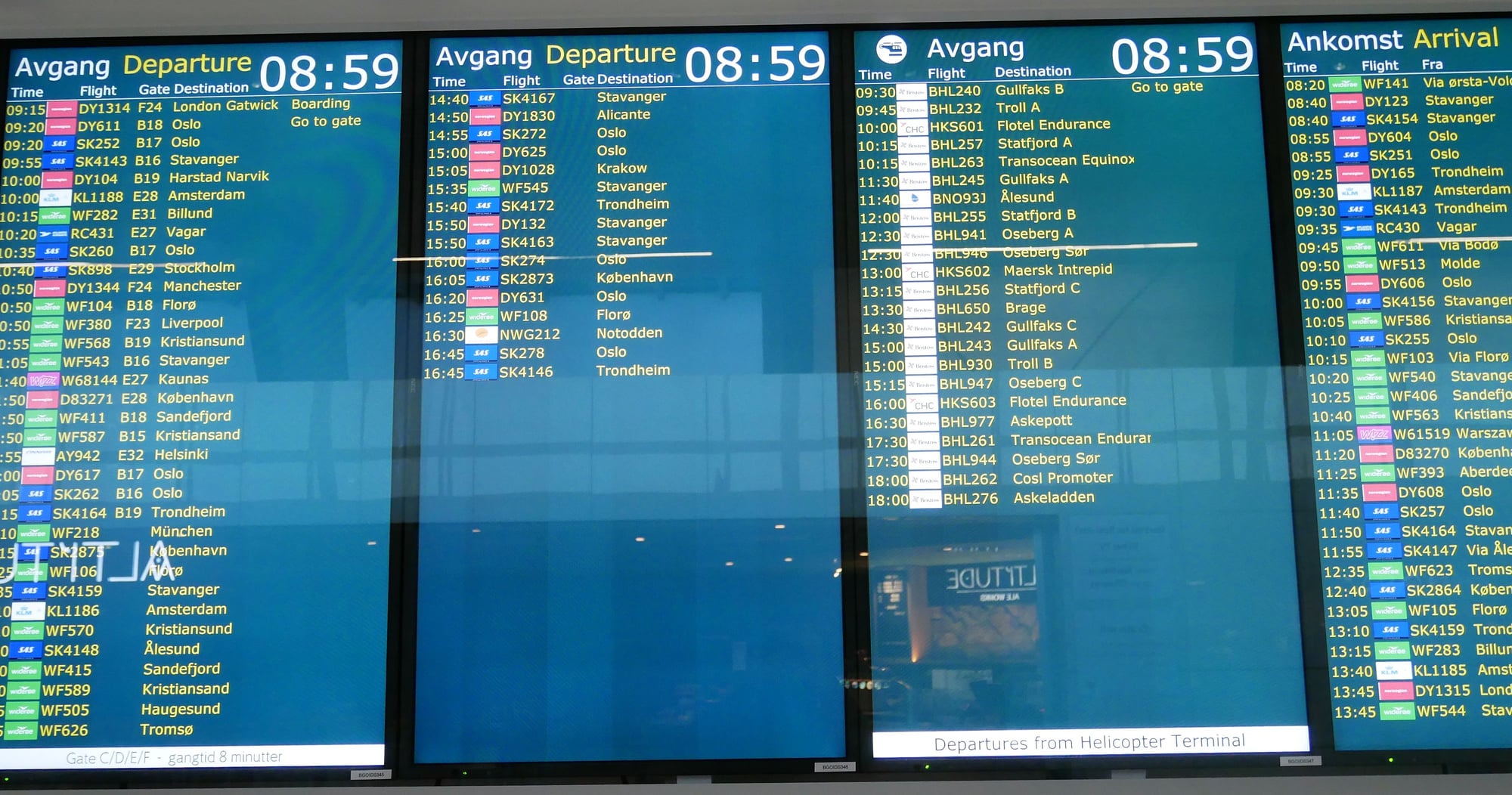
Departures&Arrivals.
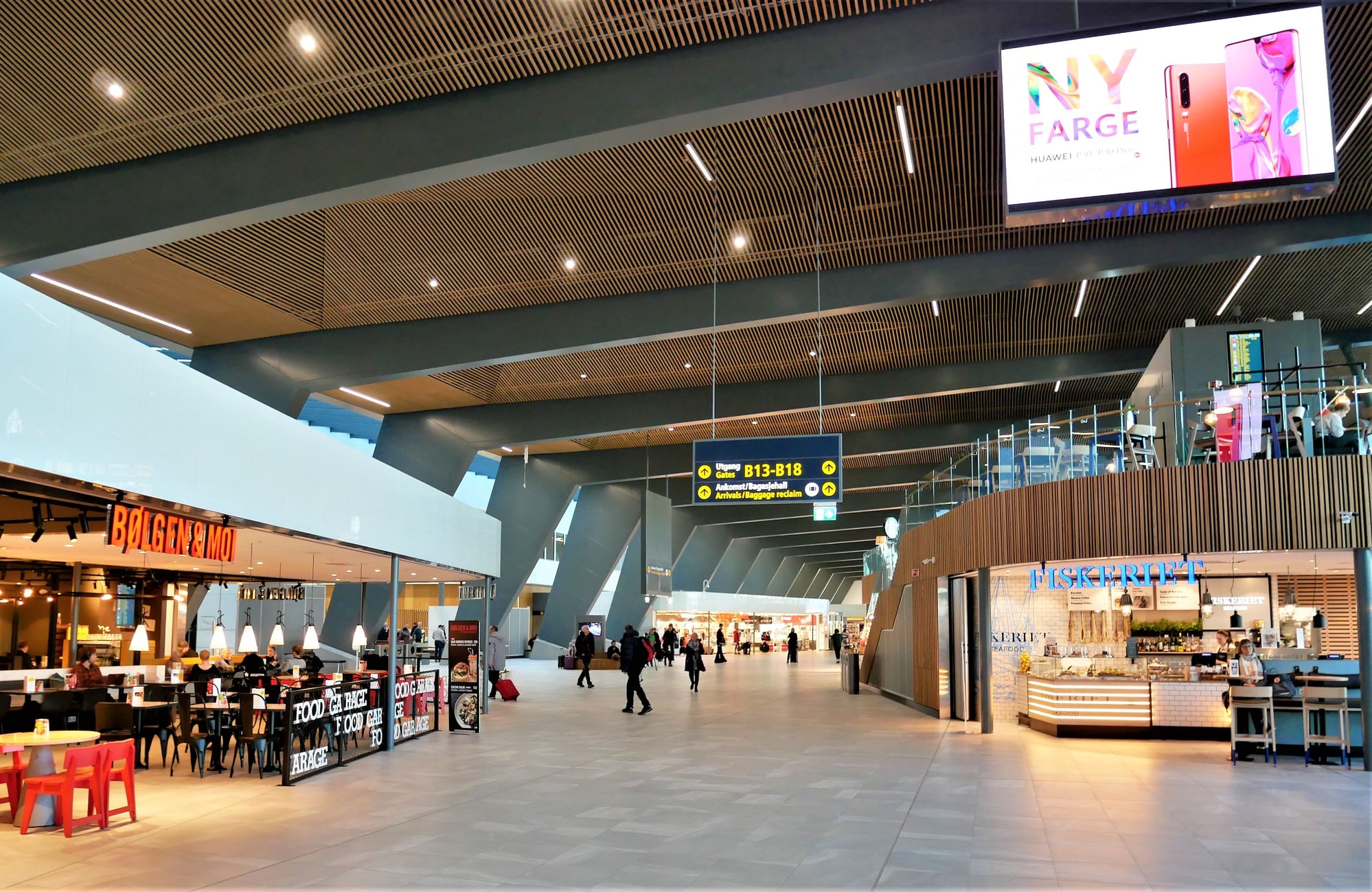
Inside the new Terminal. BGO.
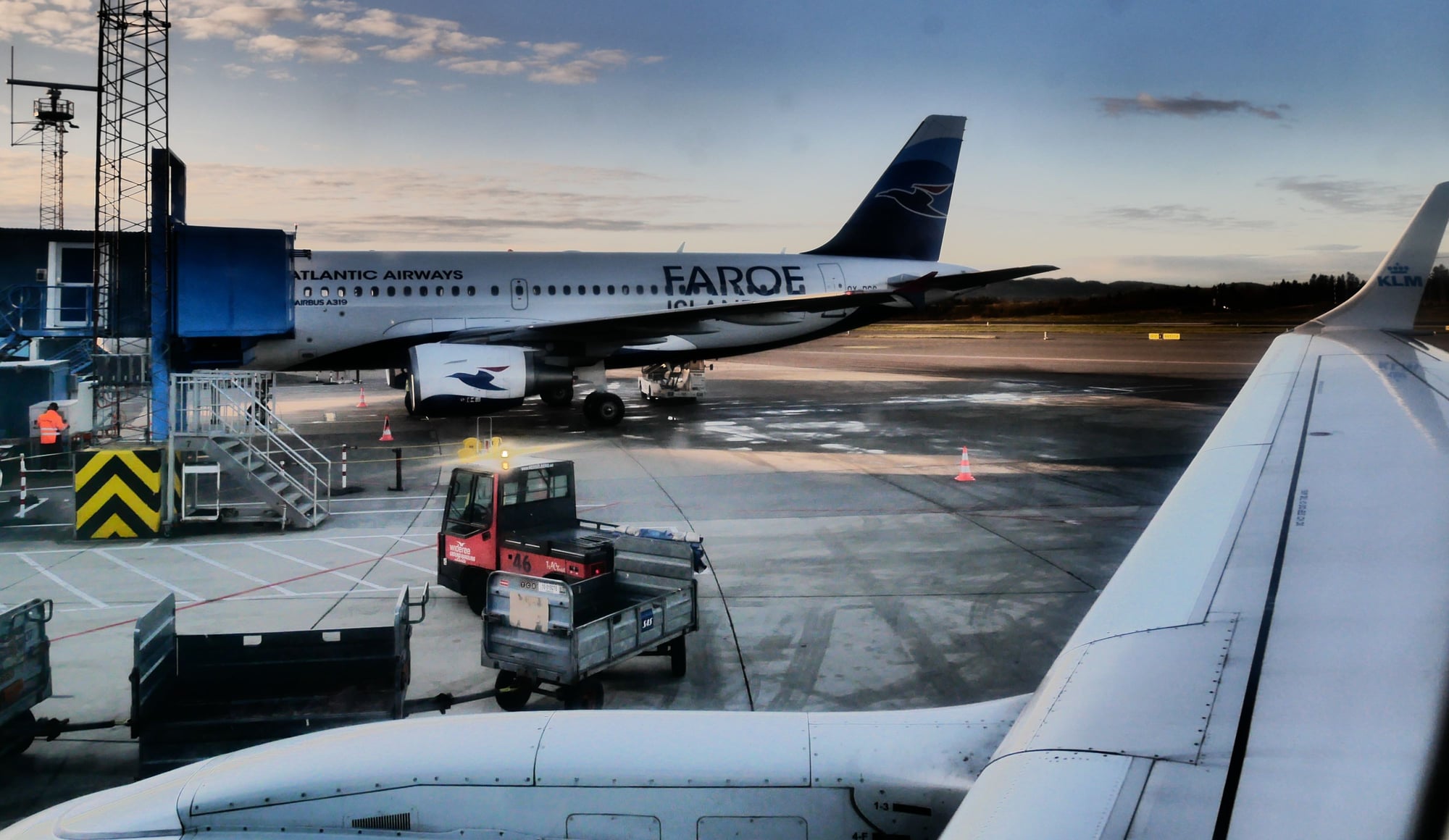
Atlantic Airways, the national airline of the Faroe Islands.
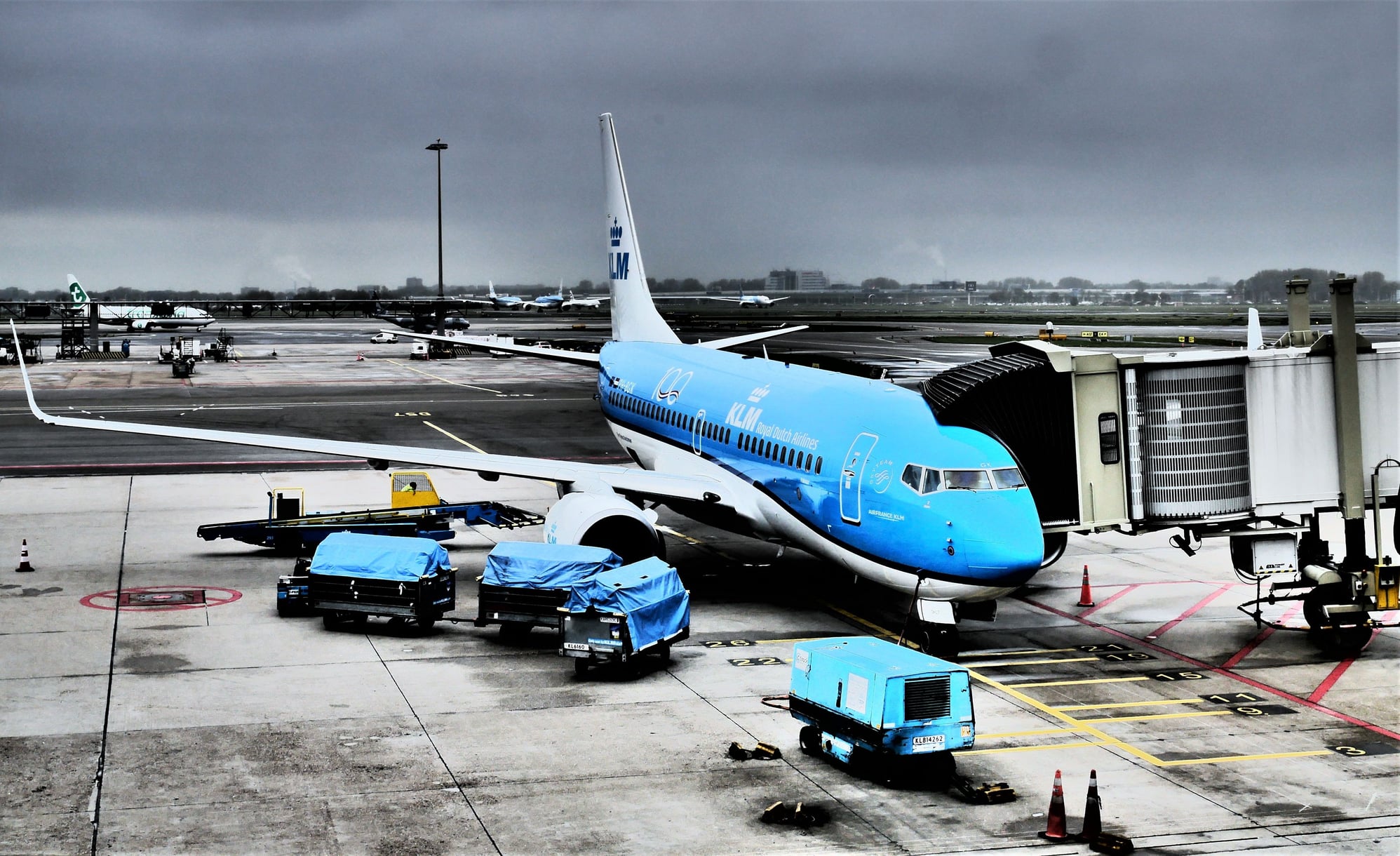
Kl1509. Boeing 737-700. Amsterdam.

Approaching Alicante.

On the road.

Lunchbreak, halfway. - Hotel Restaurante Casa Lorenzo.
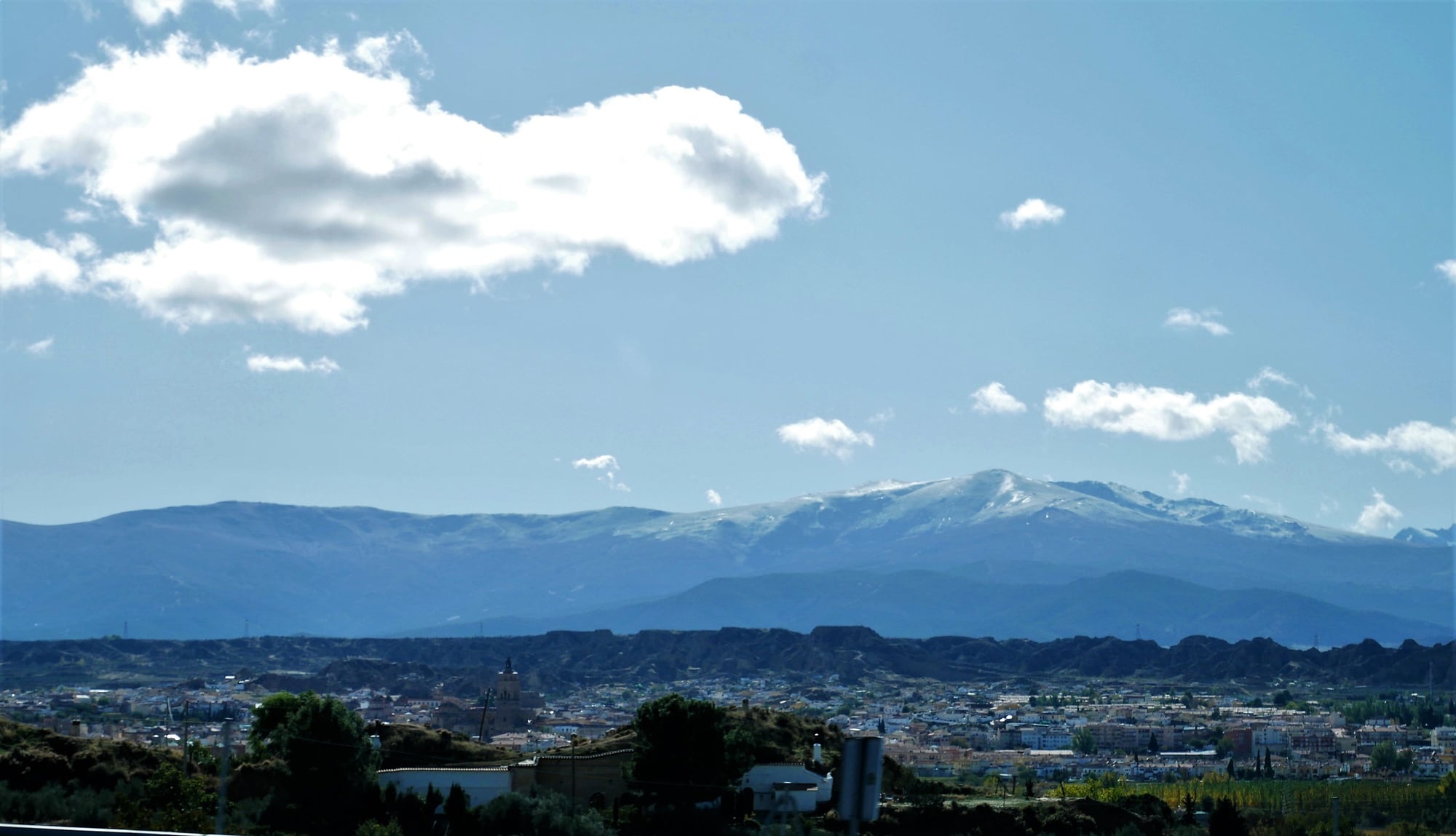
Scenery.
Travel Day # 2
Orhiuela to Granada.
It is roughly 317 kilometers to Granada from Orhiuela, making for a 3-3.5 hour drive by car, so we set off after having breakfast, at around 10:15.
It’s a nice journey heading south-east on A7, passing by fertile Murcia region, city of Lorca and small time Baza, making a stop along the way for some lunch.
The landscape changes drastically along the way, from flat fields with orange and lemon trees, palm trees and the beautiful sunny coastline, to more barren, dried, scarce soil, then again to flat fruitful tablelands
ith high slim trees looking like spires, shooting towards the sky, green bushes and more colorful trees and pine trees densely dotted around the landscape. In the south- east, the snowcapped Sierra Nevada (meaning snow mountains),
Spain’s highest mountain range, forms a natural barrier, almost like a wall.
The temperature drops (13c-15c) noticeable as we push further into the Andalucia region, it’s also windier in this part of the country, making it feel a bit colder.
The Andalucia, or Al-Andalus, as it was called during the Muslim’s almost 800 years rule (711-1492) in the Iberian Peninsula, is a part of Spain that is rich in culture and history.
Great cities like Cadiz, Cordoba, Malaga and Sevilla are all located here.
At around 14:30 we arrive at Sercotel Gran Hotel Luna de Granada, our stay for the next two days.
The hotel is located conveniently right outside the city center, making it easy to get to without having to make your way through small confusing streets and narrow alleys full of traffic.
Check inn is fast, room is of good size; big bed, overpriced minibar, tv and a big bathroom.
Unfortunately, the view is equivalent to looking straight at a brick wall.
We decide to have a wander around in the vicinity, and we soon stumble upon the massive Royal Monastery of San Jeronimo (Real Monasterio de San Jeronimo Granada).
This renaissance and gothic style monastery is the work of Isabella I of Castille and Ferdinand II of Aragon, the Catholics, fiery faith during the time of the Reconquista, work began in 1504.
Empress Isabella of Portugal stayed here for a brief period after her marriage to Charles V, the Holy Roman Emperor (known as Carlos V in Spain).
During the French Napoleon invasion, the church tower where demolished, and the rocks was used to build the Puente Verde bridge over the river Genil for linking parts of the land further outside of the city.
The guardian of the monastery doesn’t seem too interested in selling us entrance tickets (4€) to the monastery, nevertheless, once inside, I am struck by the beautiful gothic artwork, iconographic, sculptures and
the late renaissance altarpiece. This less “known” gem is truly a masterpiece to behold.
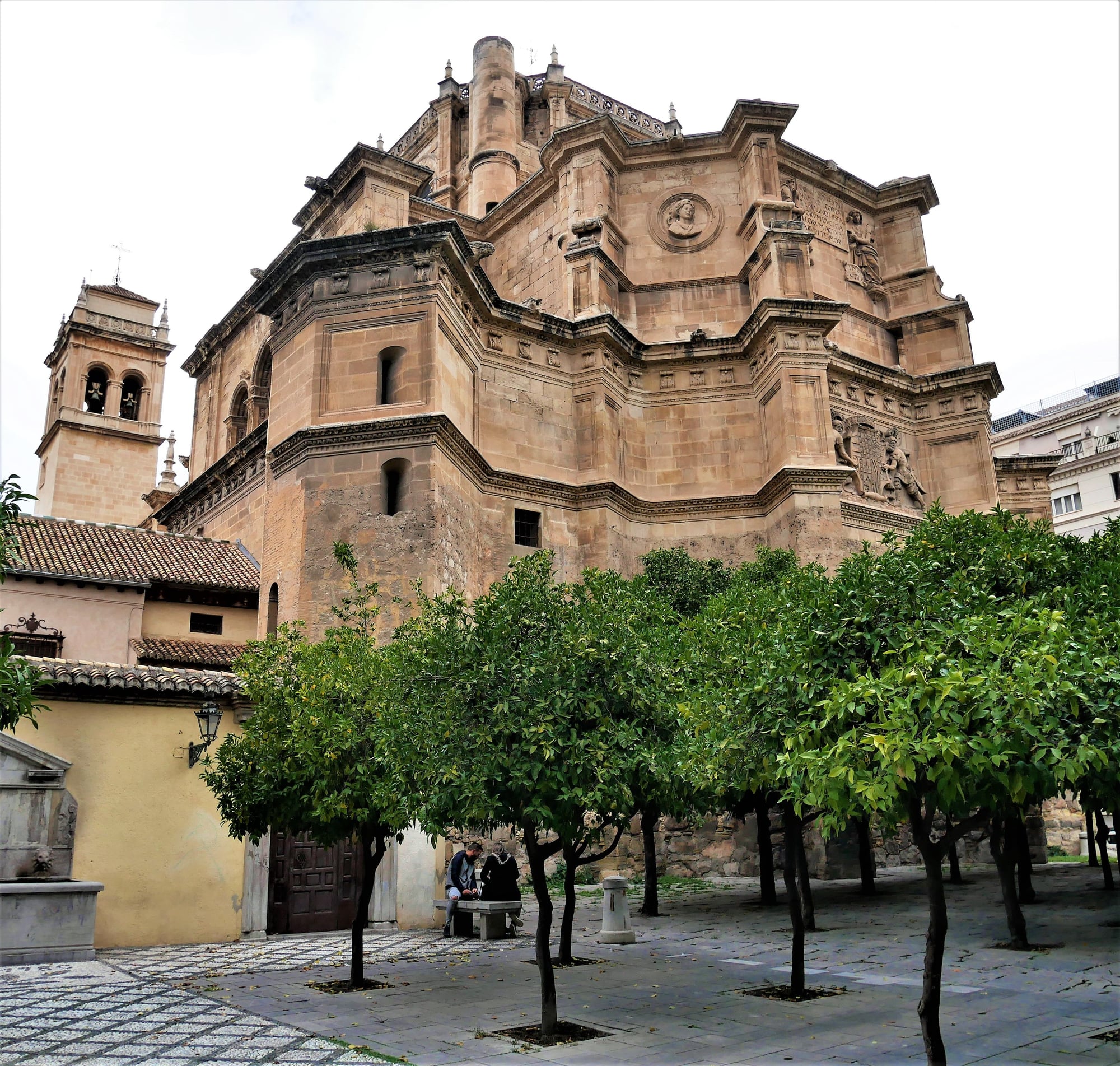
Monasterio de San Jerónimo. Construction began 1504.

Gothic ceiling. Monasterio de San Jerónimo.
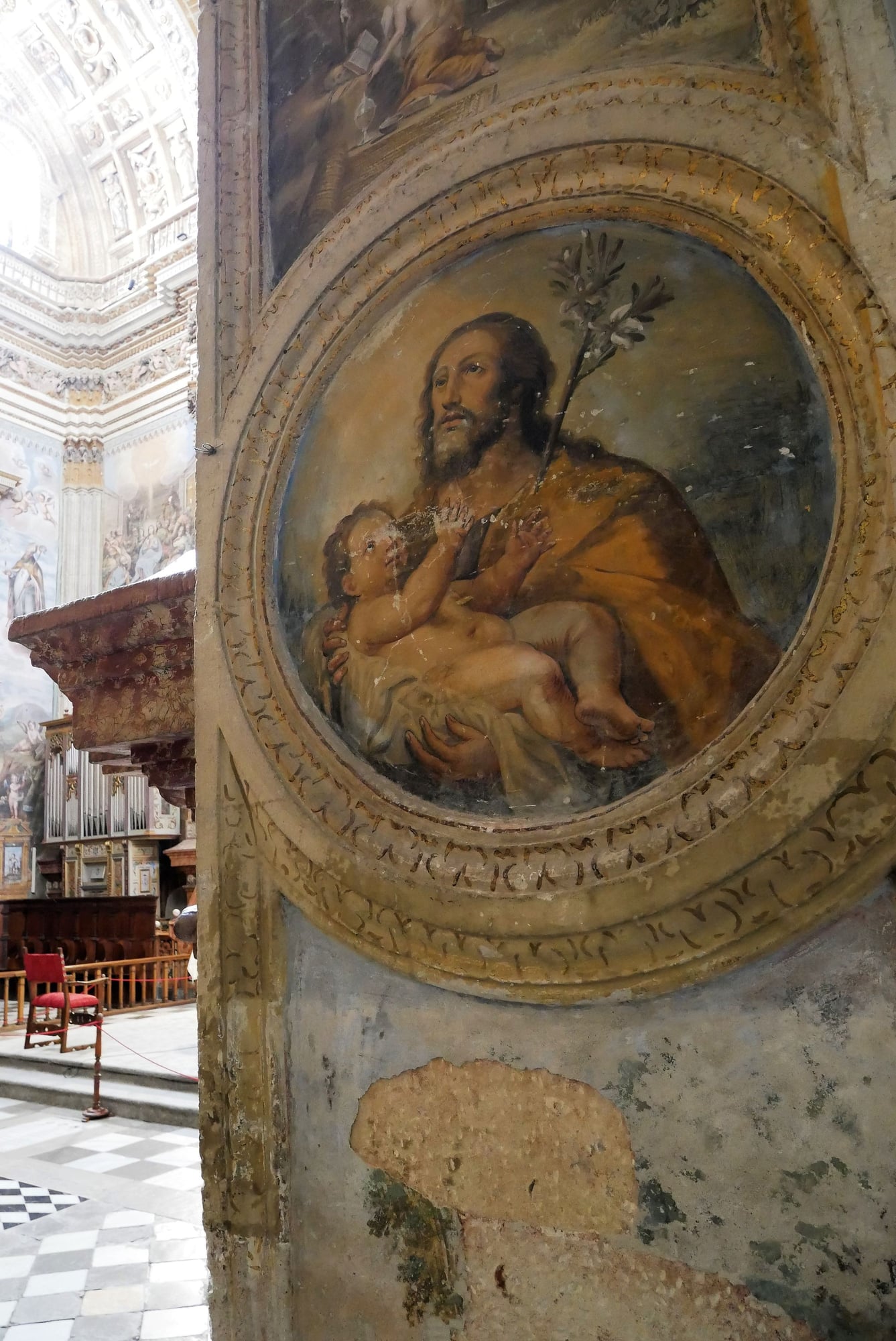
Jesus and palm-twig, symbol of peace and/or entry to Jerusalem. Monasterio de San Jerónimo.

Altar piece. Monasterio de San Jerónimo.

Sculptures&Paintings. Granadan school of sculpture.

Staircase. Monasterio de San Jerónimo.
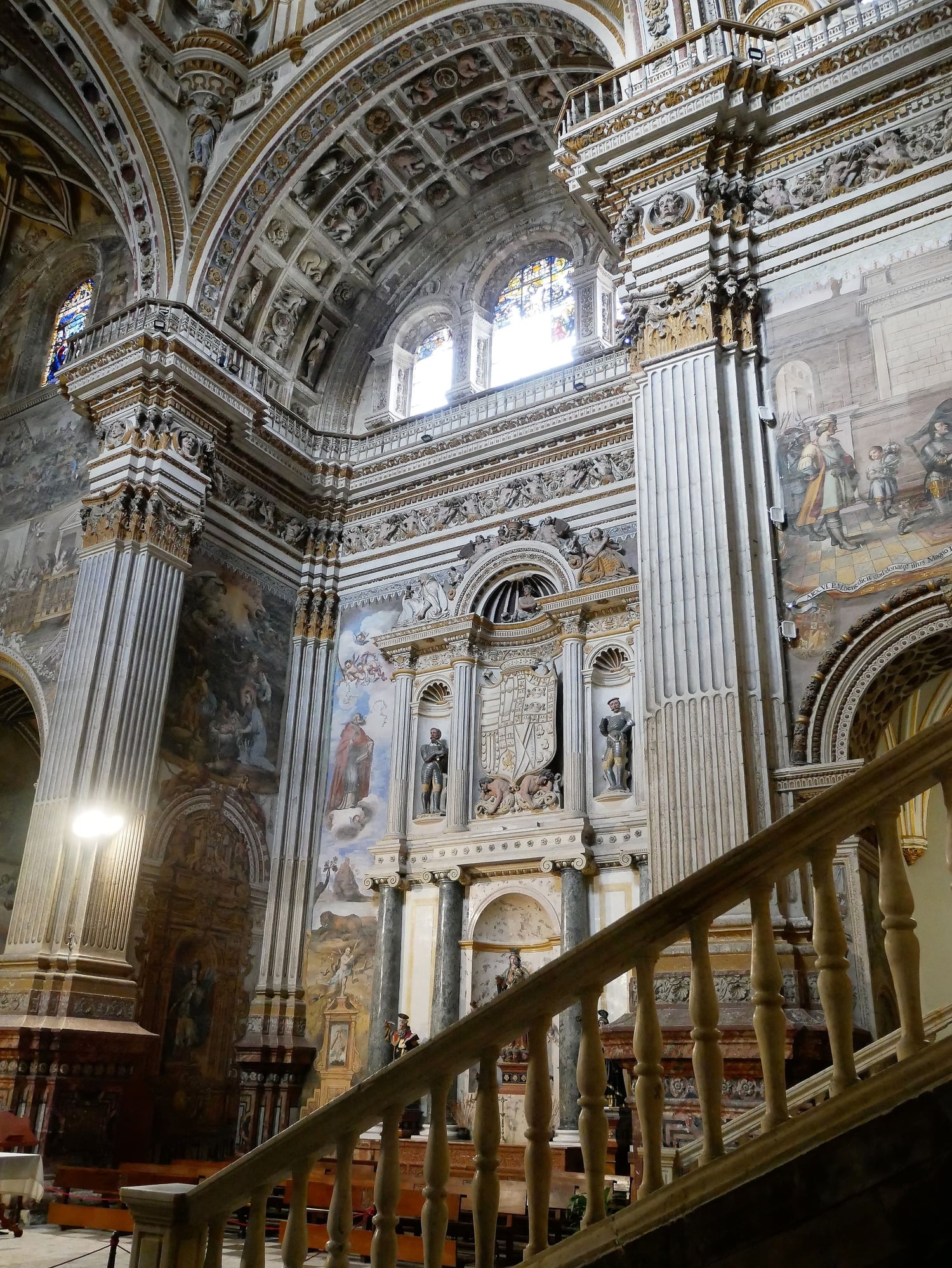
Cultural Heritage Site, Monasterio de San Jerónimo.
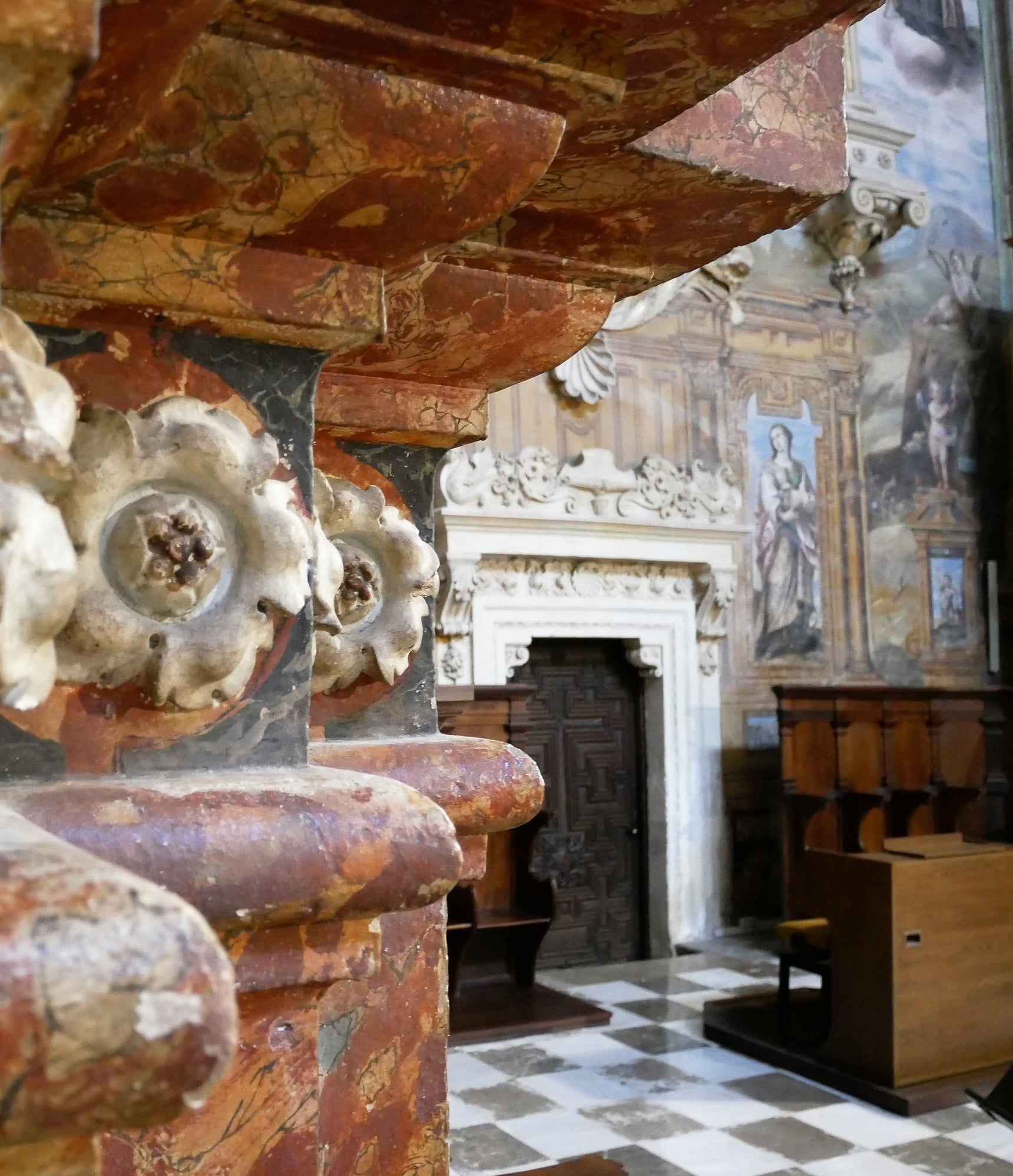
Details. Monasterio de San Jerónimo.
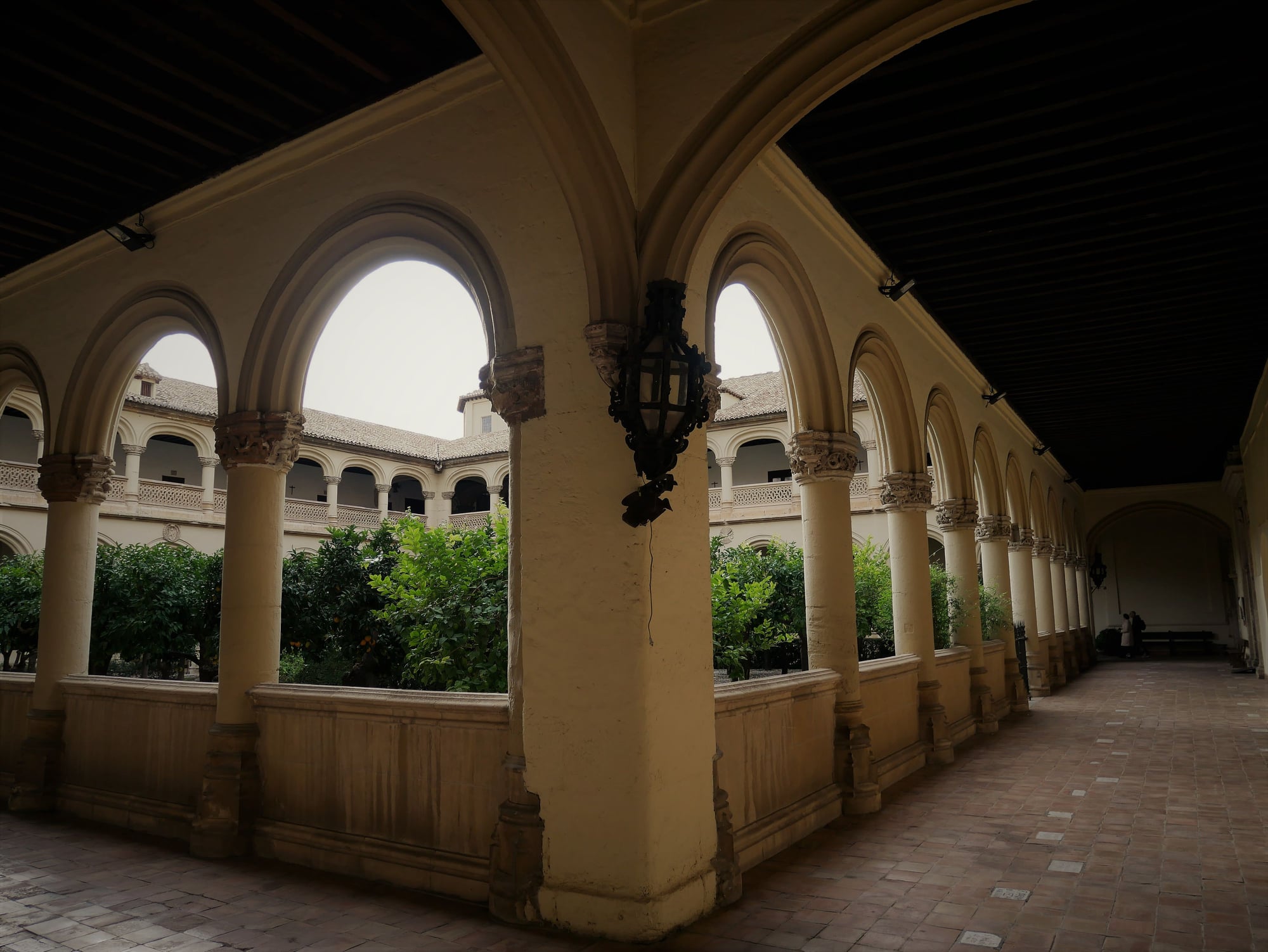
Cloister yard. Monasterio de San Jerónimo.
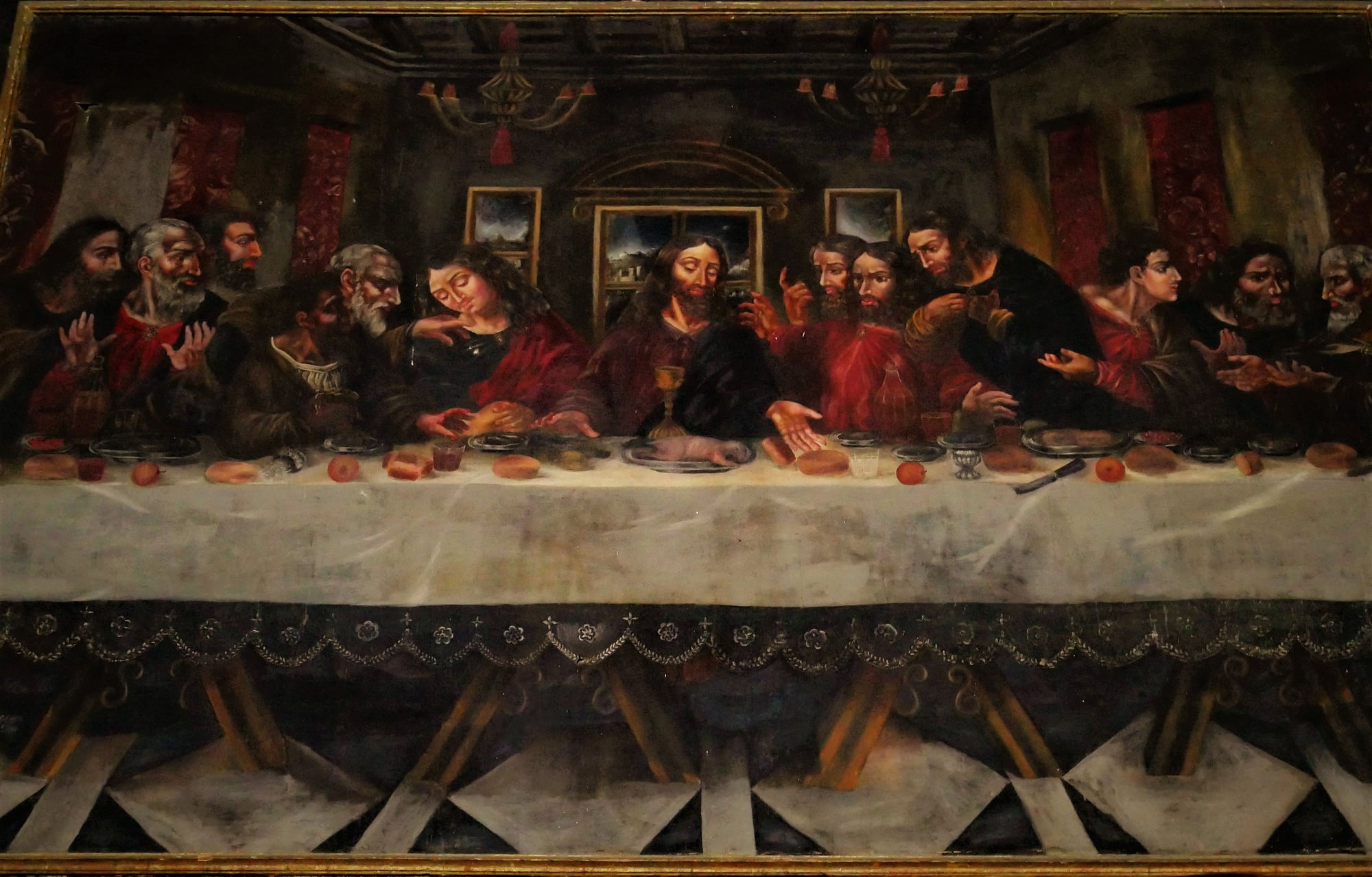
The Last supper by Juan de Sevilla Romero (1643 - 1695). Notice there is no knife on the table in this painting, as to da Vinci's, where there is.
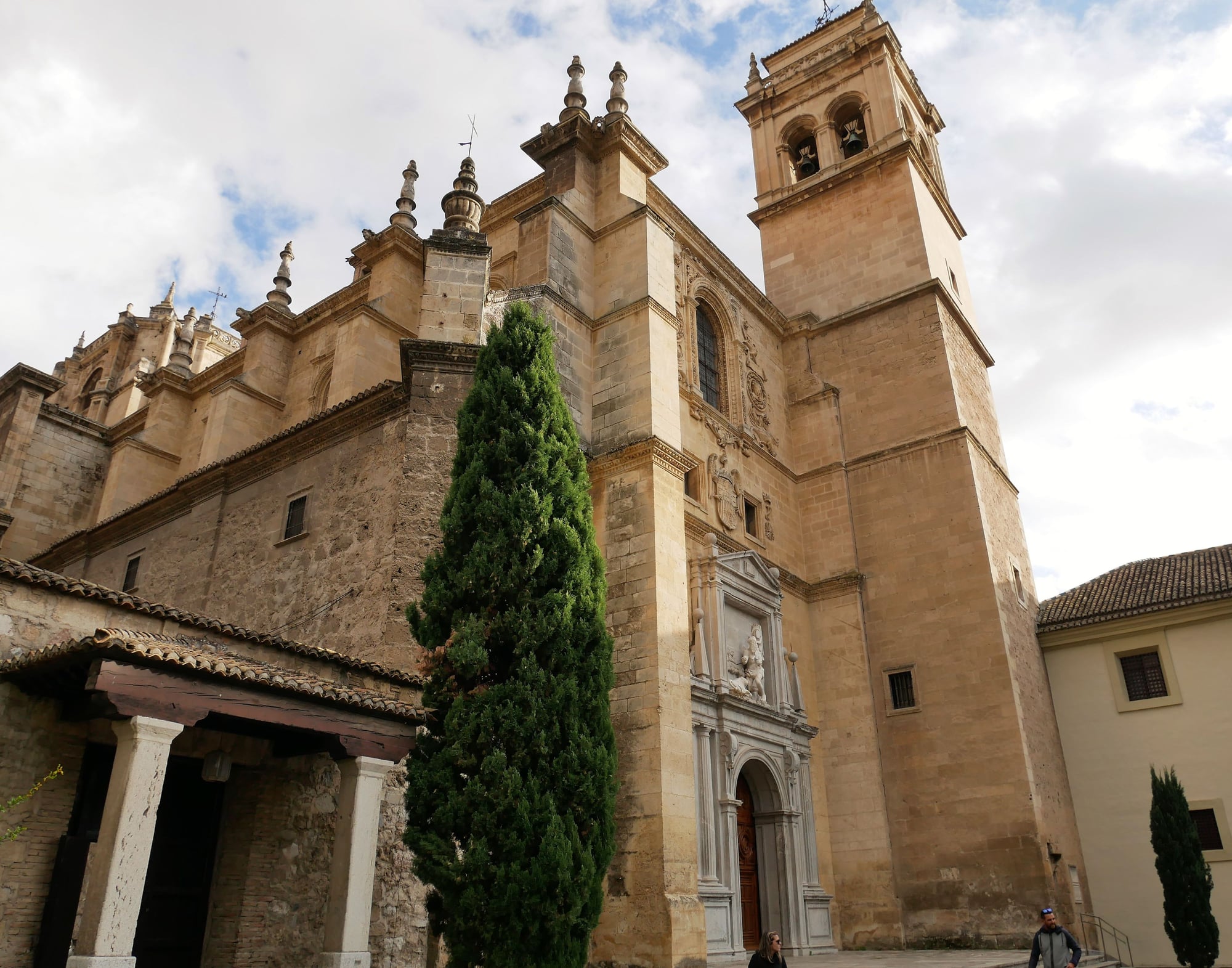
From Gothic to Renaissance, Monasterio de San Jerónimo.
At nighttime we stroll through the historic Albaicín district, which unfolds its narrow streets and whitewashed houses all over the hillside just opposite the Alhambra castle and palace.
In the 13th century, during the Nasrid kingdom, this was home to the Muslim population, alongside with Realejo, the Jewish quarter. At that time the area housed more than 40,000 people, and about 30 mosques.
Granada and Alhambra was in fact the last stronghold of the Nasrid’s kingdom on the Iberian peninsula.
After the Reconquista (1942), all Muslims were first banished, then expelled, later all the Jews too were expelled (under the Edict of Expulsion, knowing that most converts where practicing their religion secretly, and to eliminate their influence).
The Catholic’s; Isabella I (canonized by the pope in 1974, she was made the “Servant of God”) and Ferdinand II, soon began their spiritual unification of Spain and along the way making the Inquisition institutionalized,
preading the faith of Catholicism all over the Old World and New World, by financing Christopher Columbus voyage.
Like a last insult, all mosques in the Albaicín district were soon demolished, and churches were raised on the spot. But the Moorish legacy is still very much alive and visible today, wandering around the narrow streets, alleys and passages,
stumble upon dozen of Arabic tea houses, places that sells Arabic sweets and the sound of foreign tongue that is Arabic, is still very much alive and heard on every street corner.
Back at the hotel restaurant I go for a overpriced, at best mediocre meal, with likewise service.
It been a long rewarding day, and tomorrow I will explore “the Moorish jewel”, the finest example of Islamic architecture, – UNESCO World Heritage Site, and wonder of the world; The Alhambra.
To be continued…
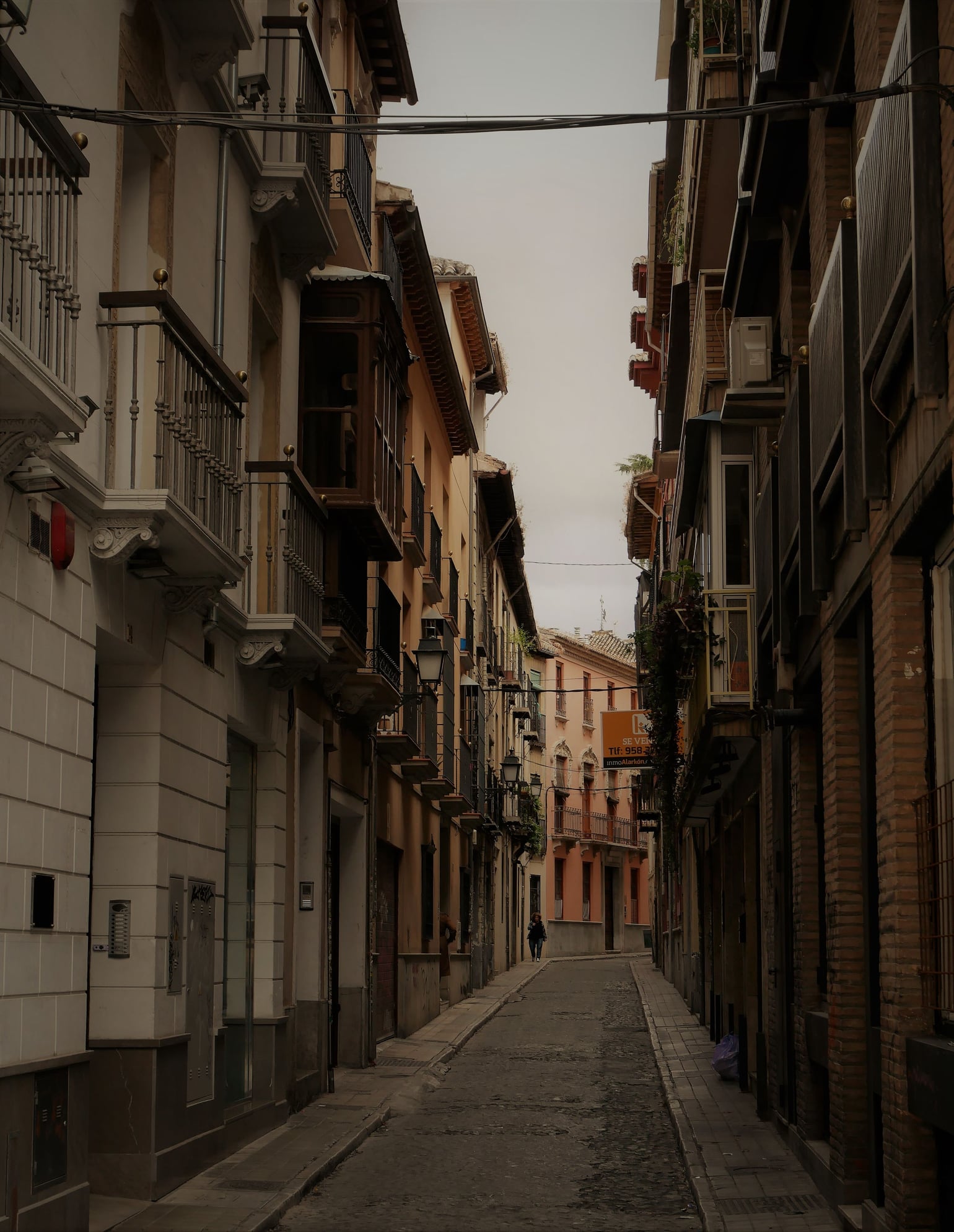
Streets of Granada.

Touristy stuff for sale.
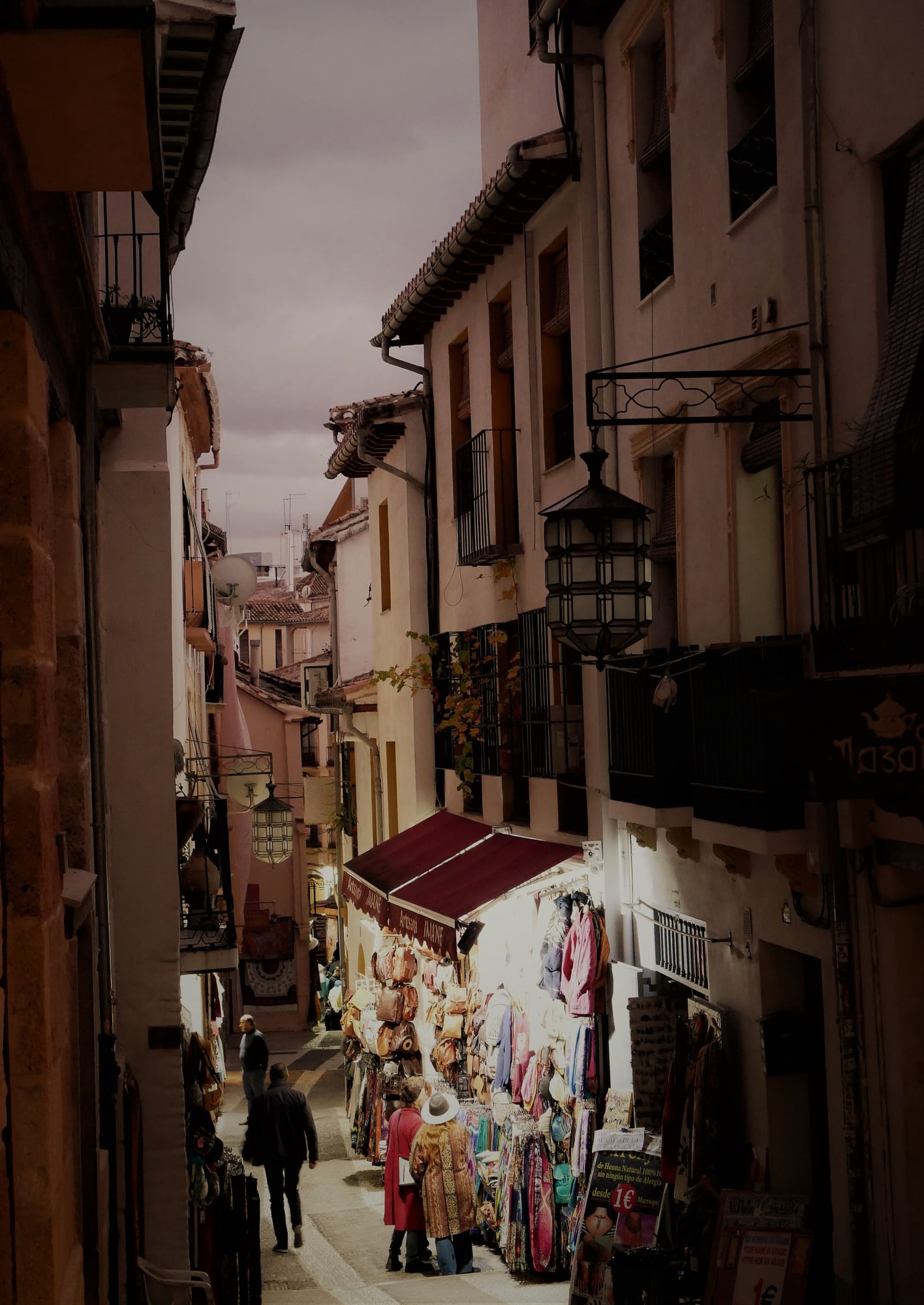
Albaicin district.

Albaicin district.

Albaicin district.
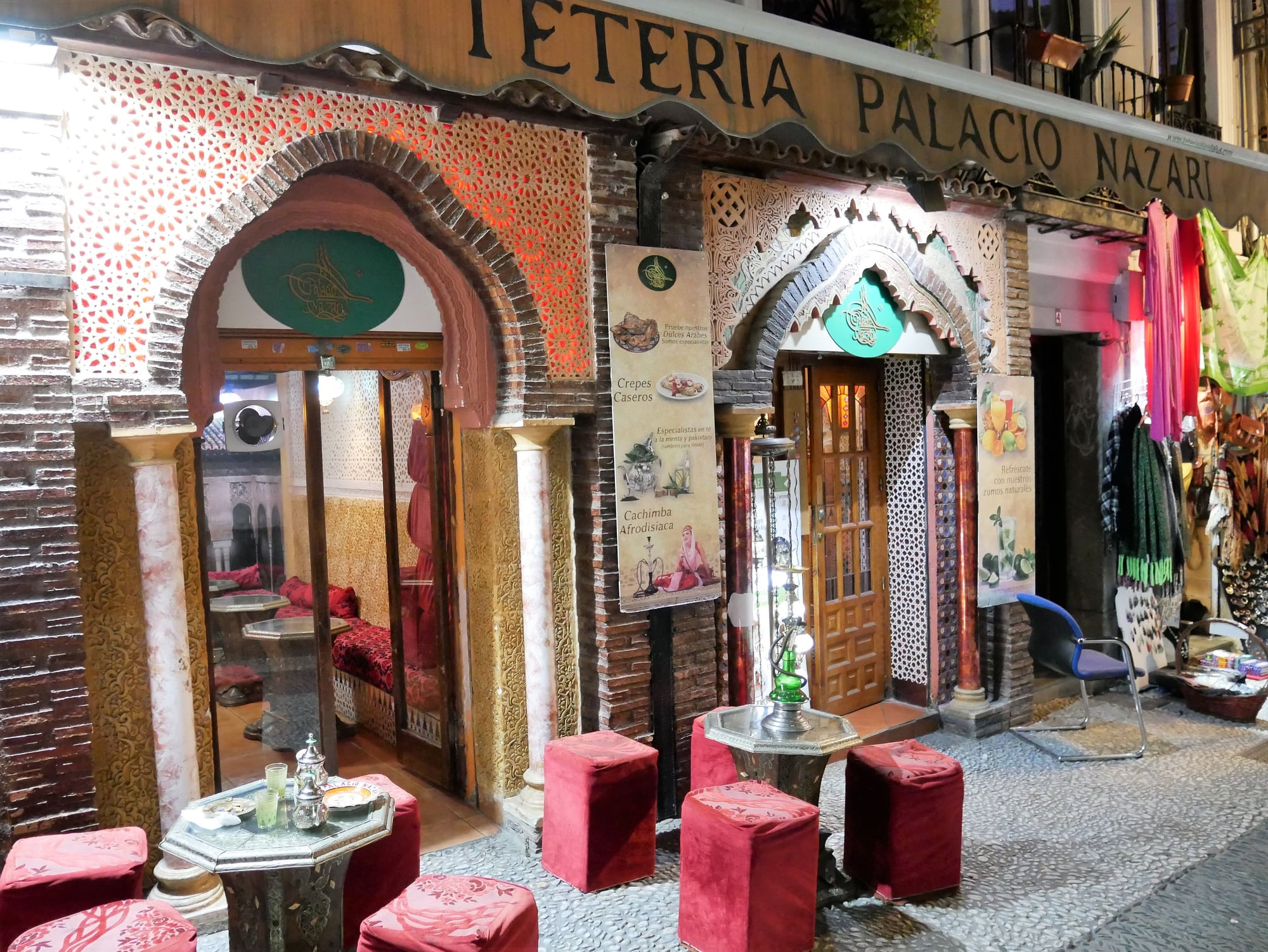
Traditional Tea House. Albaicin district.
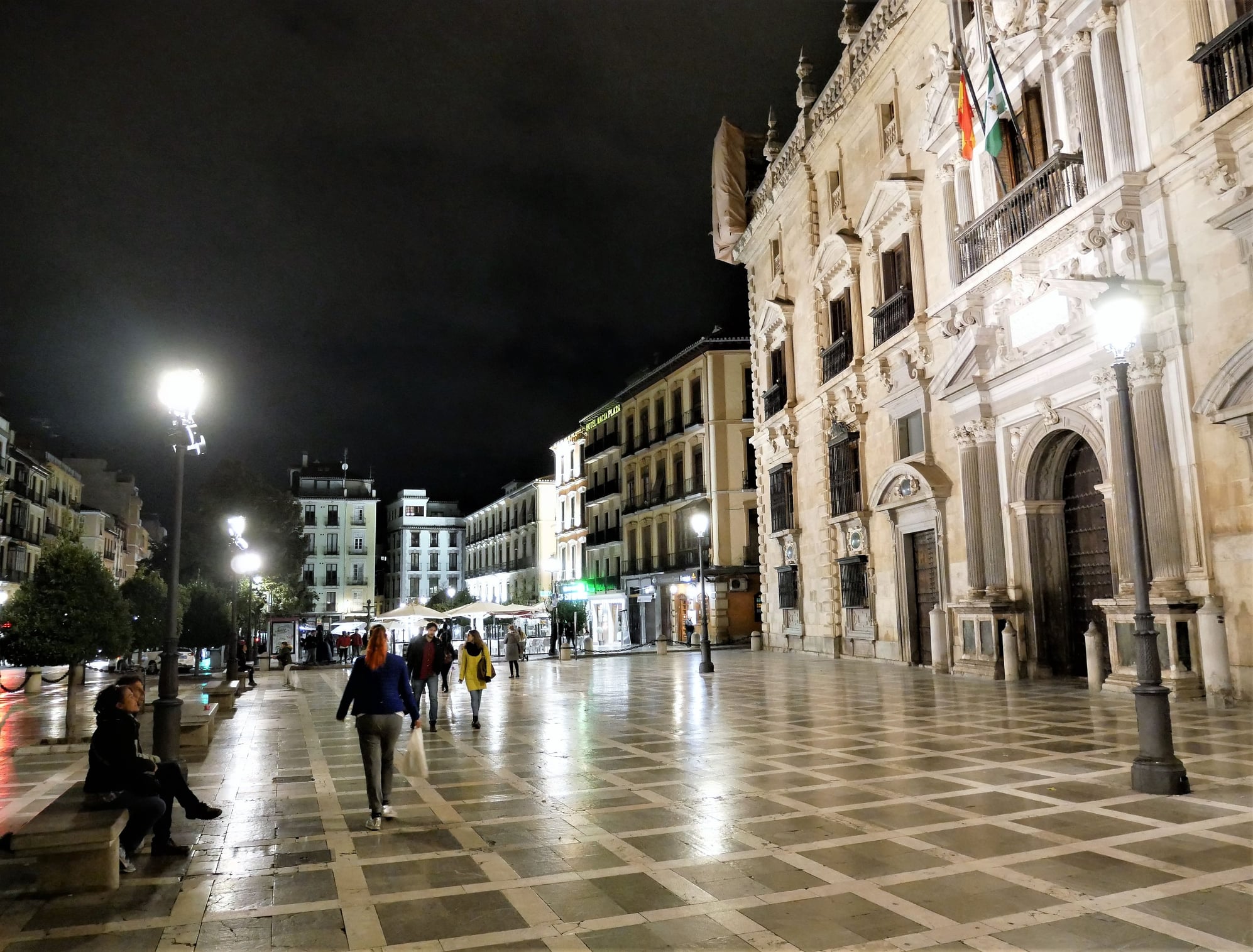
Plaza Nueva.
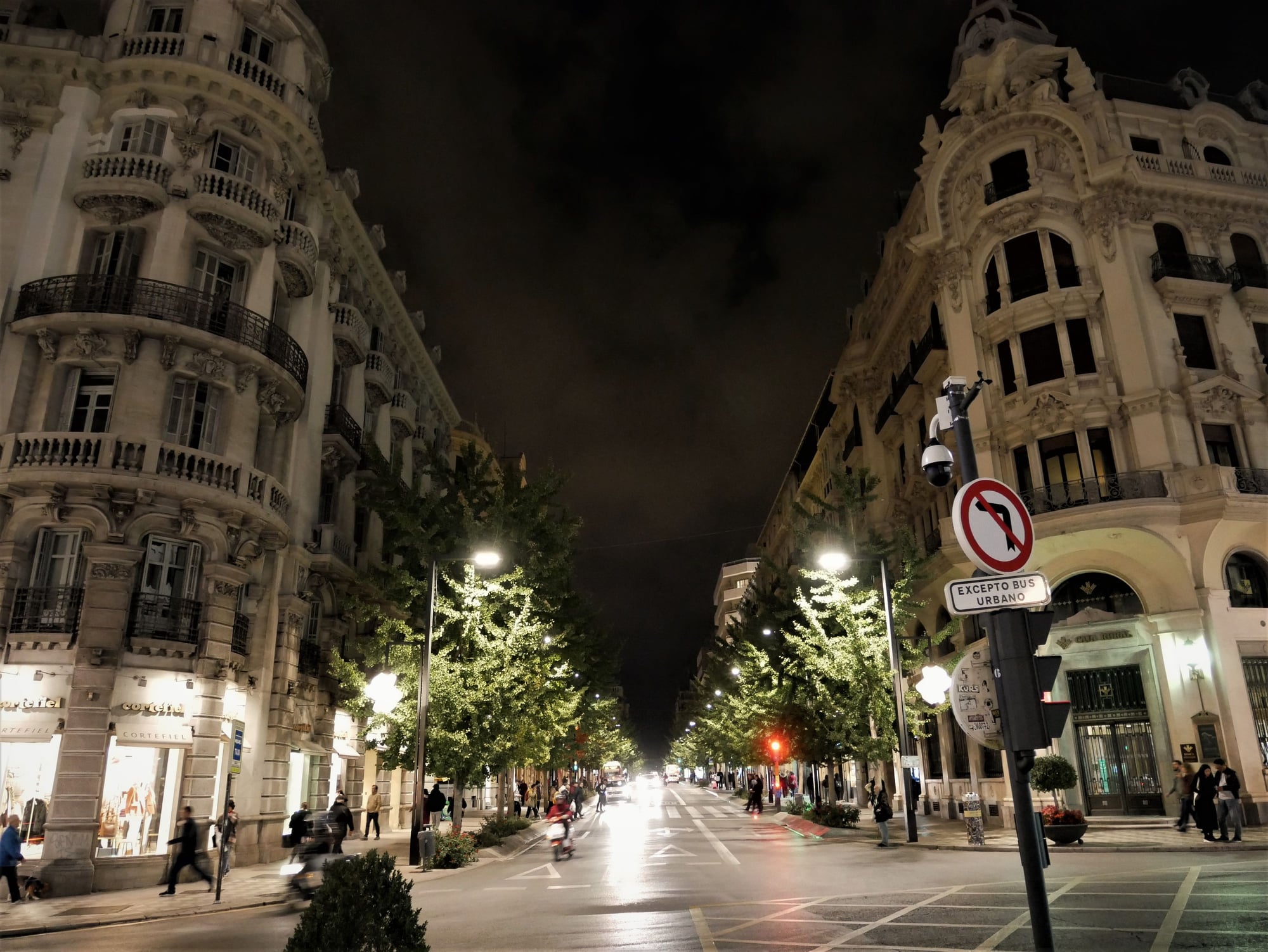
Calle Reyes Catolicos (Street of Catholic Kings).
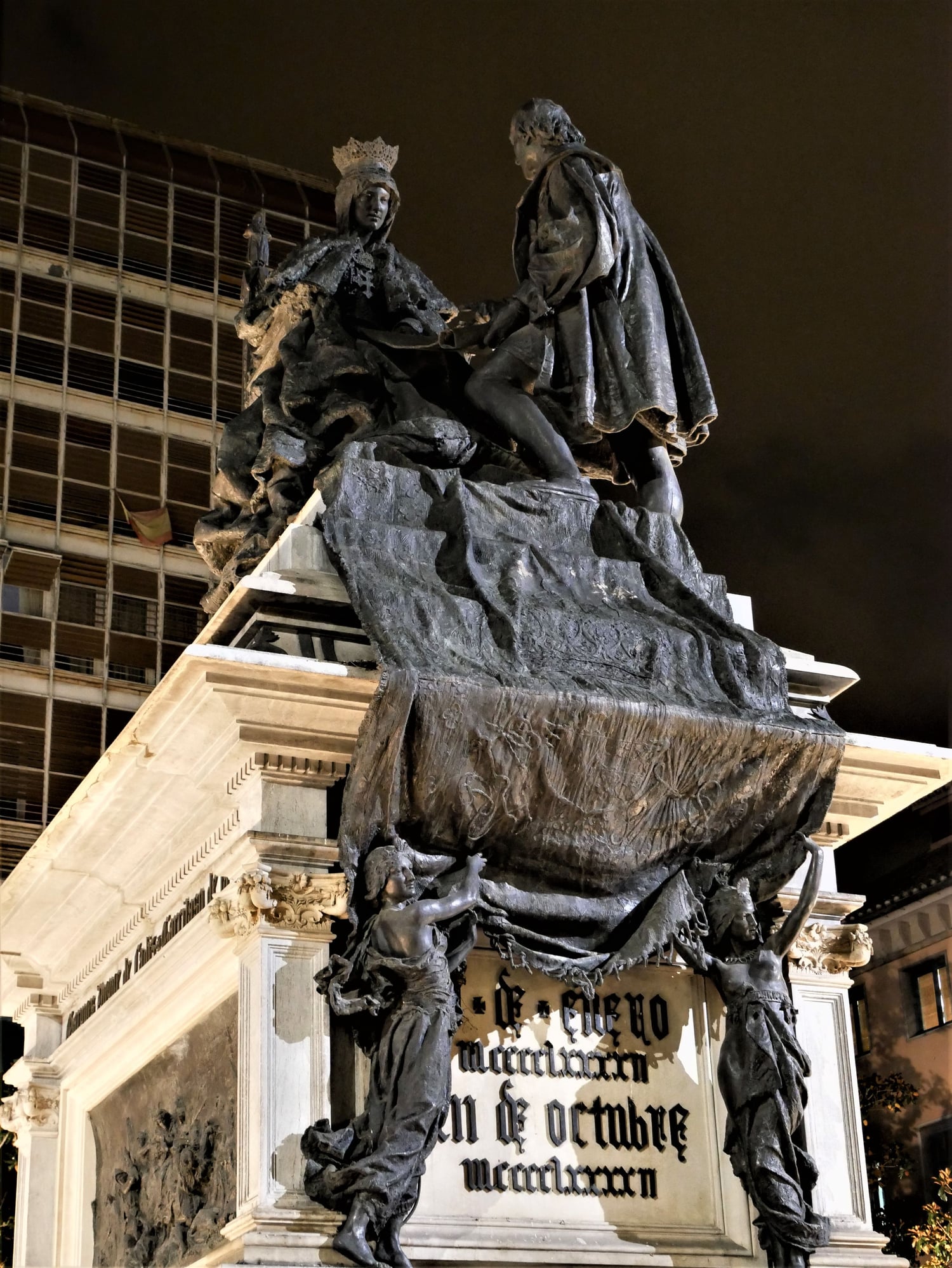
Queen Isabel with Columbus. Plaza Isabel la Catolica.
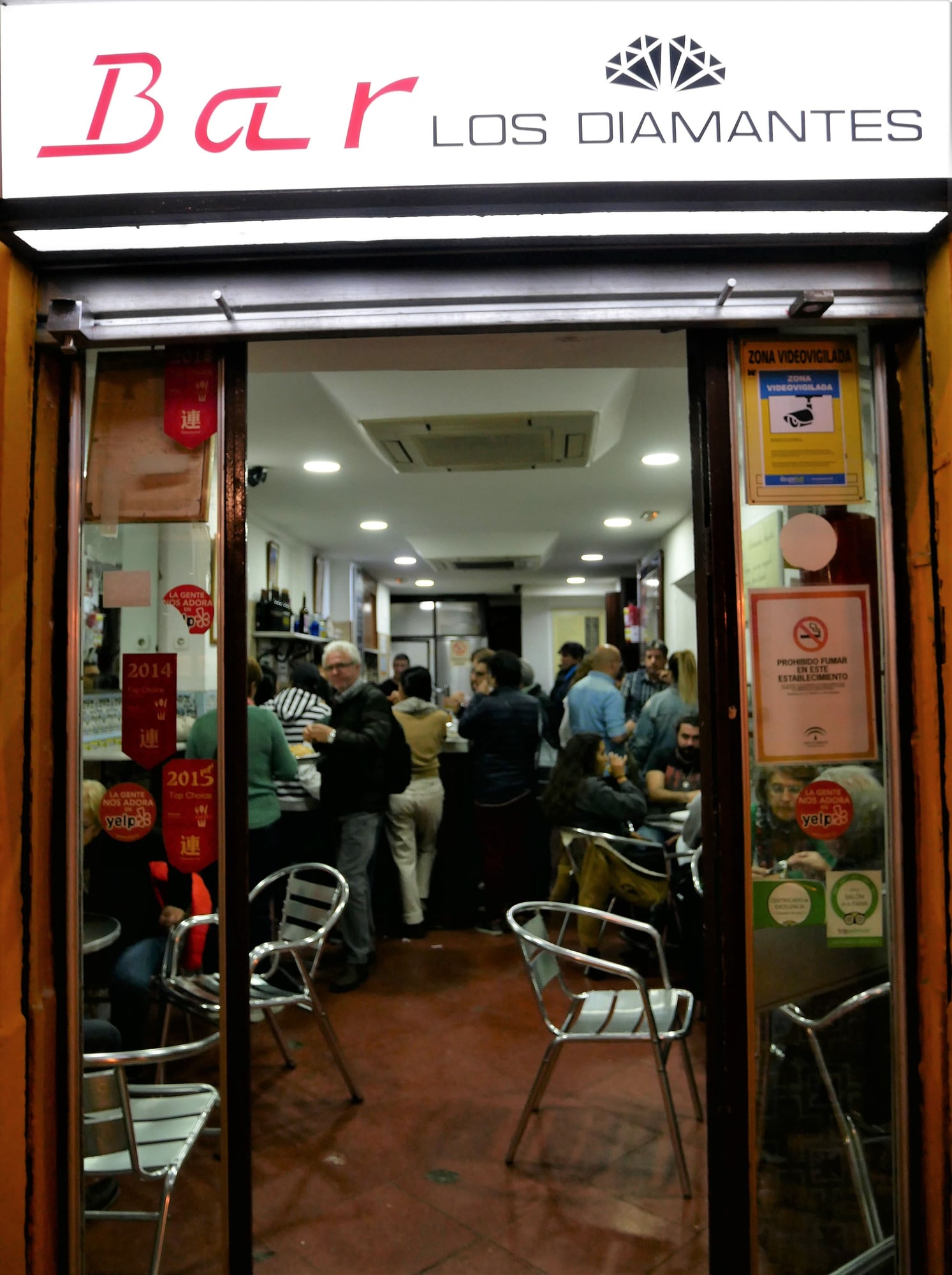
Tapas.
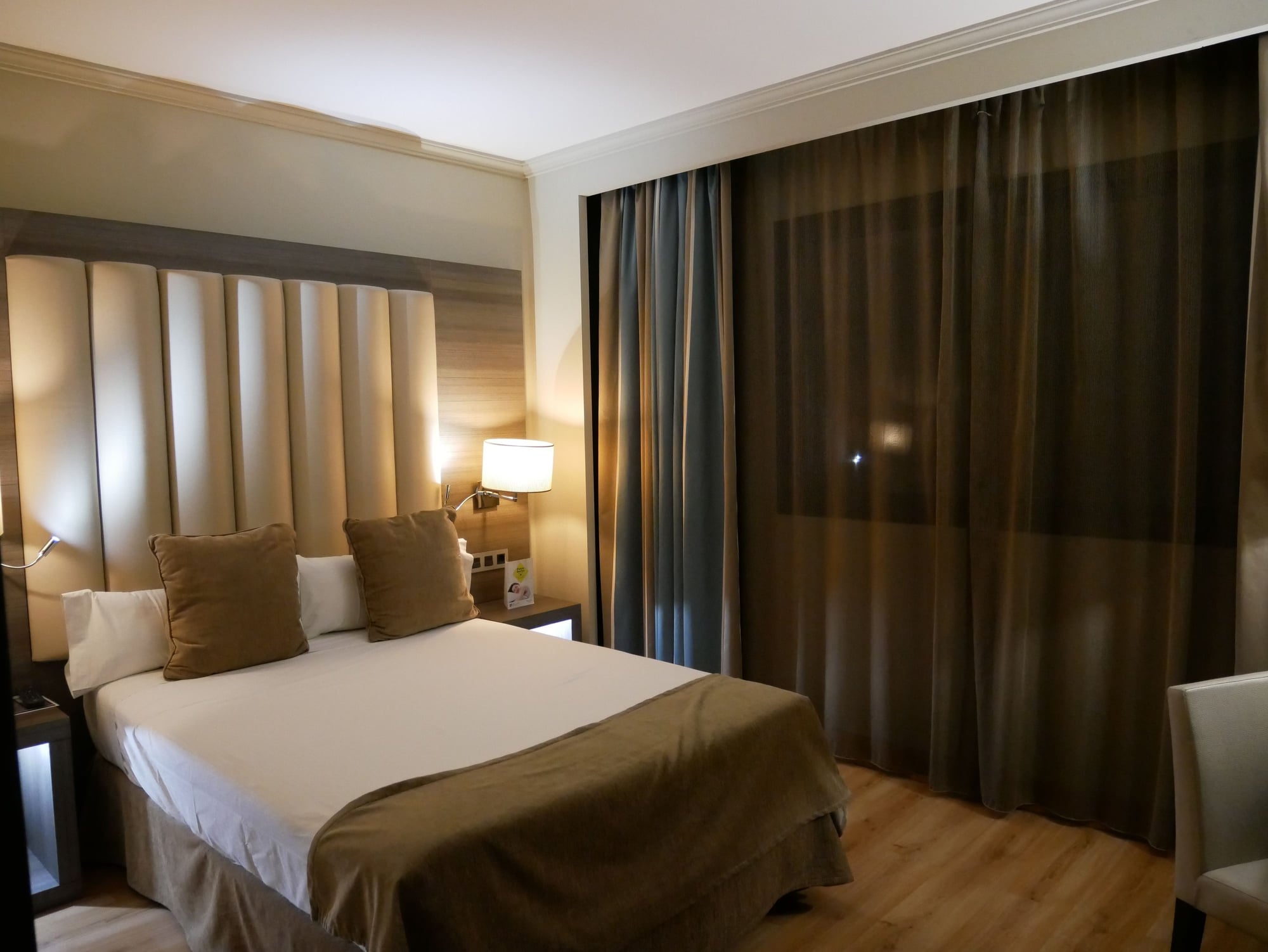
Sercotel Gran Hotel Luna De Granada.
A Trip to Romania and Moldova (September 2019)
Background for this trip was to do a short visit the old folks, and at the same time get a chance to gaze upon the marvel that Alhambra is.
Travel Day # 01
Departure BGO – AMS - ALC.

Travel itinerary.

Travel itinerary - Bus and car.
Bergen, (Flesland Airport)
Amsterdam, (Schiphol Airport)
KL1188 Operated by KLM - Aircraft type: Embraer 190
Travel class: Economy Class
10:00 – 11:45.
Transfertime: 01h40
Amsterdam, (Schiphol Airport)
Alicante, (Alicante Elche Airport)
KL1509 Operated by KLM - Aircraft type: Boeing 737-700
Travel class: Economy Class
13:25 – 16:05.
The journey started with an early wake up, getting to the airport with bus and tram connections.
Arriving 8:40, I went straight for the baggage drop off, before proceeding through the Fasttrack.
Had a coffee before boarding started at 09:30, with self-scanning for priority passengers (that’s a new one for me). Unfortunately there is no lounge for SkyTeam members at BGO Flesland airport.
Since it was a full flight, everybody was offered free check inn for carry-ons luggage to final destination (this seems to be a very common issue on Bgo – Ams / Ams – Bgo flights).
By 09:45 boarding was complete, and we where cleared for take off soon after. Flight time was set to 1hour 25 minutes. Service was the usual small piece of cake, a coffee/tea and drink/water/beer.
At 11:20 we touched down at grey and rainy Amsterdam Schiphol airport.
Bus to gate today.
KLM Crown Lounge (Schengen side) was super crowded and busy, as always at this time.
Food and drinks selection were okay.
The KL1509 flight started priority boarding at 13:00, but we ended up being delayed some 10-15 minutes because of no-show and had to offload the baggage.
Flight time was set to 2hours and 20 minutes today on this full flight.
Not long after air born a warm pasta dish was served with beverage and coffee/tea.
We touched down at 16:10.
Alicante airport being pretty straight forward, no fuzz, and I found my self outside the terminal in a couple of minutes in good time for catching the 17:00 o’clock bus departure to
Torrevieja’s main bus terminal (7€uros, about 50 minutes ride), where I was picked-up and went straight for Orhiuela Costa where I stayed the night.

The new Terminal Bergen Flesland Airport, opened Arpil 2017. BGO is the second largest airport in Norway.

Departures&Arrivals.

Inside the new Terminal. BGO.

Atlantic Airways, the national airline of the Faroe Islands.

Kl1509. Boeing 737-700. Amsterdam.

Approaching Alicante.

On the road.

Lunchbreak, halfway. - Hotel Restaurante Casa Lorenzo.

Scenery.
Travel Day # 2
Orhiuela to Granada.
It is roughly 317 kilometers to Granada from Orhiuela, making for a 3-3.5 hour drive by car, so we set off after having breakfast, at around 10:15.
It’s a nice journey heading south-east on A7, passing by fertile Murcia region, city of Lorca and small time Baza, making a stop along the way for some lunch.
The landscape changes drastically along the way, from flat fields with orange and lemon trees, palm trees and the beautiful sunny coastline, to more barren, dried, scarce soil, then again to flat fruitful tablelands
ith high slim trees looking like spires, shooting towards the sky, green bushes and more colorful trees and pine trees densely dotted around the landscape. In the south- east, the snowcapped Sierra Nevada (meaning snow mountains),
Spain’s highest mountain range, forms a natural barrier, almost like a wall.
The temperature drops (13c-15c) noticeable as we push further into the Andalucia region, it’s also windier in this part of the country, making it feel a bit colder.
The Andalucia, or Al-Andalus, as it was called during the Muslim’s almost 800 years rule (711-1492) in the Iberian Peninsula, is a part of Spain that is rich in culture and history.
Great cities like Cadiz, Cordoba, Malaga and Sevilla are all located here.
At around 14:30 we arrive at Sercotel Gran Hotel Luna de Granada, our stay for the next two days.
The hotel is located conveniently right outside the city center, making it easy to get to without having to make your way through small confusing streets and narrow alleys full of traffic.
Check inn is fast, room is of good size; big bed, overpriced minibar, tv and a big bathroom.
Unfortunately, the view is equivalent to looking straight at a brick wall.
We decide to have a wander around in the vicinity, and we soon stumble upon the massive Royal Monastery of San Jeronimo (Real Monasterio de San Jeronimo Granada).
This renaissance and gothic style monastery is the work of Isabella I of Castille and Ferdinand II of Aragon, the Catholics, fiery faith during the time of the Reconquista, work began in 1504.
Empress Isabella of Portugal stayed here for a brief period after her marriage to Charles V, the Holy Roman Emperor (known as Carlos V in Spain).
During the French Napoleon invasion, the church tower where demolished, and the rocks was used to build the Puente Verde bridge over the river Genil for linking parts of the land further outside of the city.
The guardian of the monastery doesn’t seem too interested in selling us entrance tickets (4€) to the monastery, nevertheless, once inside, I am struck by the beautiful gothic artwork, iconographic, sculptures and
the late renaissance altarpiece. This less “known” gem is truly a masterpiece to behold.

Monasterio de San Jerónimo. Construction began 1504.

Gothic ceiling. Monasterio de San Jerónimo.

Jesus and palm-twig, symbol of peace and/or entry to Jerusalem. Monasterio de San Jerónimo.

Altar piece. Monasterio de San Jerónimo.

Sculptures&Paintings. Granadan school of sculpture.

Staircase. Monasterio de San Jerónimo.

Cultural Heritage Site, Monasterio de San Jerónimo.

Details. Monasterio de San Jerónimo.

Cloister yard. Monasterio de San Jerónimo.

The Last supper by Juan de Sevilla Romero (1643 - 1695). Notice there is no knife on the table in this painting, as to da Vinci's, where there is.

From Gothic to Renaissance, Monasterio de San Jerónimo.
At nighttime we stroll through the historic Albaicín district, which unfolds its narrow streets and whitewashed houses all over the hillside just opposite the Alhambra castle and palace.
In the 13th century, during the Nasrid kingdom, this was home to the Muslim population, alongside with Realejo, the Jewish quarter. At that time the area housed more than 40,000 people, and about 30 mosques.
Granada and Alhambra was in fact the last stronghold of the Nasrid’s kingdom on the Iberian peninsula.
After the Reconquista (1942), all Muslims were first banished, then expelled, later all the Jews too were expelled (under the Edict of Expulsion, knowing that most converts where practicing their religion secretly, and to eliminate their influence).
The Catholic’s; Isabella I (canonized by the pope in 1974, she was made the “Servant of God”) and Ferdinand II, soon began their spiritual unification of Spain and along the way making the Inquisition institutionalized,
preading the faith of Catholicism all over the Old World and New World, by financing Christopher Columbus voyage.
Like a last insult, all mosques in the Albaicín district were soon demolished, and churches were raised on the spot. But the Moorish legacy is still very much alive and visible today, wandering around the narrow streets, alleys and passages,
stumble upon dozen of Arabic tea houses, places that sells Arabic sweets and the sound of foreign tongue that is Arabic, is still very much alive and heard on every street corner.
Back at the hotel restaurant I go for a overpriced, at best mediocre meal, with likewise service.
It been a long rewarding day, and tomorrow I will explore “the Moorish jewel”, the finest example of Islamic architecture, – UNESCO World Heritage Site, and wonder of the world; The Alhambra.
To be continued…

Streets of Granada.

Touristy stuff for sale.

Albaicin district.

Albaicin district.

Albaicin district.

Traditional Tea House. Albaicin district.

Plaza Nueva.

Calle Reyes Catolicos (Street of Catholic Kings).

Queen Isabel with Columbus. Plaza Isabel la Catolica.

Tapas.

Sercotel Gran Hotel Luna De Granada.
Last edited by JustGo; Mar 27, 2020 at 12:20 pm Reason: spelling
#2
Original Poster
Join Date: Jan 2019
Programs: Flying Blue Gold, Sas EuroBonus, Thon Hotels Discovery Gold.
Posts: 45
Travel Day #3
The Alhambra.
- Give him alms, woman, because there is nothing sadder in life than being blind in Granada”. Francisco de Icaza - Mexican poet.
For visiting the Alhambra it is advisable to book tickets way in advance; for one, there is only so many tickets available for entrance to the Palaces and the Generalife each day,
second, the fact that it’s the most important, and most visited attraction in Spain all year round.
When I first looked into tickets, almost a month before my planed visit, I could not get entrance tickets for the Palaces, only the Generalife.
Luckily, the day before departure I did check the official website again, and to my surprise there was few tickets available.
For these tickets, “Dobla de Oro general”, which includes the Palaces, the Alcazaba (fortress), the Generalife and a bunch museums and places of importance, I paid €20.84 per Pax.
Wanting to get the most out of the day, since we we’re here only for two nights, we started off early.
After a filling breakfast at the hotel, which had a fairly good selection, we opted for a taxi as we figured it would be the easiest and most time-saving option.
A 15 minute ride from the hotel area, and 8€uros, took us all the way to the entrance point of the Alhambra.
There were hardly any queues at the ticket booths this early, and with the pre-purchased tickets we went straight to the security entrance.
Nearly a cloud on the sky, it was bound to be a great day for exploring by foot.
Already in 711 AD, Muslims troops from North Africa started the conquest of the Iberian Peninsula.
The tenth century saw the Hispanic-Muslim dynasty reaching its peak with the founding of the Caliphate of Cordoba, then later being disintegrated into different kingdoms.
One of these was the kingdom of Granada, which lasted from 1031 until 1492 when the then ruling elite, the Nasrids, abandoned the palace.
Making way for a new era; that of the Catholic Monarchs with their fierce Christian belief.
The first stones for a fortress and palaces were laid in 1238 on the hilltop of Albaicin. Over the course of time new structures and more impressive palaces were raised, which today makes up the Alhambra.
The whole palaces and garden area is spread out over an area measuring 142,000 square meters. Massive. One can easily spend the whole day here wandering around, soaking up all the magnificent sights.
Around every corner there is a deep sublime, heavenly beauty, almost Godly – if ever was such a thing, that is at times difficult to comprehend. Soo you end up drifting from decorative rooms, through colorful gardens and baths,
ajestic palaces and fortes, for hours and hours. Gazing upon frescos, paintings and Qur’anic verses engraved into stones and tiles, walls and ceilings, which you by the way don’t understand a word of.
So much visualization and pleasure for the eyes and soul, but never tiring.
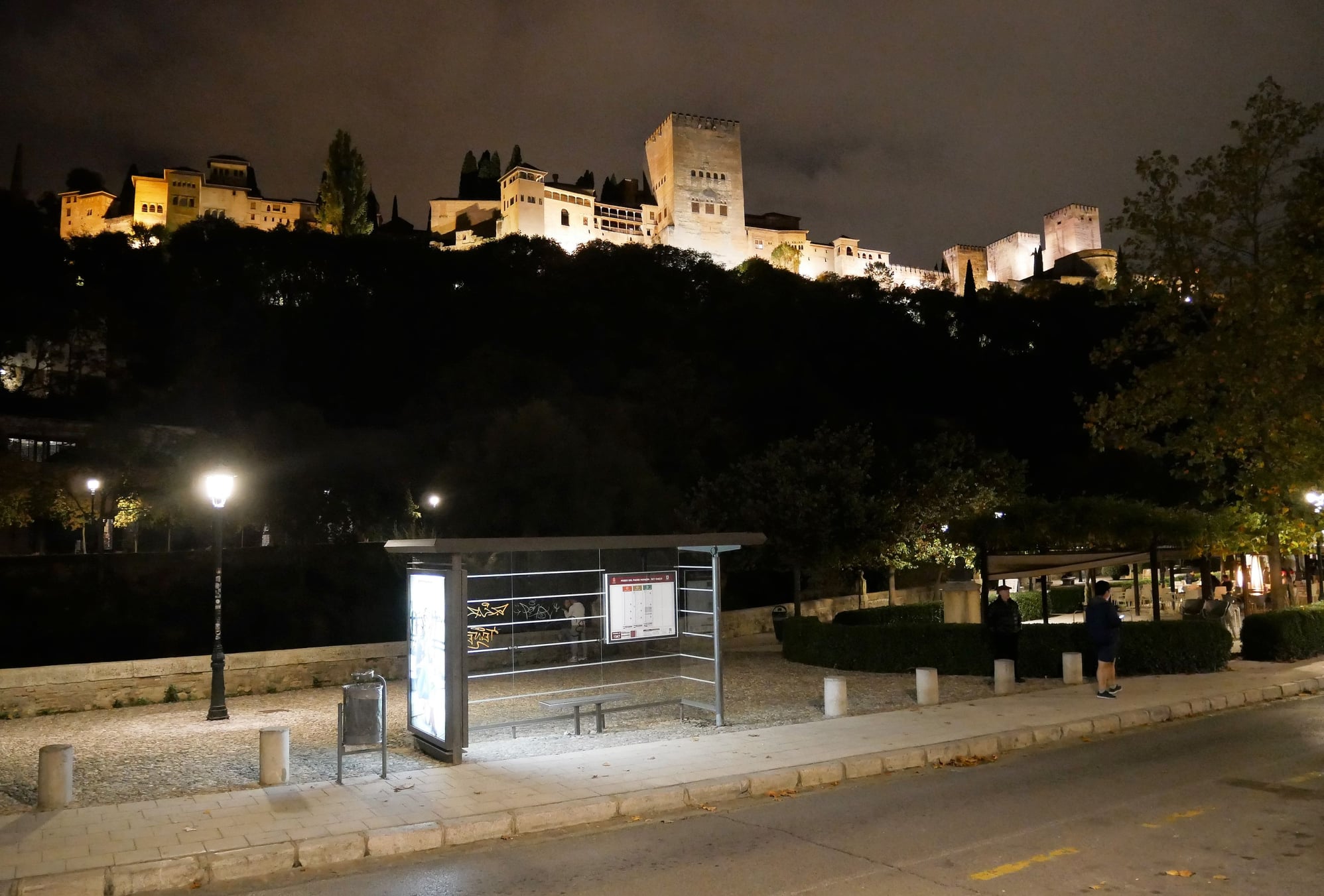
Part of the Alhambra complex form below.

The Medina, a former working class district with houses, baths and workshops.
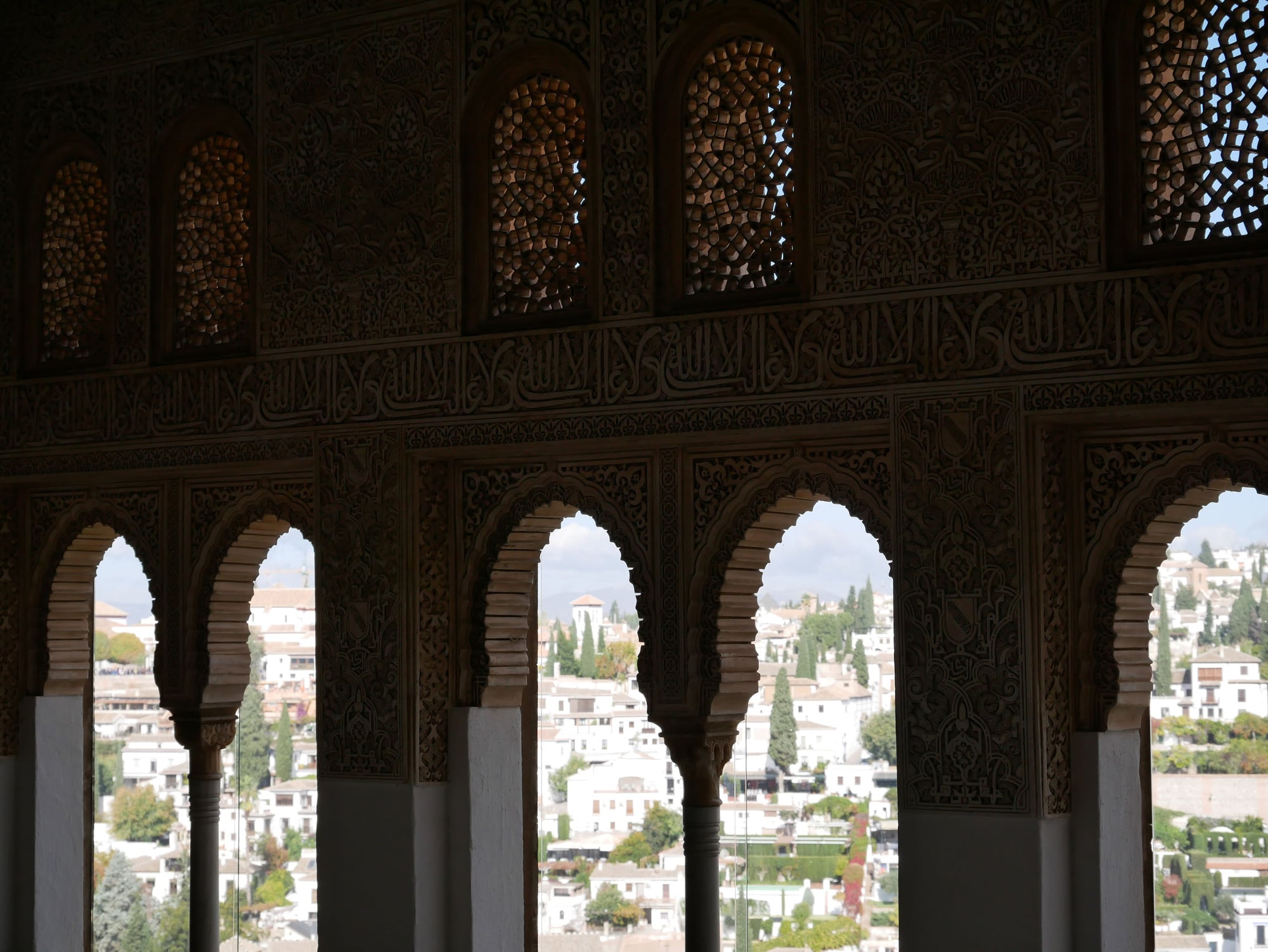
Inscriptions.
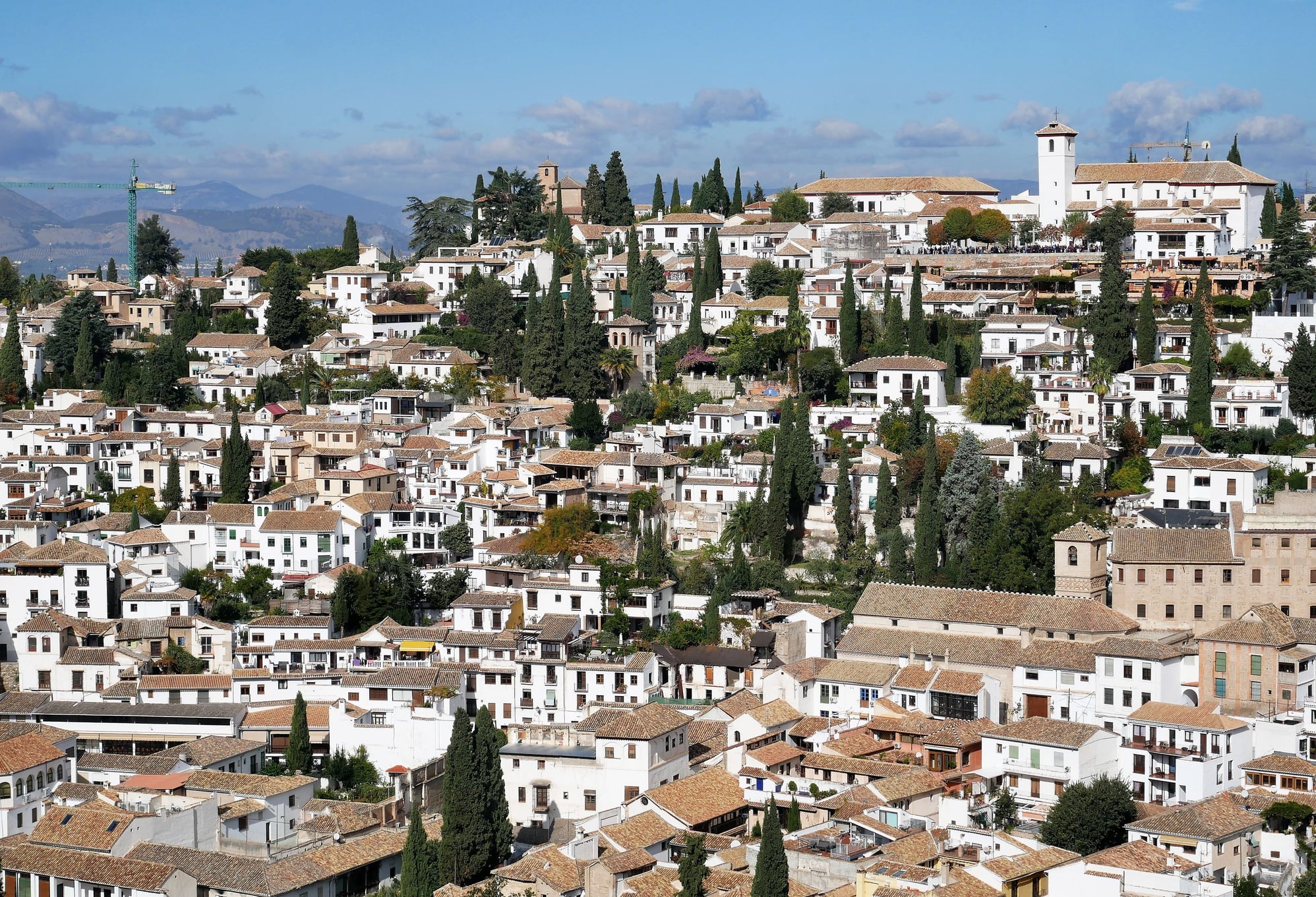
View over the white-washed houses of Albaicin.

Albaicin and parts of the old wall.
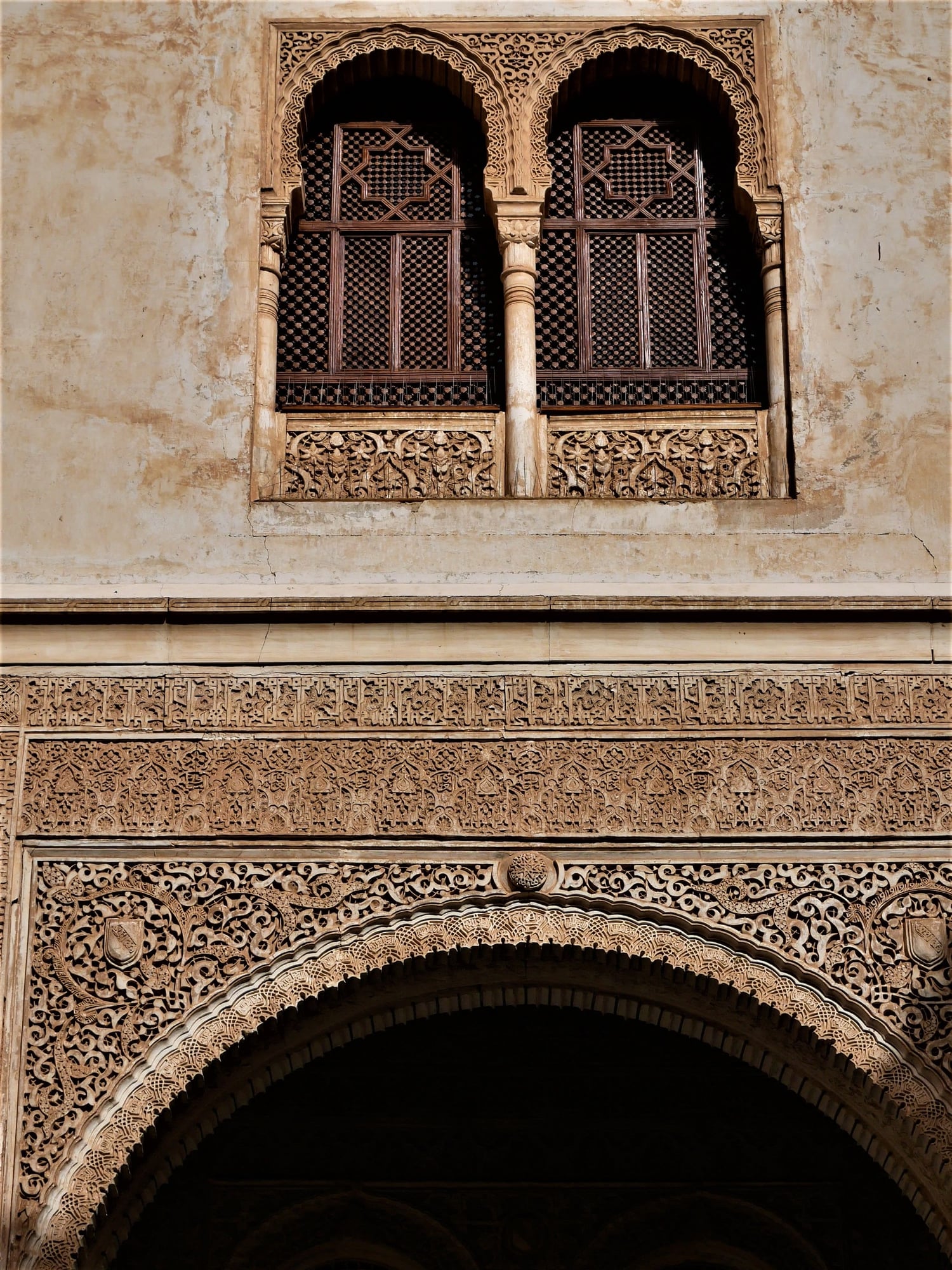
Windows. Framed by plasterwork, the windows used jalousies of geometric design.
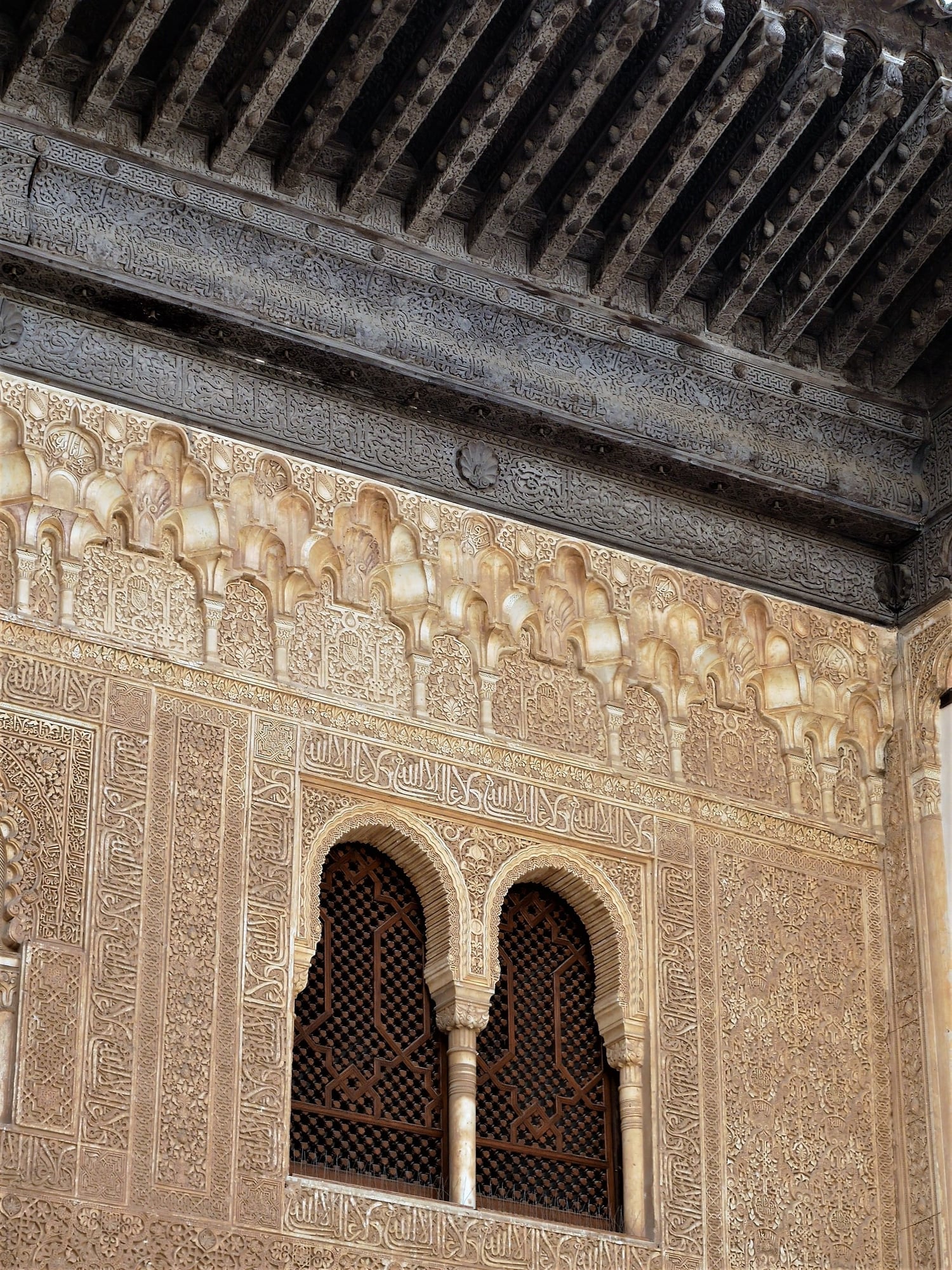
Windows. Nasrid period.
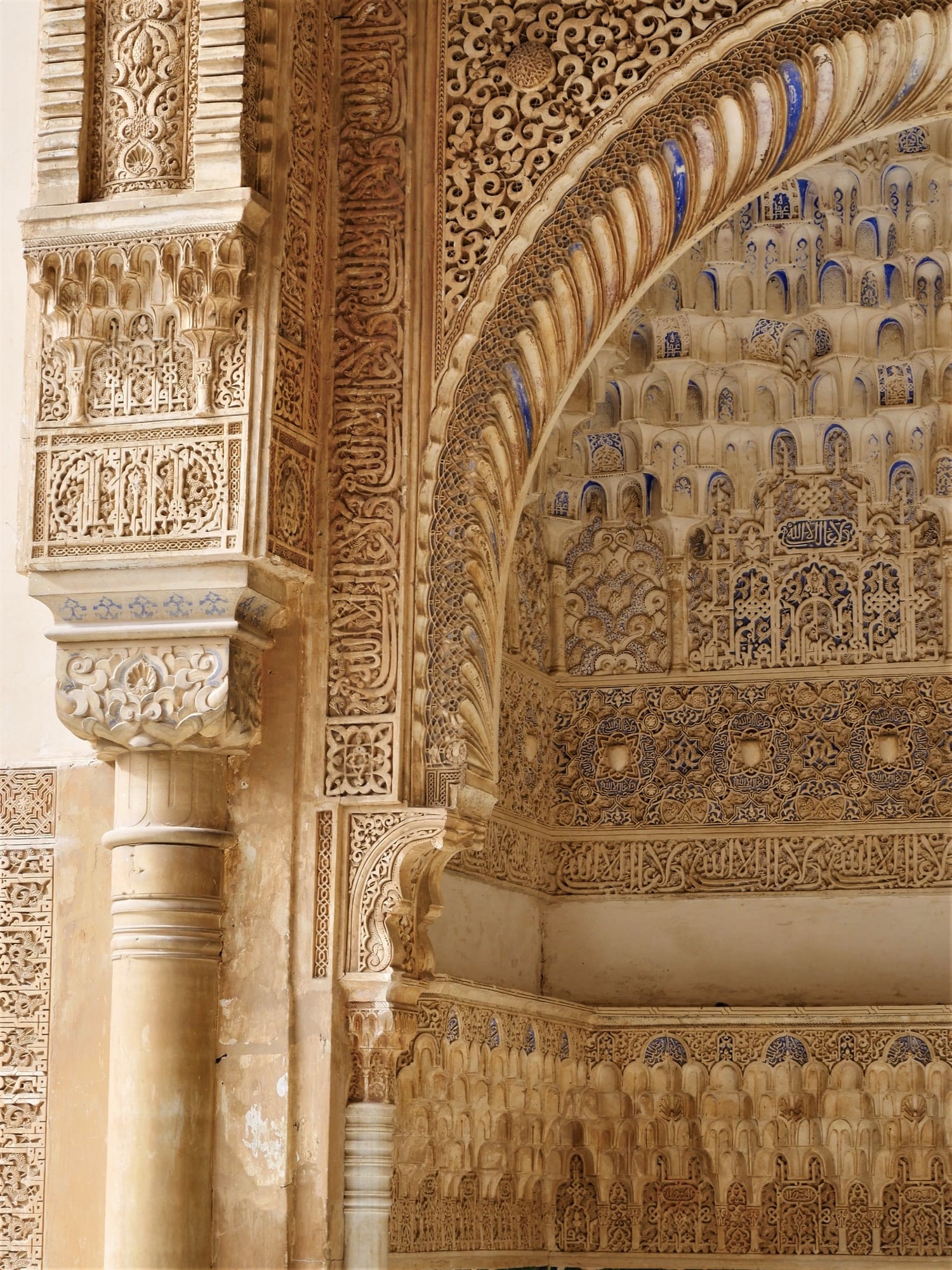
Columns&Inscriptions. Nasrid architectural style.
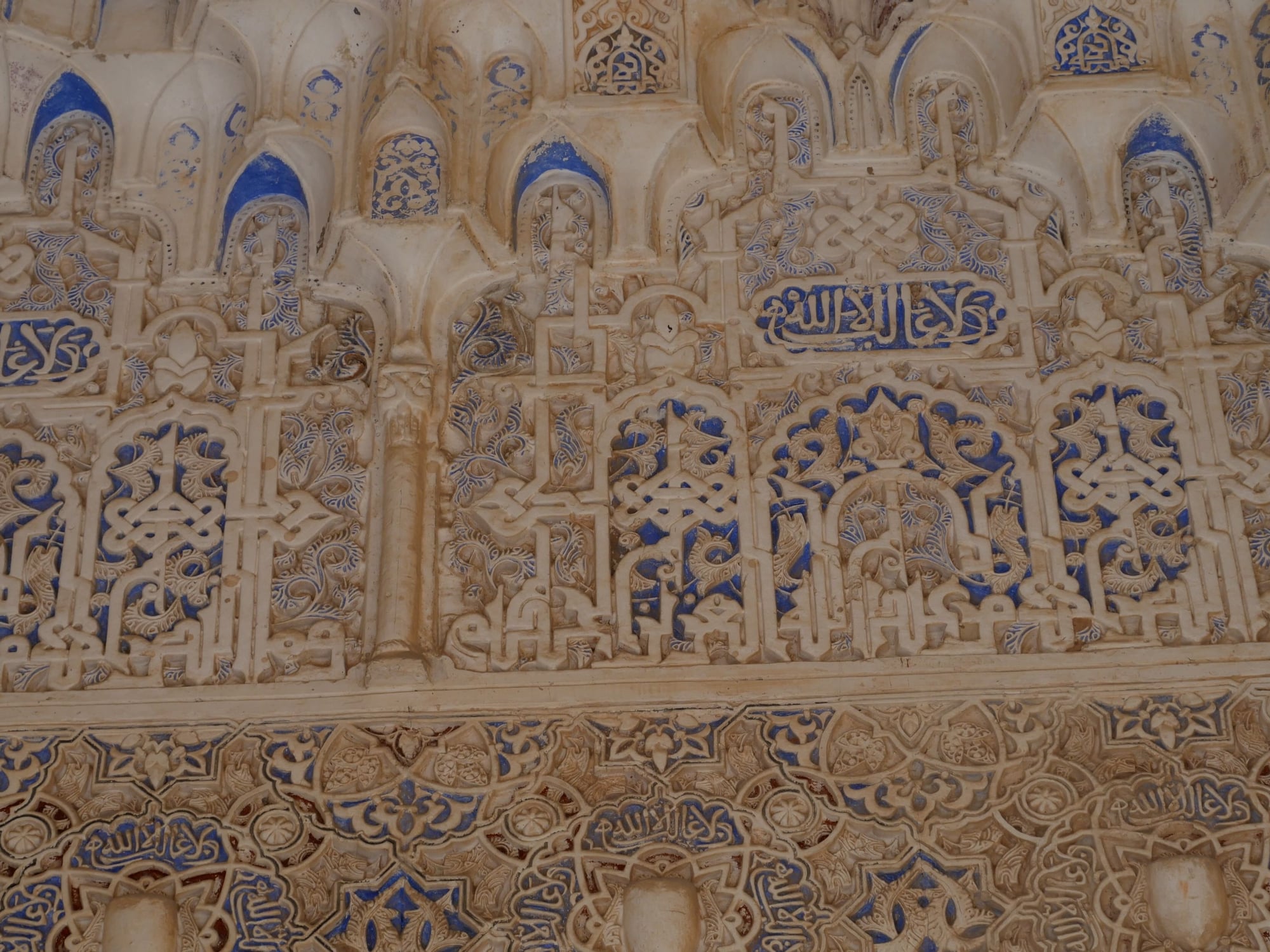
Epigraphs and vegetal details.

Reflections on wall, life and paradise.
The Court of the Myrtles.

The Court of the Myrtles.
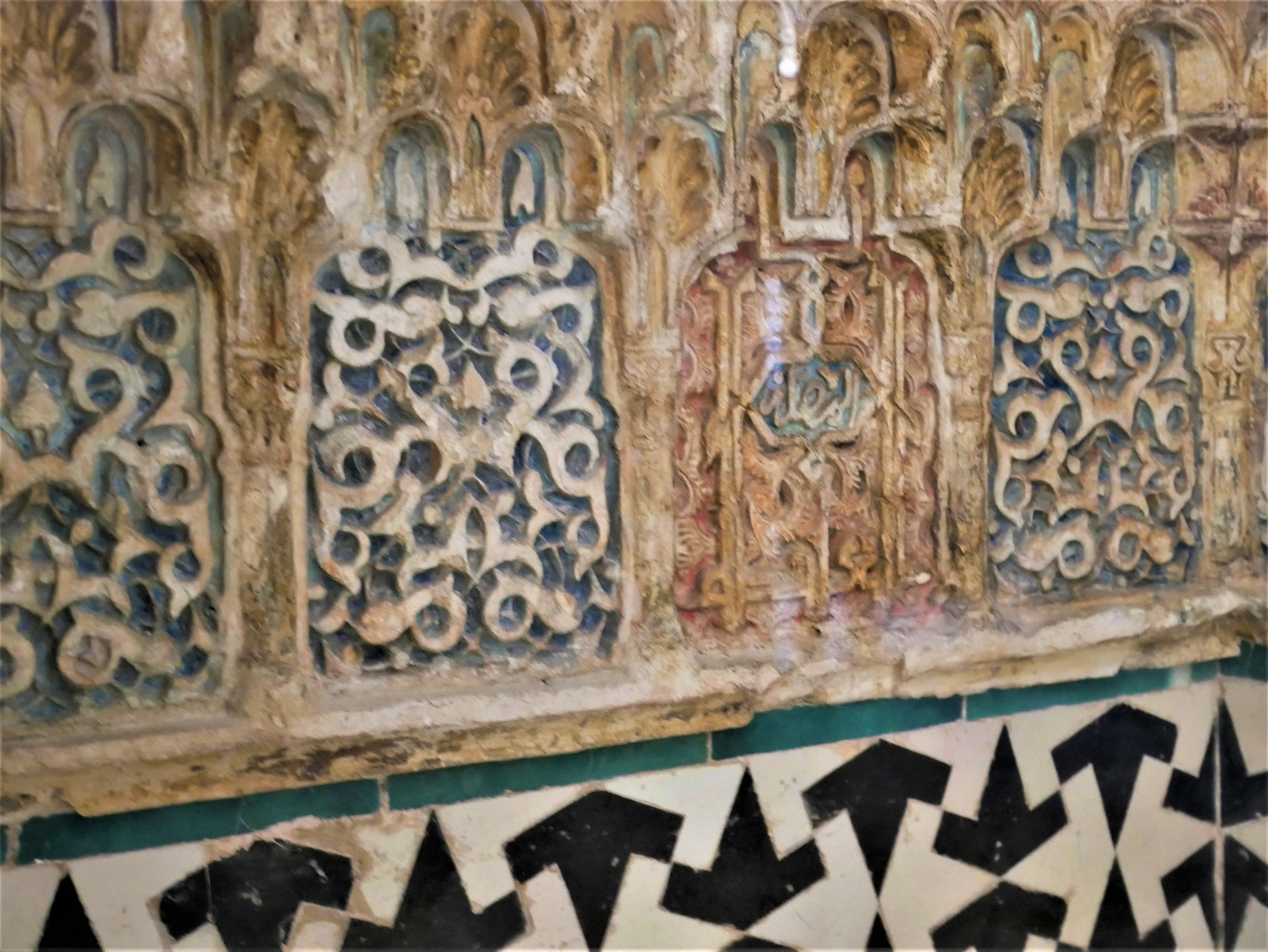
Geometric tilework and designs, associated with the infinite idea of God.

The ceiling composition represent the Seven Heavens, which according to Islamic belief must be crossed before arriving at the throne of God. - The Throne Room.

Alcoves decorated with vibrant titlework and stuccowork.
The Alhambra.
- Give him alms, woman, because there is nothing sadder in life than being blind in Granada”. Francisco de Icaza - Mexican poet.
For visiting the Alhambra it is advisable to book tickets way in advance; for one, there is only so many tickets available for entrance to the Palaces and the Generalife each day,
second, the fact that it’s the most important, and most visited attraction in Spain all year round.
When I first looked into tickets, almost a month before my planed visit, I could not get entrance tickets for the Palaces, only the Generalife.
Luckily, the day before departure I did check the official website again, and to my surprise there was few tickets available.
For these tickets, “Dobla de Oro general”, which includes the Palaces, the Alcazaba (fortress), the Generalife and a bunch museums and places of importance, I paid €20.84 per Pax.
Wanting to get the most out of the day, since we we’re here only for two nights, we started off early.
After a filling breakfast at the hotel, which had a fairly good selection, we opted for a taxi as we figured it would be the easiest and most time-saving option.
A 15 minute ride from the hotel area, and 8€uros, took us all the way to the entrance point of the Alhambra.
There were hardly any queues at the ticket booths this early, and with the pre-purchased tickets we went straight to the security entrance.
Nearly a cloud on the sky, it was bound to be a great day for exploring by foot.
Already in 711 AD, Muslims troops from North Africa started the conquest of the Iberian Peninsula.
The tenth century saw the Hispanic-Muslim dynasty reaching its peak with the founding of the Caliphate of Cordoba, then later being disintegrated into different kingdoms.
One of these was the kingdom of Granada, which lasted from 1031 until 1492 when the then ruling elite, the Nasrids, abandoned the palace.
Making way for a new era; that of the Catholic Monarchs with their fierce Christian belief.
The first stones for a fortress and palaces were laid in 1238 on the hilltop of Albaicin. Over the course of time new structures and more impressive palaces were raised, which today makes up the Alhambra.
The whole palaces and garden area is spread out over an area measuring 142,000 square meters. Massive. One can easily spend the whole day here wandering around, soaking up all the magnificent sights.
Around every corner there is a deep sublime, heavenly beauty, almost Godly – if ever was such a thing, that is at times difficult to comprehend. Soo you end up drifting from decorative rooms, through colorful gardens and baths,
ajestic palaces and fortes, for hours and hours. Gazing upon frescos, paintings and Qur’anic verses engraved into stones and tiles, walls and ceilings, which you by the way don’t understand a word of.
So much visualization and pleasure for the eyes and soul, but never tiring.

Part of the Alhambra complex form below.

The Medina, a former working class district with houses, baths and workshops.

Inscriptions.

View over the white-washed houses of Albaicin.

Albaicin and parts of the old wall.

Windows. Framed by plasterwork, the windows used jalousies of geometric design.

Windows. Nasrid period.

Columns&Inscriptions. Nasrid architectural style.

Epigraphs and vegetal details.

Reflections on wall, life and paradise.
The Court of the Myrtles.

The Court of the Myrtles.

Geometric tilework and designs, associated with the infinite idea of God.

The ceiling composition represent the Seven Heavens, which according to Islamic belief must be crossed before arriving at the throne of God. - The Throne Room.

Alcoves decorated with vibrant titlework and stuccowork.
#3
Original Poster
Join Date: Jan 2019
Programs: Flying Blue Gold, Sas EuroBonus, Thon Hotels Discovery Gold.
Posts: 45
Some more pictures of Alhambra.
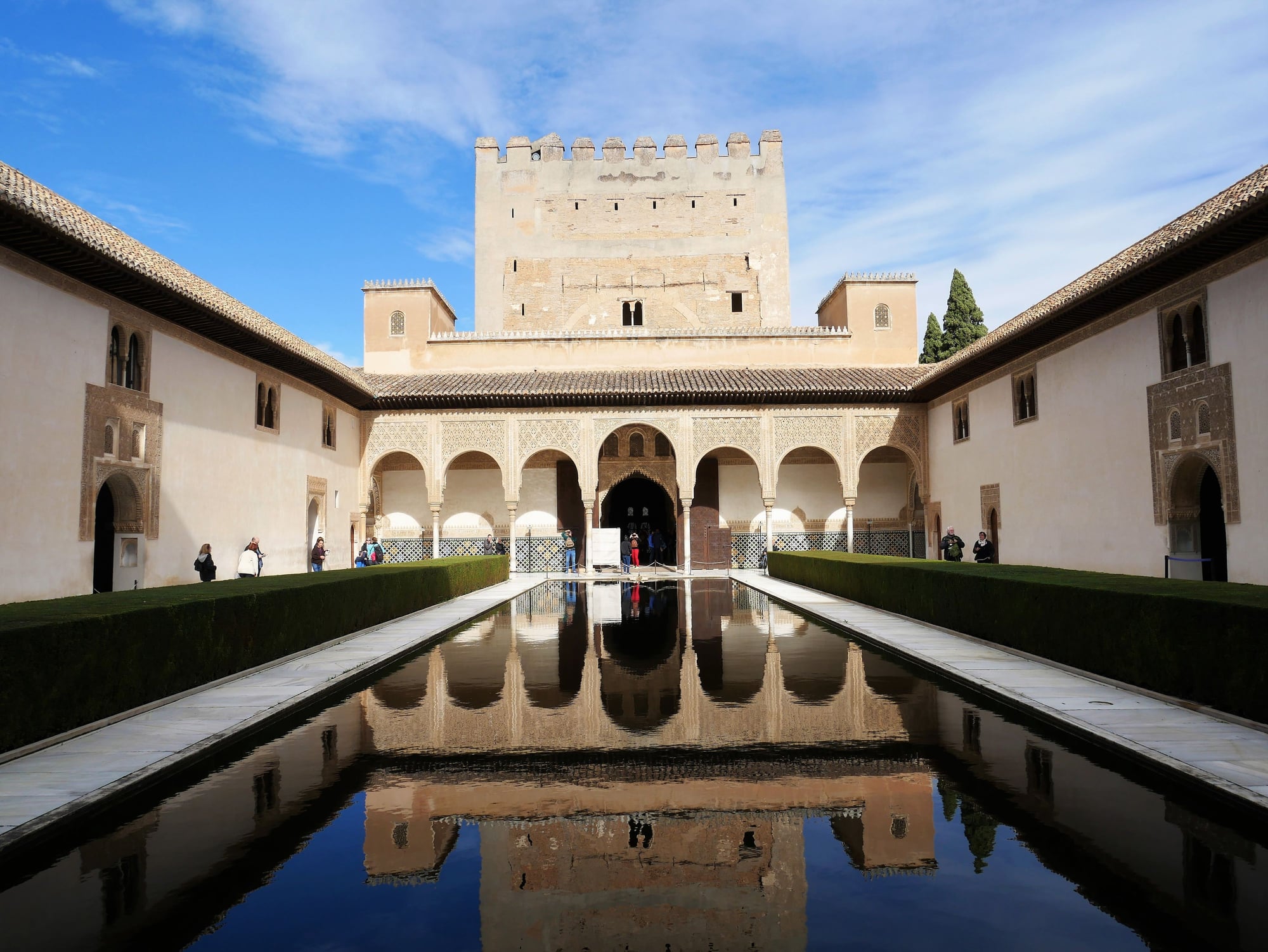
Courtyard. Entrance to the Throne Room and the monumental Comares Tower. - The Court of Myrtles.

The alcoves originally contained glasses of water, they also might have held perfumes or flowers.

Inscriptions . The Nasrid kingdom's motto was; "There is no victor but God".
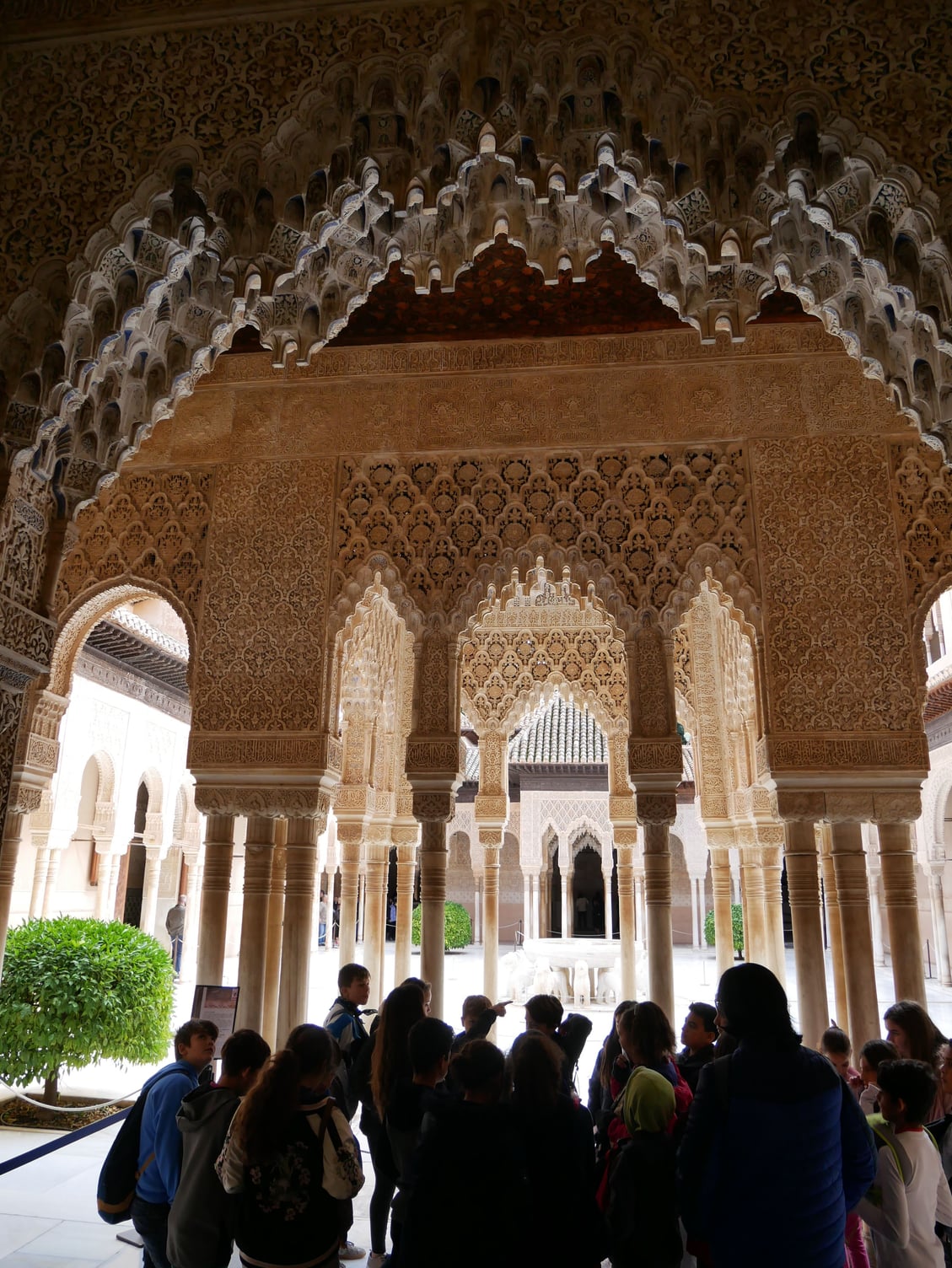
Court of the Lions.
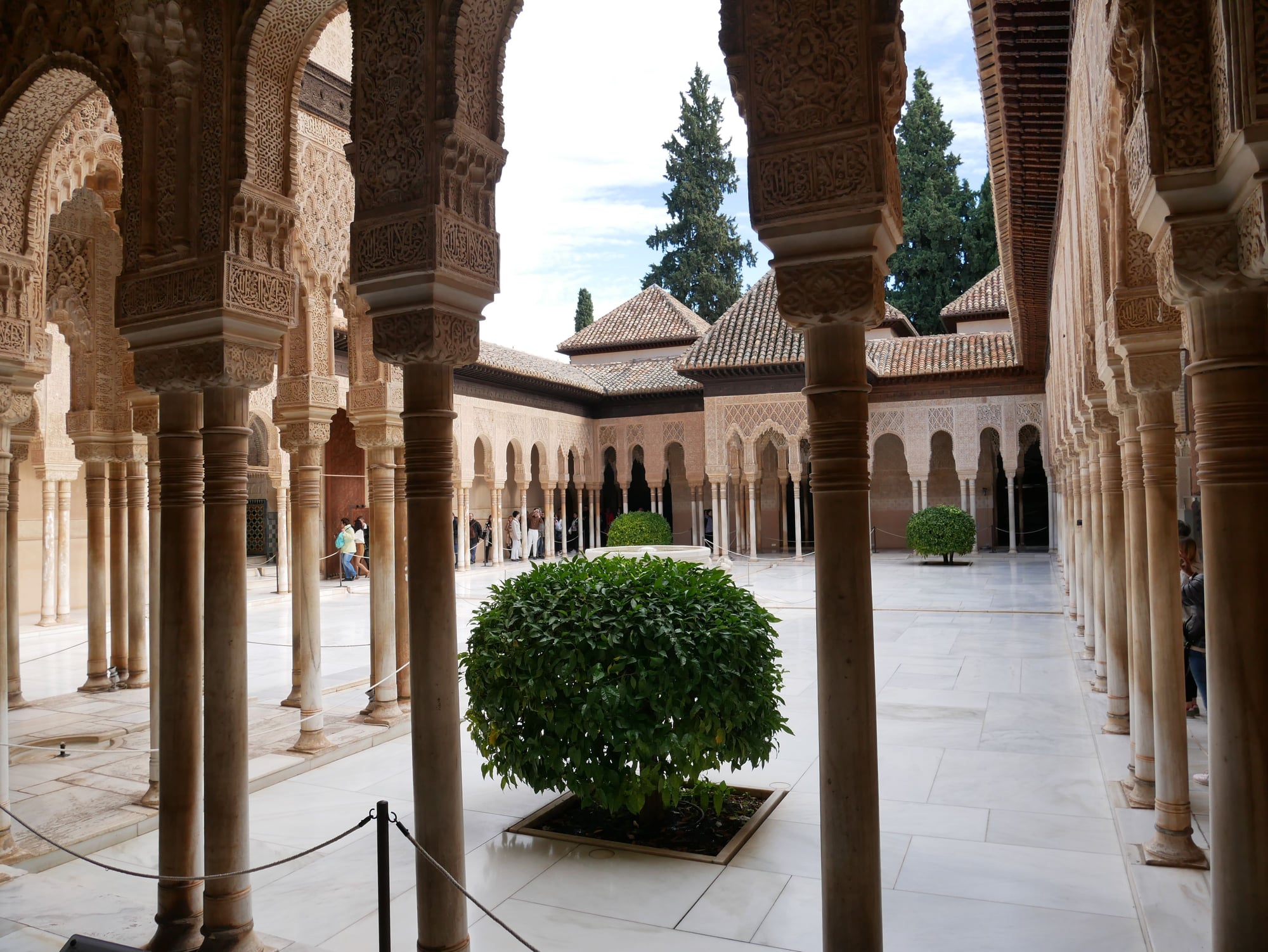
View over the Court of the Lions.
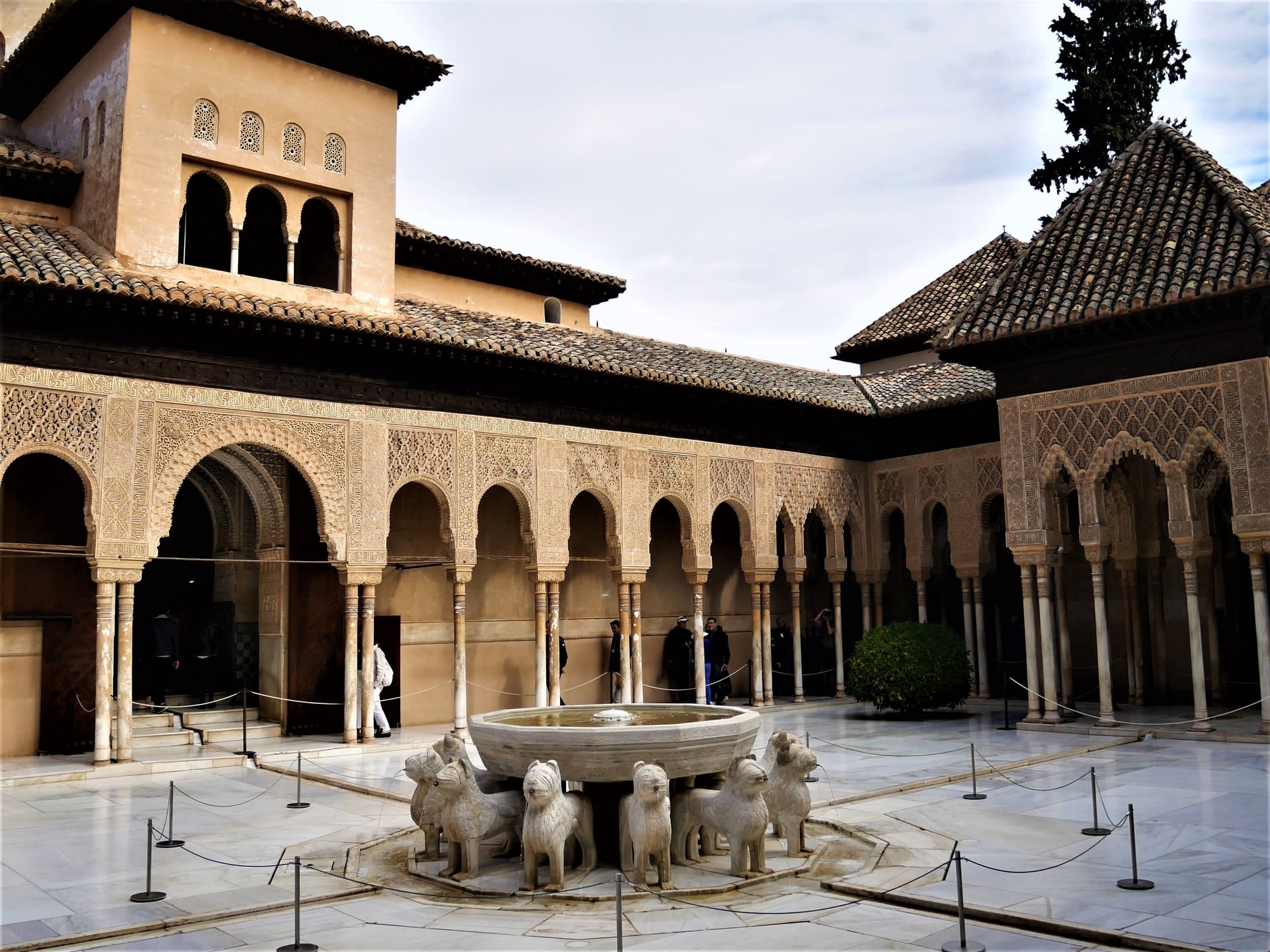
12 lions, symmetrically distrubted around the basin, believed to have been used to calculate time. Fountain of the Lions.

Fountain of Lions, also believed to symbolice the twelve lost tribes of Israel, the twelve months or the temple of King Solomon in Jerusalem.
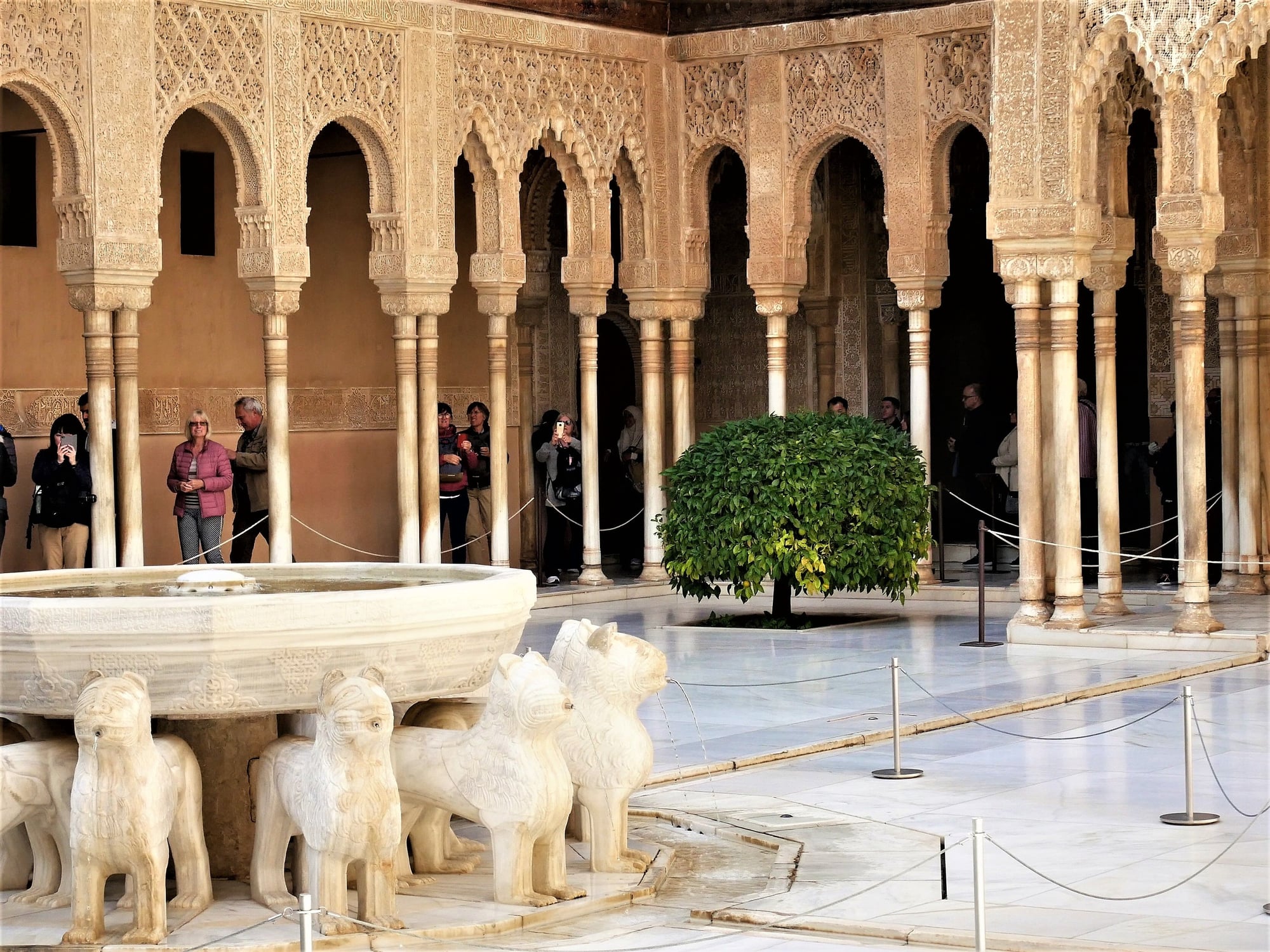
The marble lions is believed to have been carved by Jewish artisans. - Fountain of the Lions.

Hall of the Two Sisters.
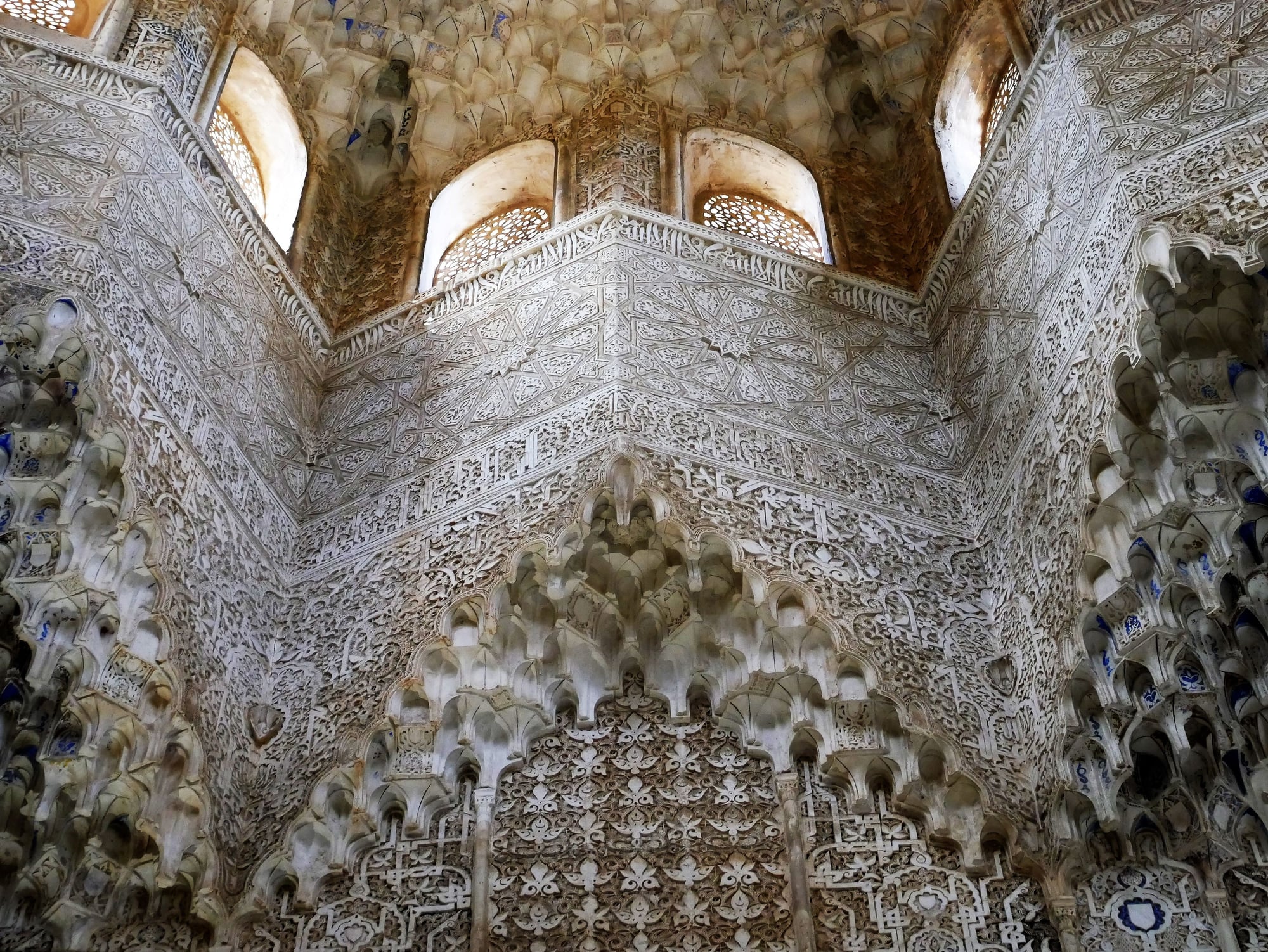
Craftmanship. - Hall of the Two Sisters.

Muslim dignatories, inspired by Gothic art. - Hall of the Kings.
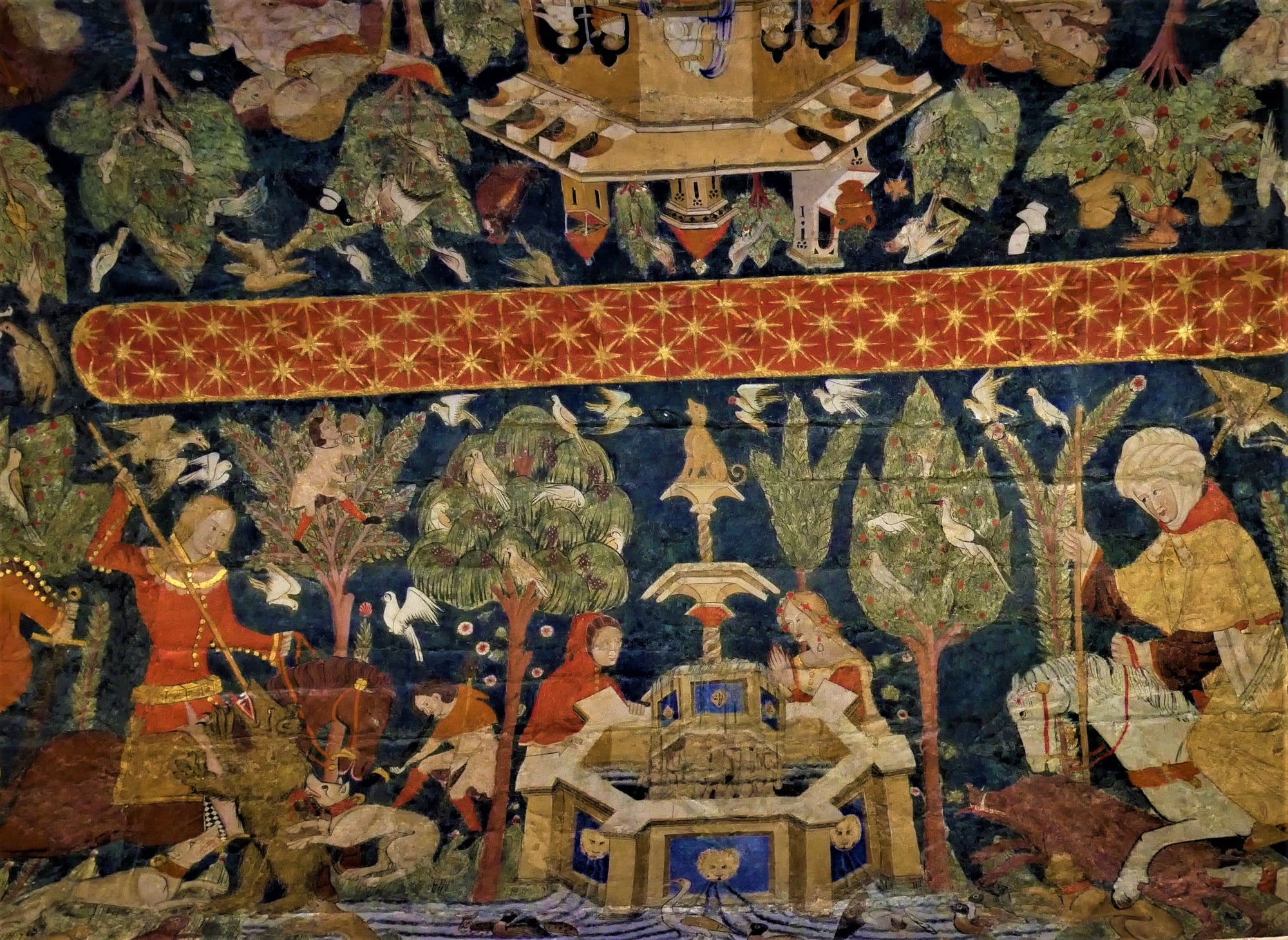
Chivalrous scenes and virtues of sacrifie, courage and generosity. - Hall of the Kings.
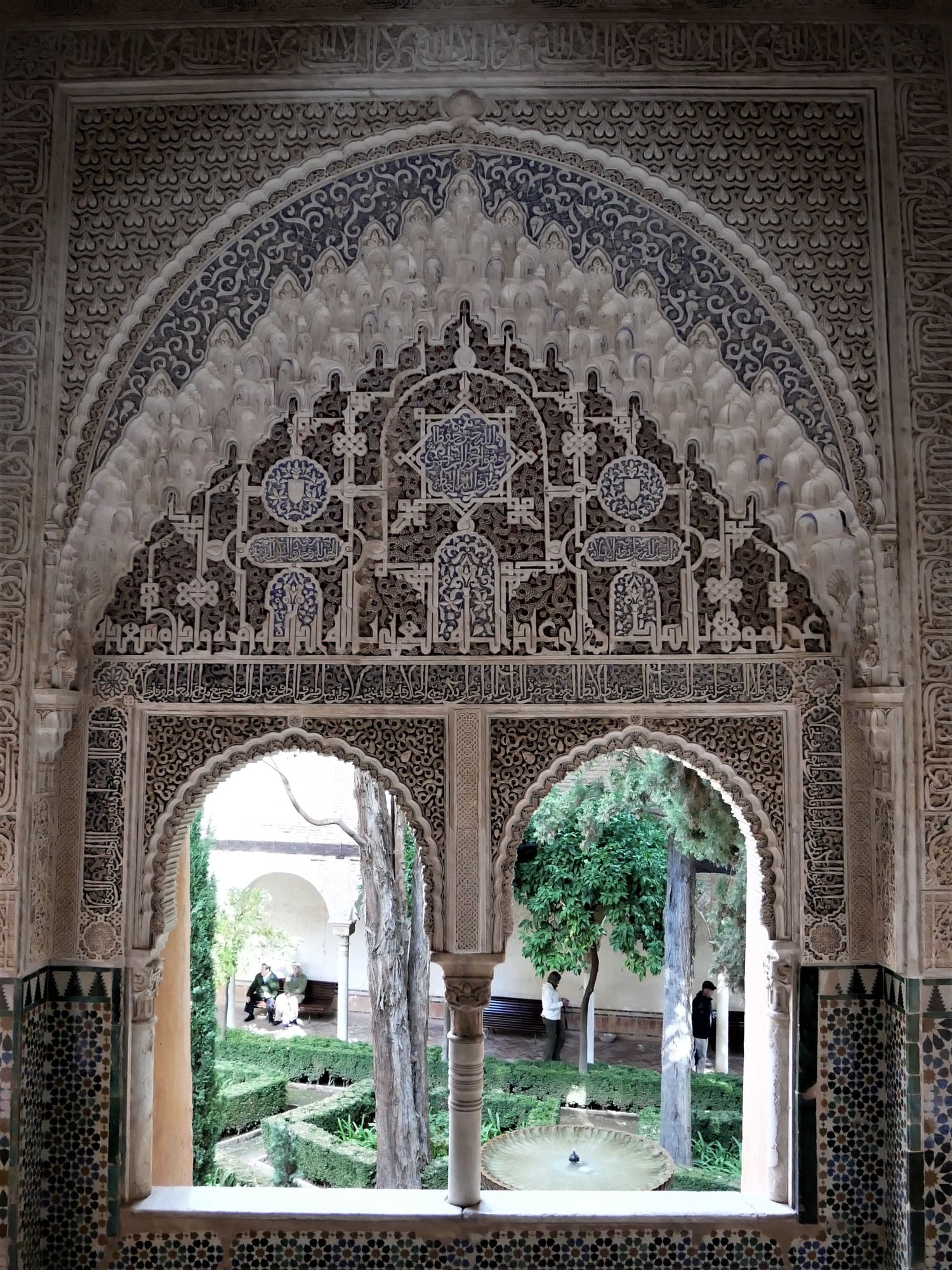
View overlooking garden, room believed to have been used for the Sultan's favourite wife to unwind. - Mirador de Lindaraja.

Archways.
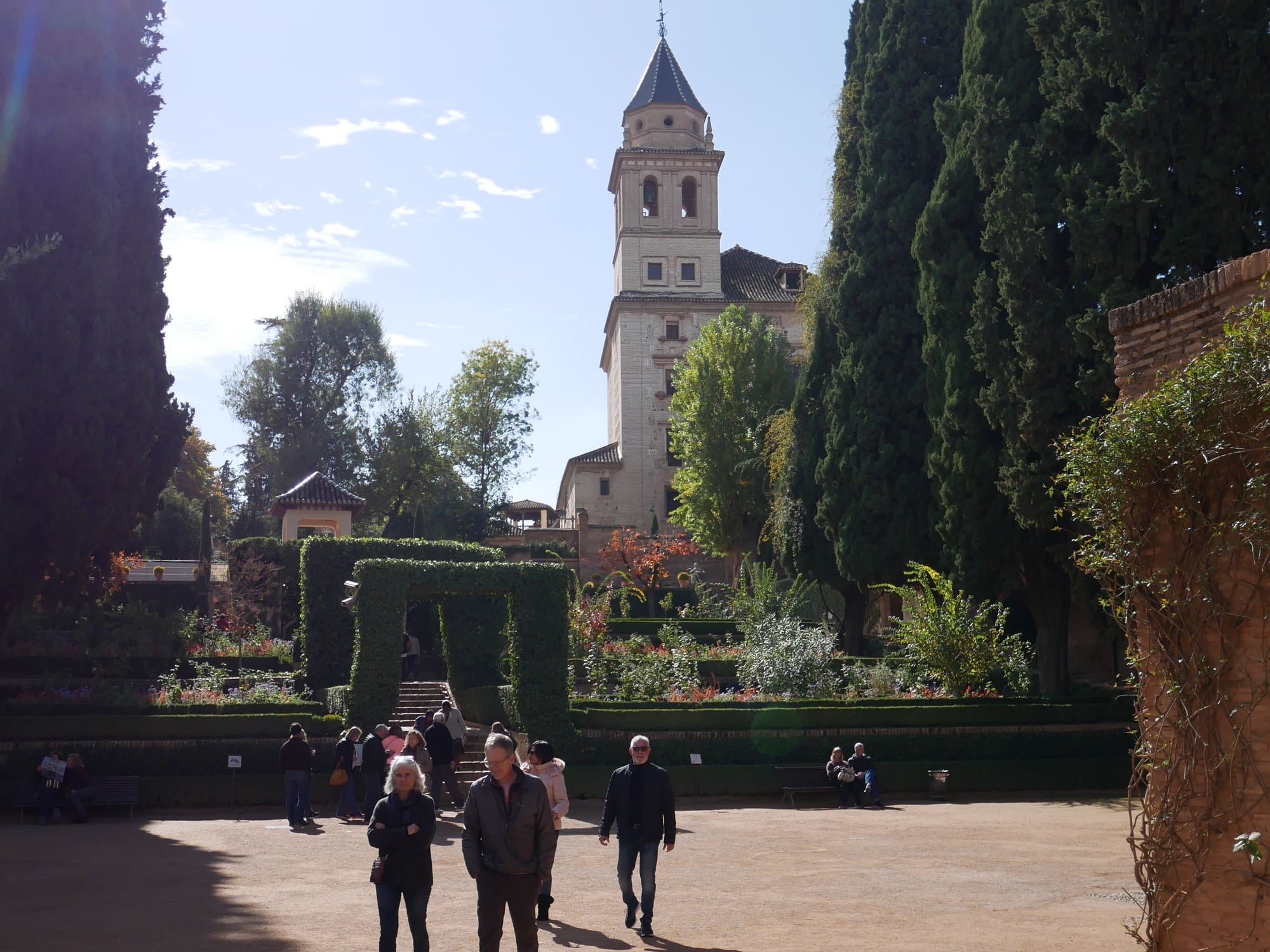
Saint Mary's Church, built between 1581 and 1618, over the site of Alhambra's Great Mosque.
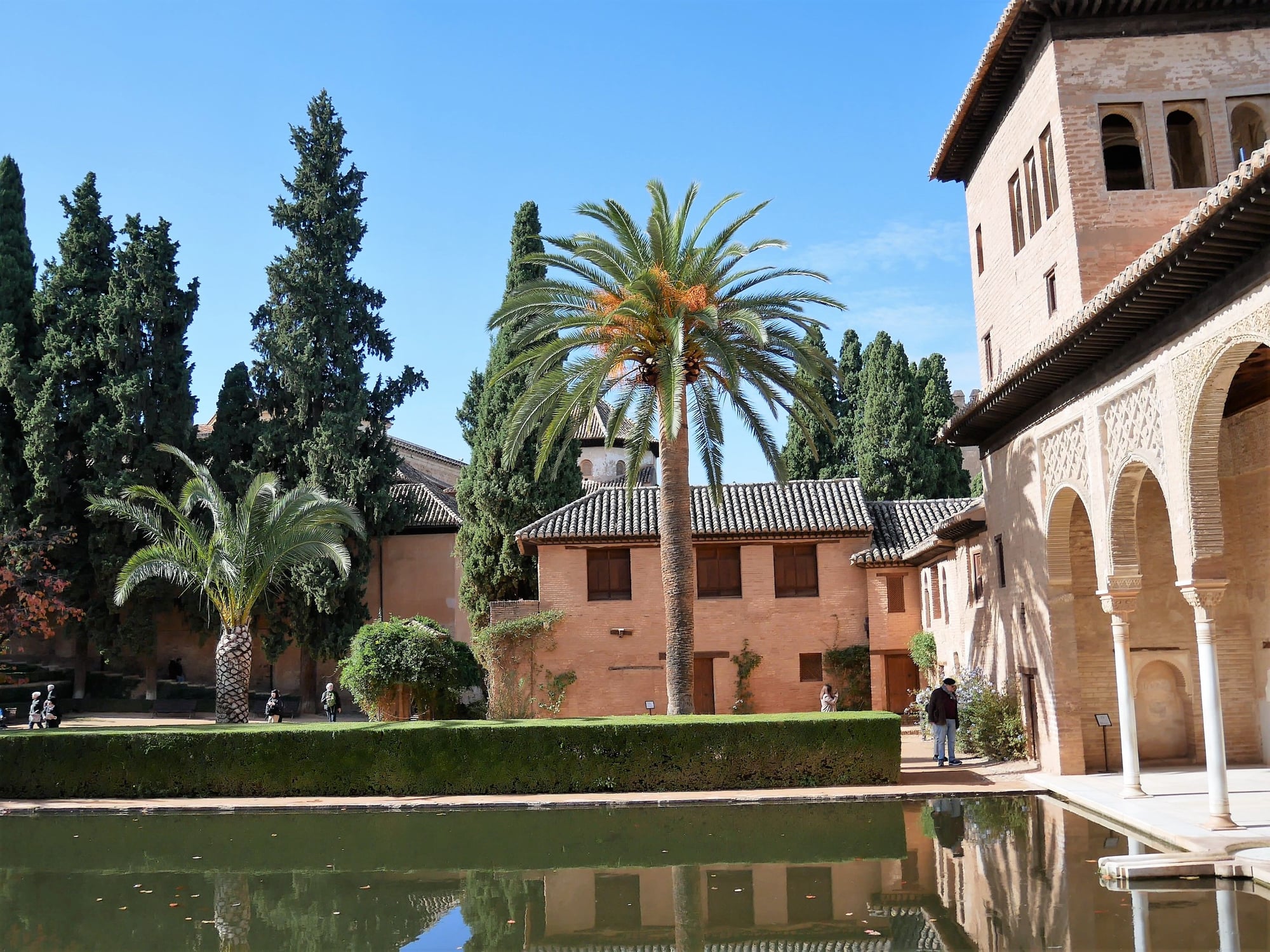
The Partal, the oldest ancient royal palace remaining.
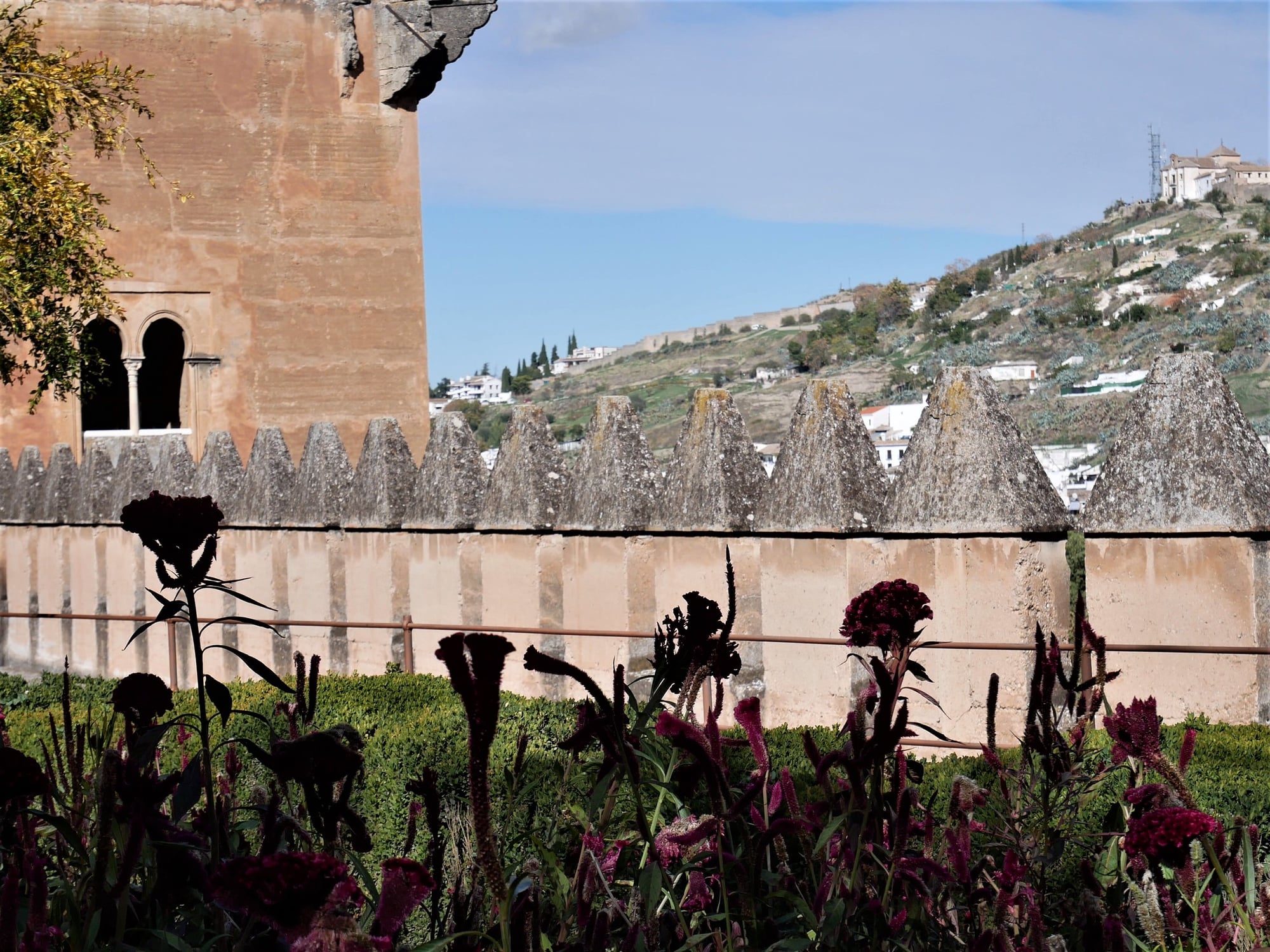
Watchtower & Fortification.
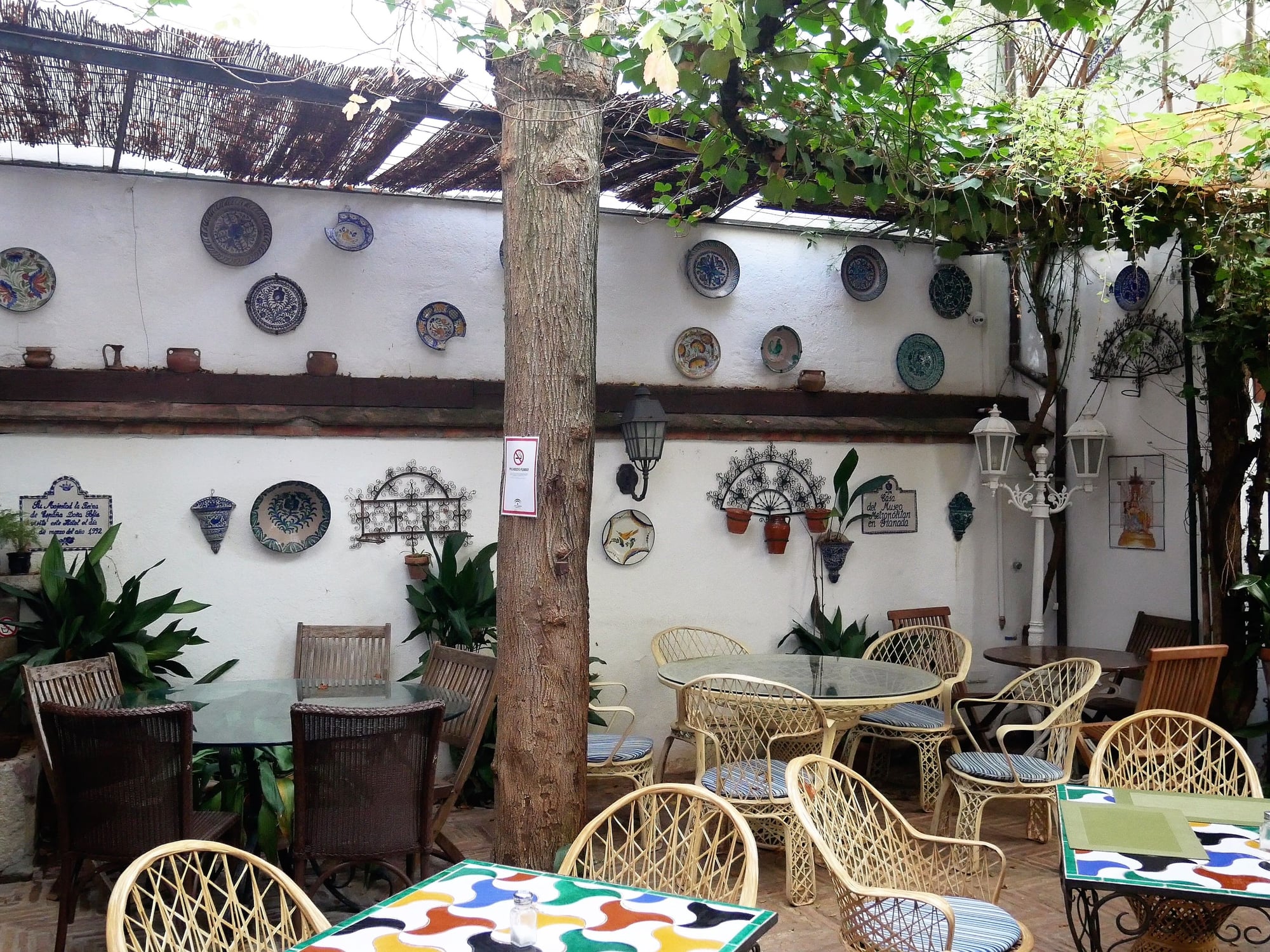
Restaurant inside the Alhambra complex.
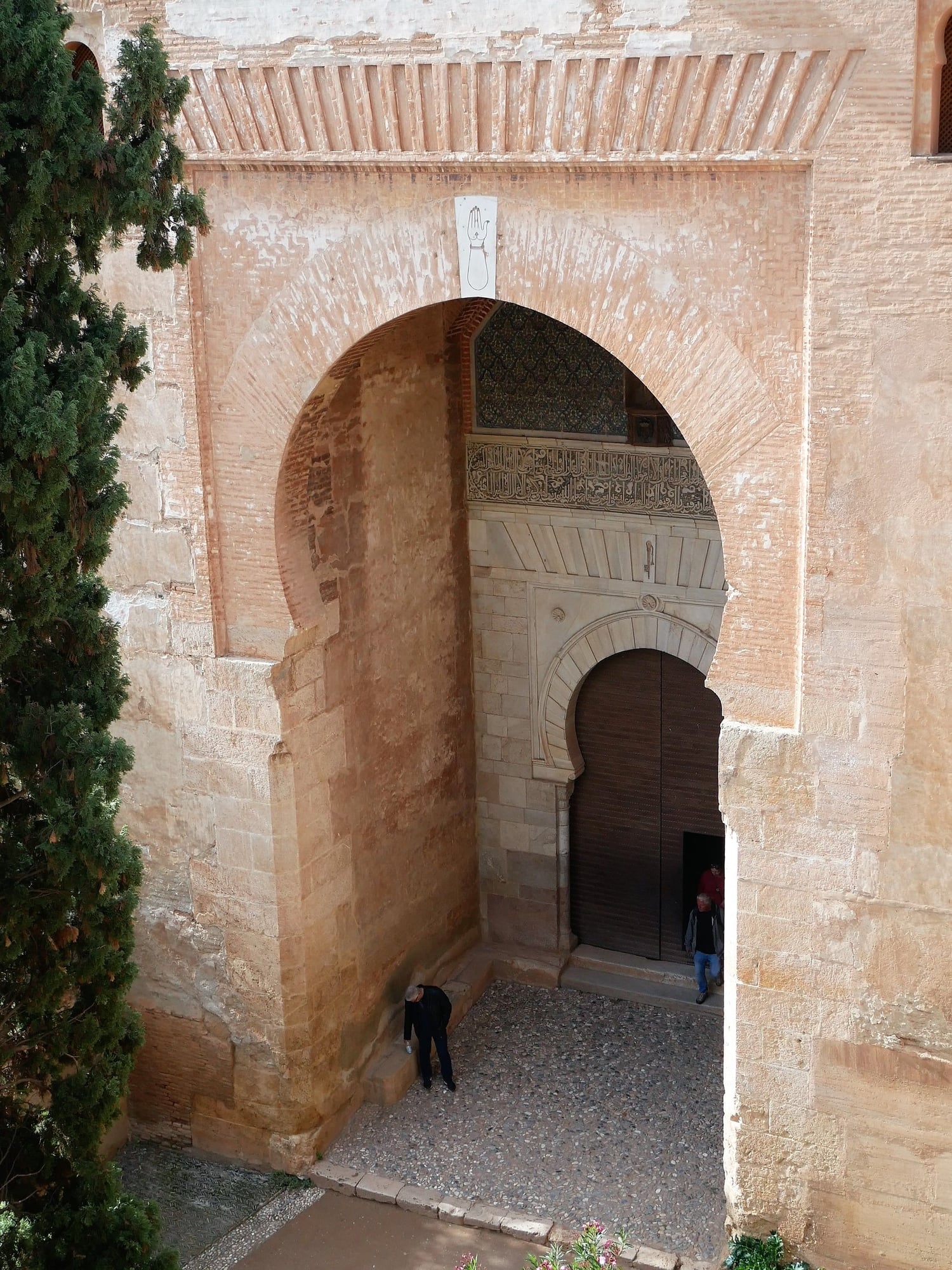
Hand, the idea of welcome and blessing. - The Gate of Justice.
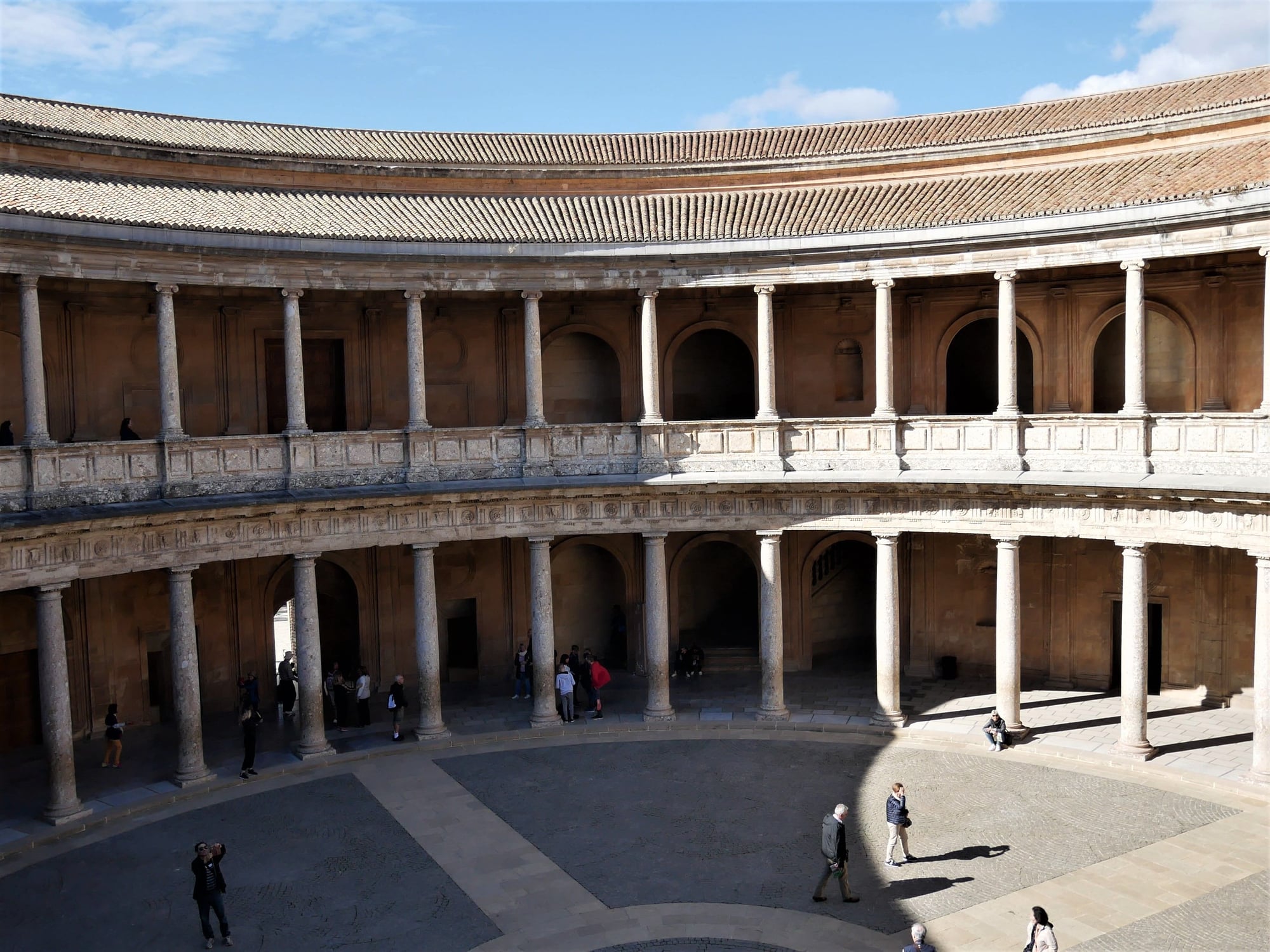
Courtyard. - Palace of Charles V. Charles V never got to stay or see his palace finished.
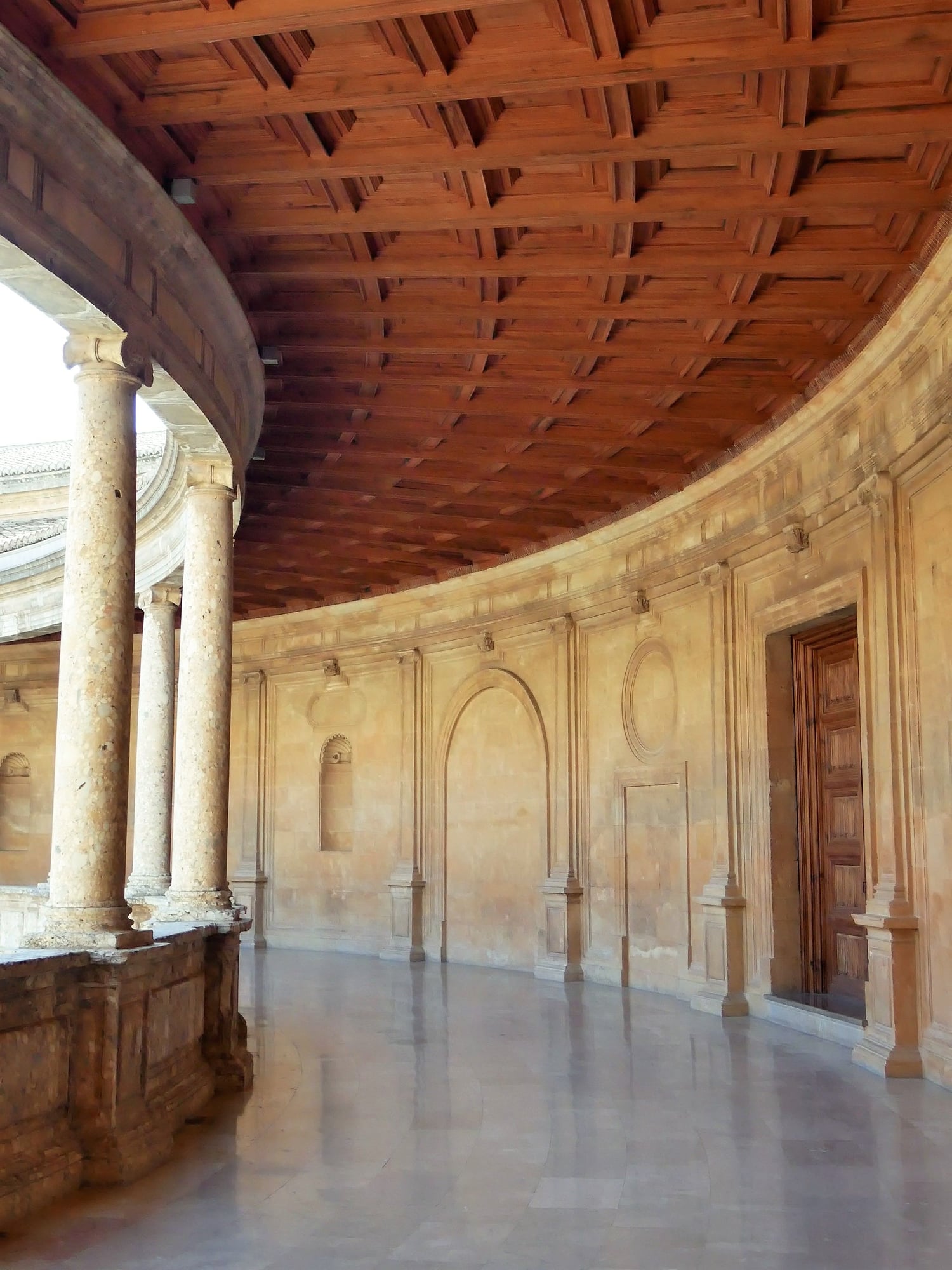
Greco-Roman formulas absorbed by the Italian Renaissance. The Palace of Charles V.

Doric-Tuscan pillars on the lower level, and Ionic columms on the upper level. - The Palace of Charles V.
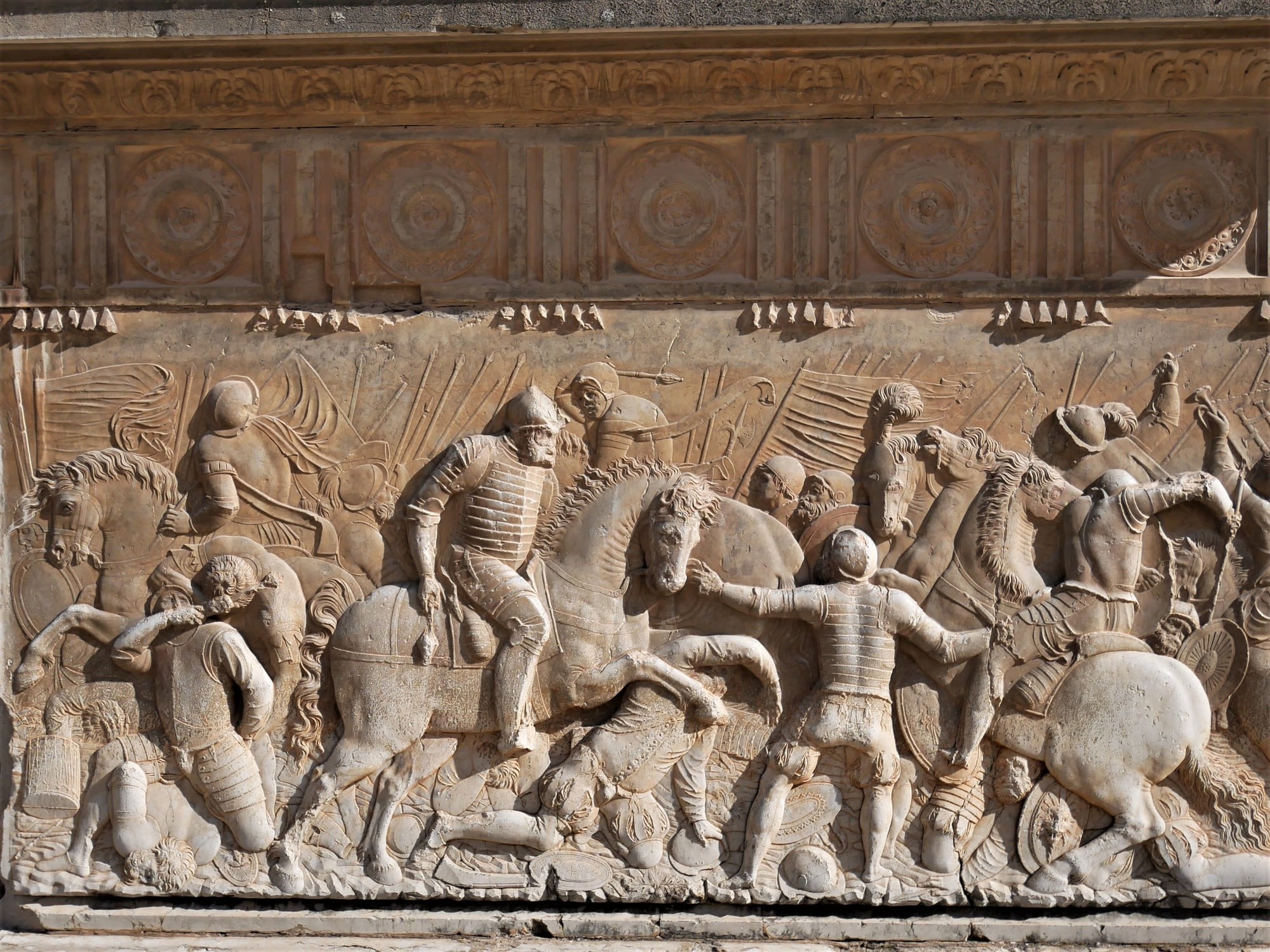
War scenes. - The Battle of Mühlberg. -The Palace of Charles V.
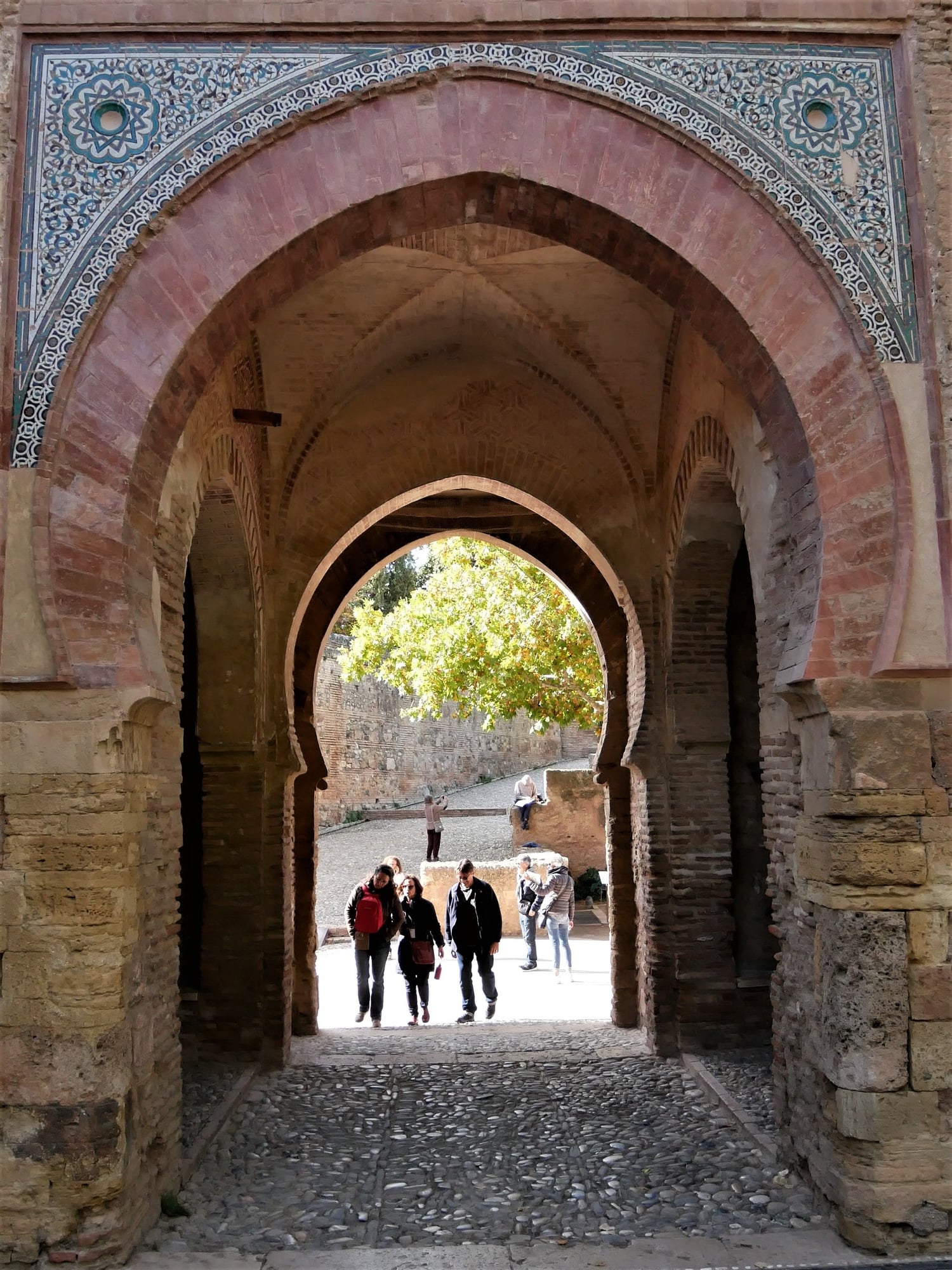
The Wine Gateway.
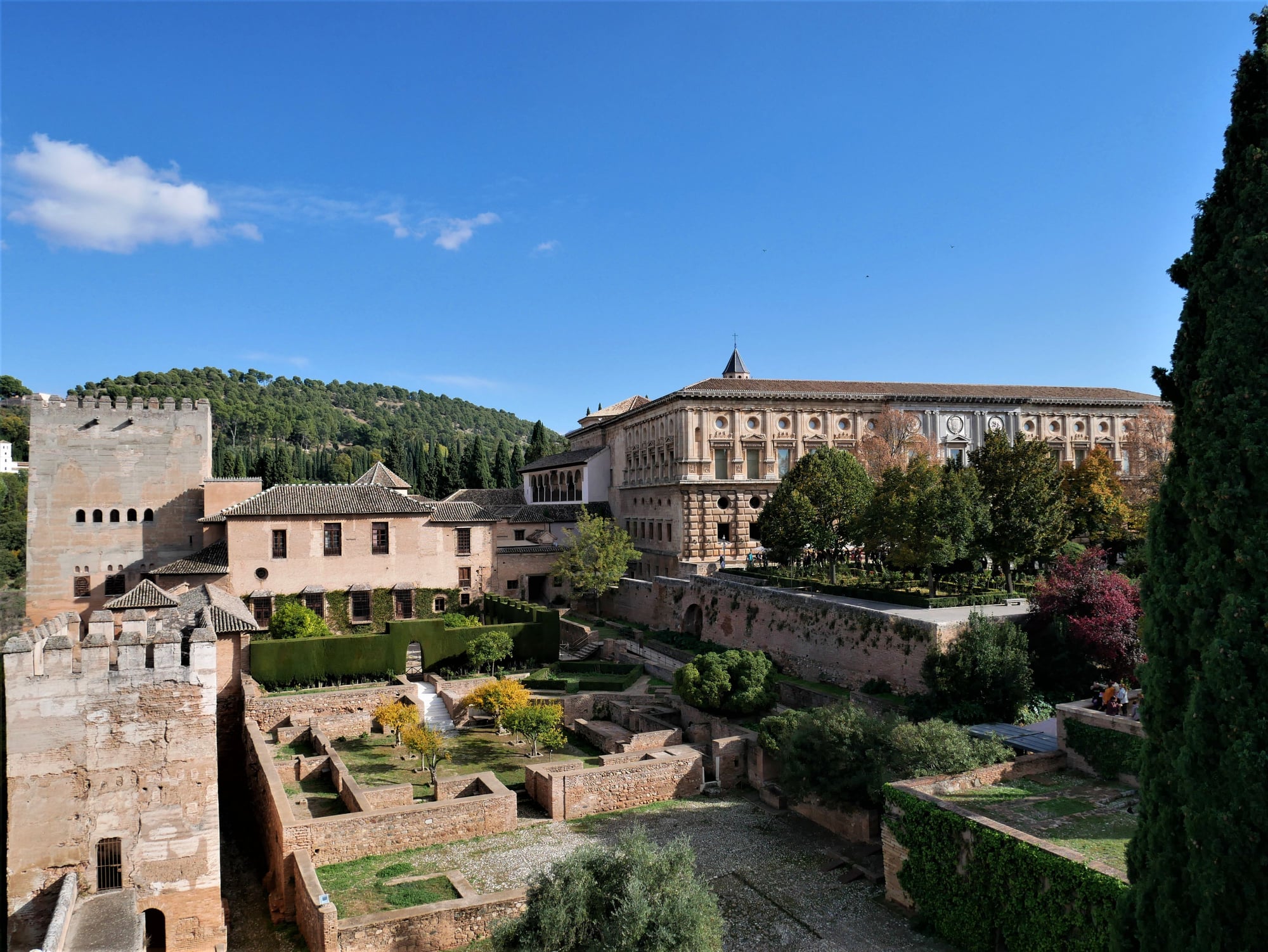
The Palace of Charles V (in the back), he was defender of the unity of Christianity, he ruled over an extensive empire as diverse and distant as Spain, Peru, the Netherlands and Mexico.
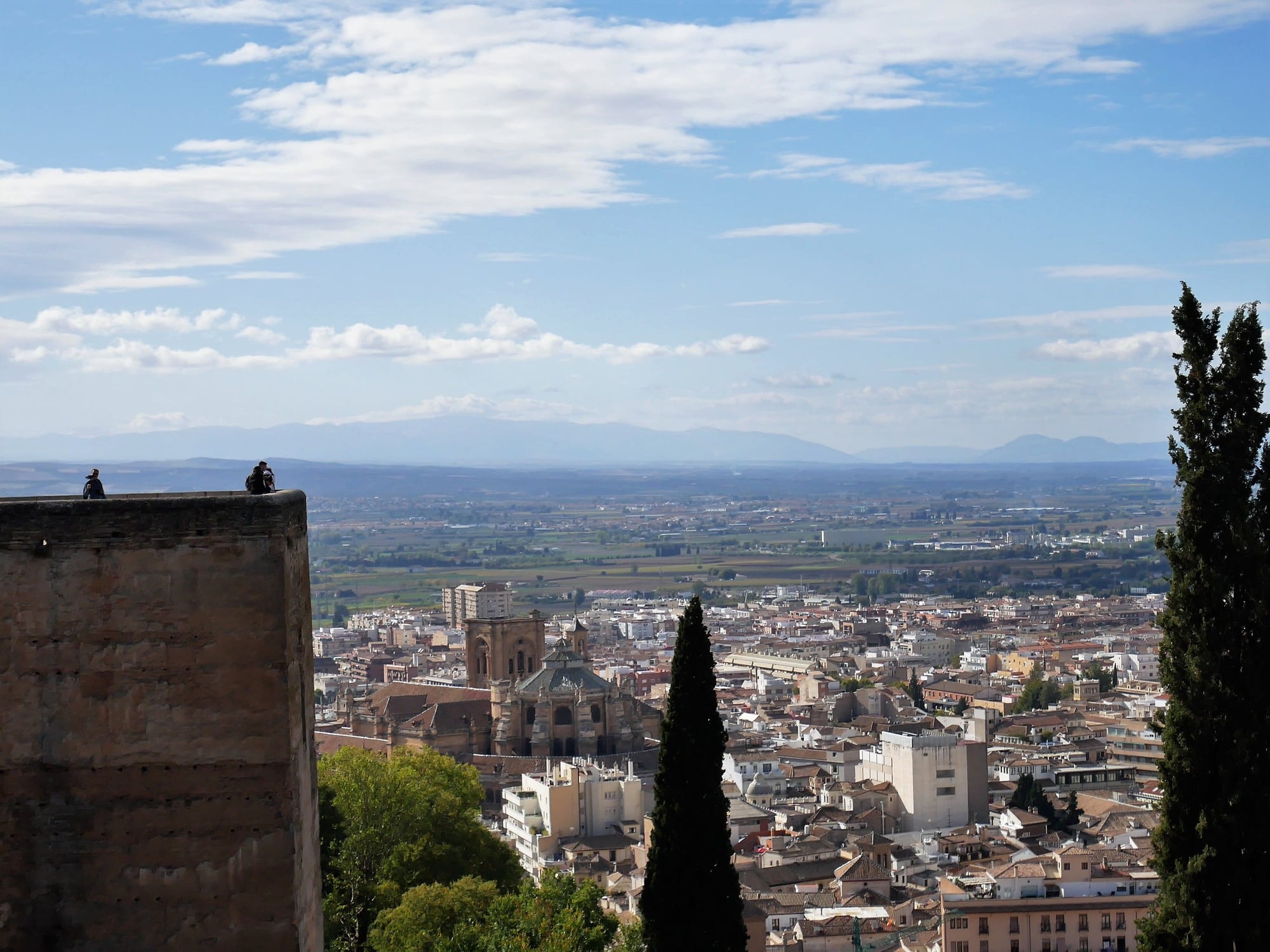
Wattower and view over Granada.

Former warehouses, dungeons, oven and steam baths for the soldiers. - The Alcazaba.
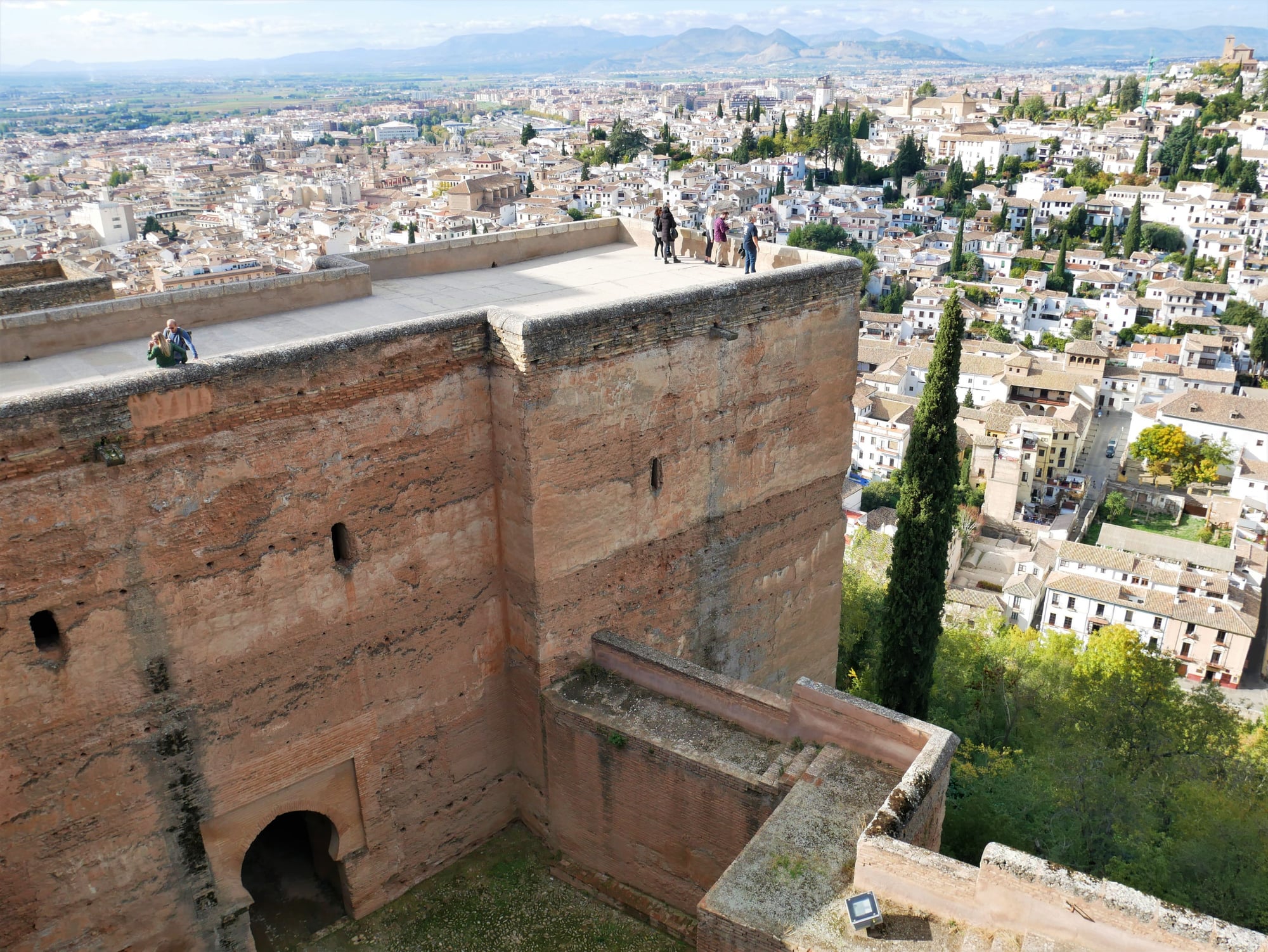
Stronghold, built on rugged hill. - The Alcazaba.
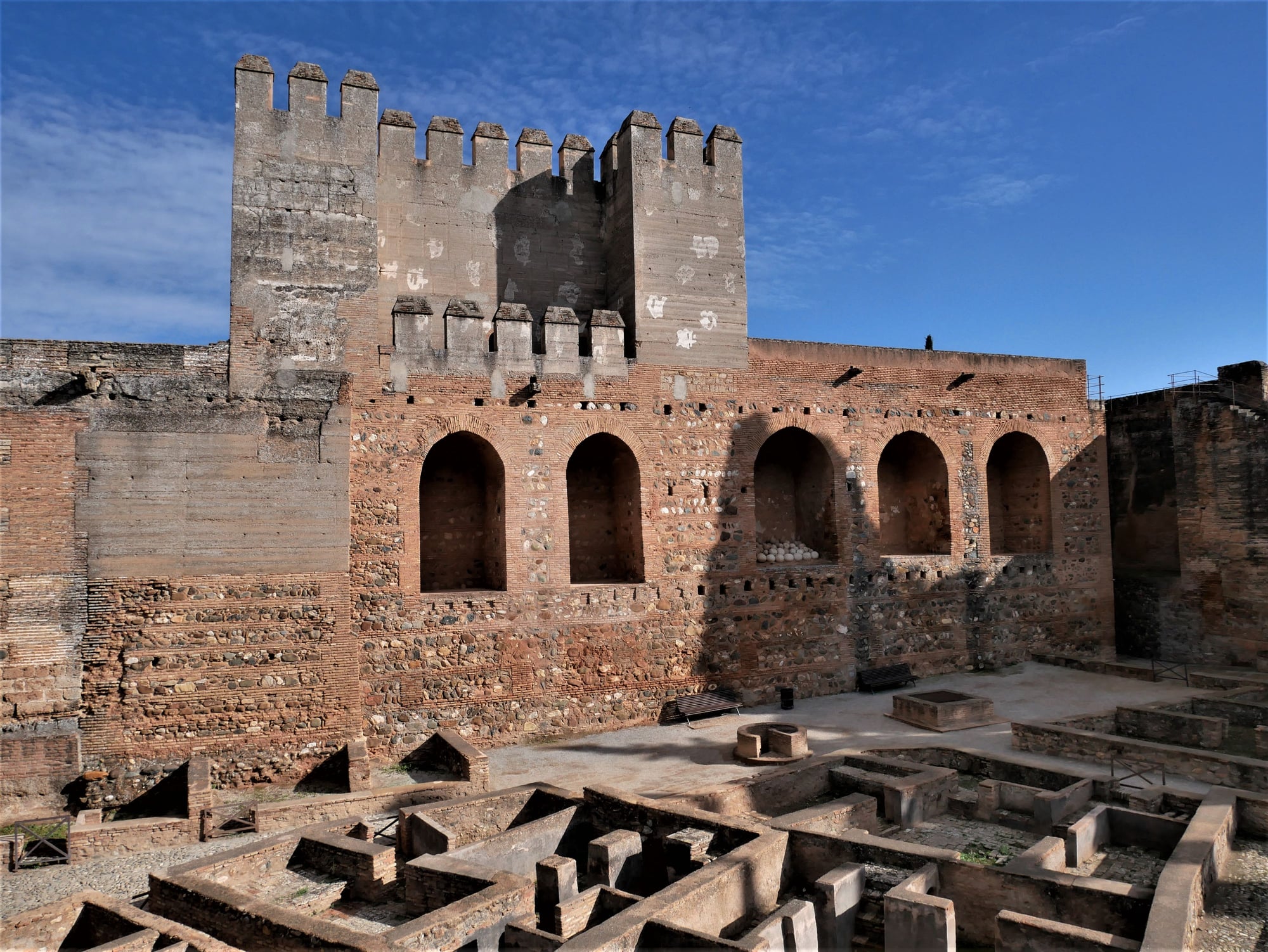
Military district. - The Alcazaba

Barracks with the Palace of Charles V in the back.
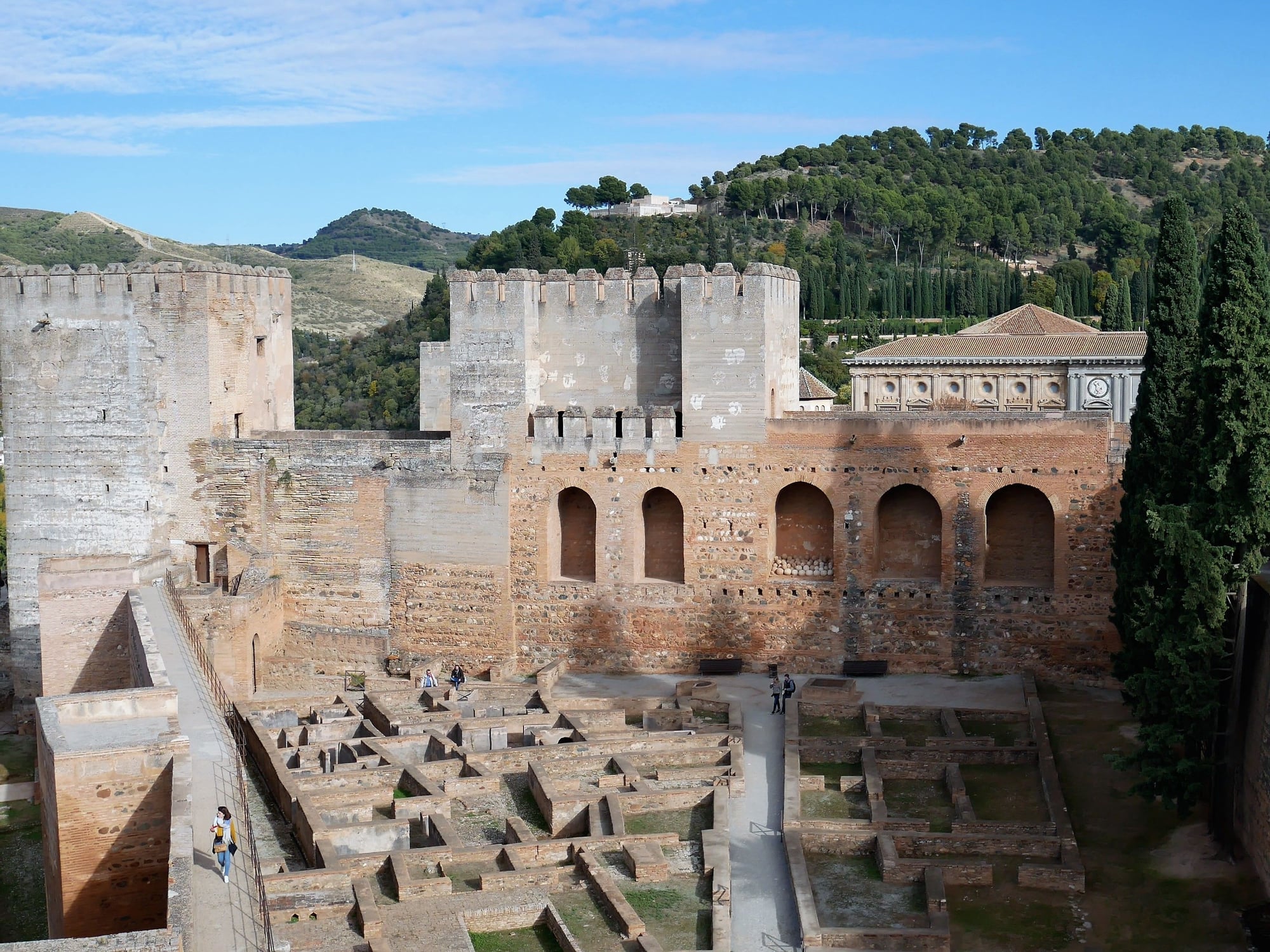
Housing, stores and warehouse. Military base/area. - The Alcazaba.
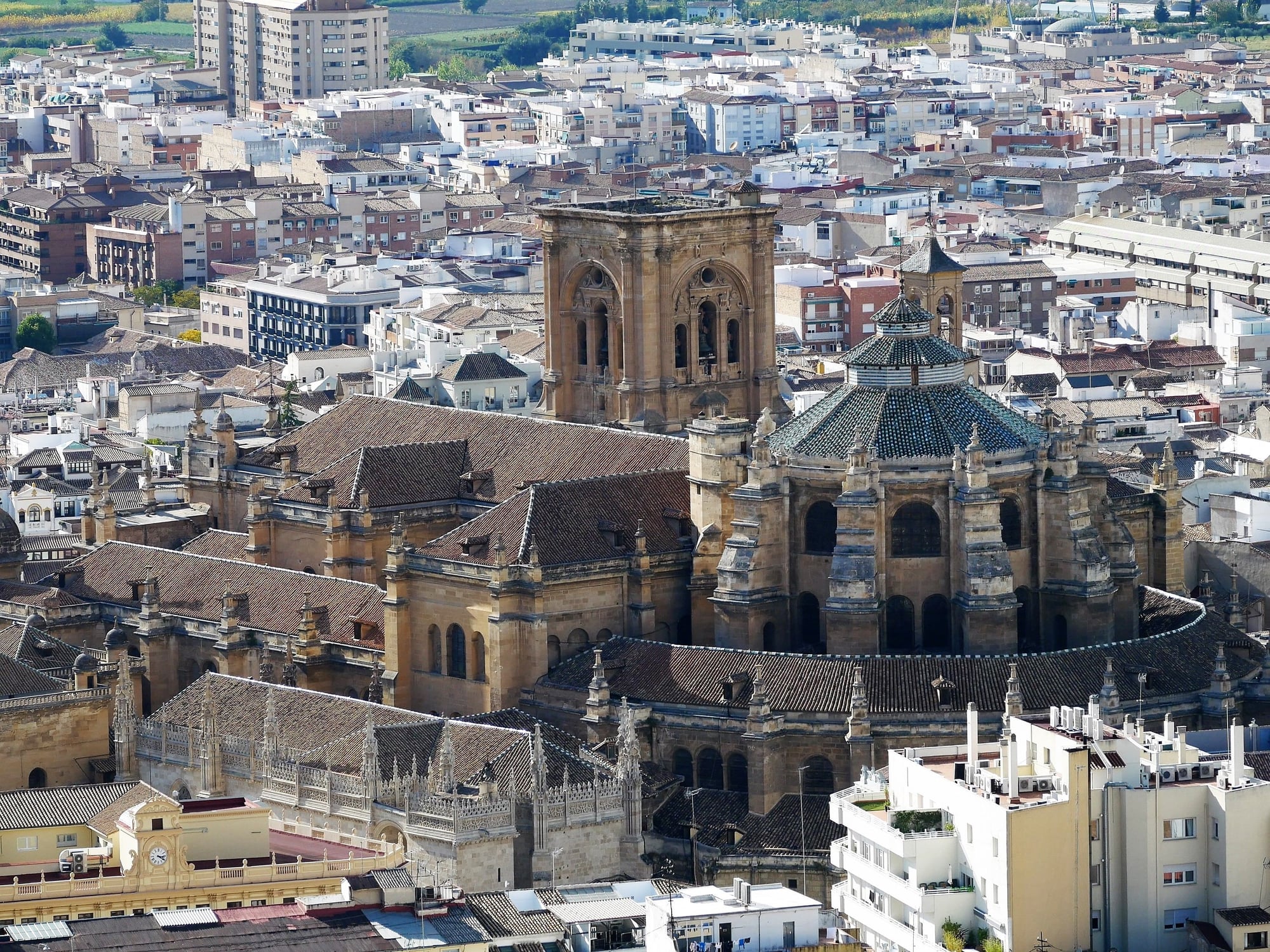
Cathedral Capilla Real de Granada, constructed between 1505 and 1517, burial place of the Spanish monarchs, Queen Isabella I and King Ferdinand, the Catholics.
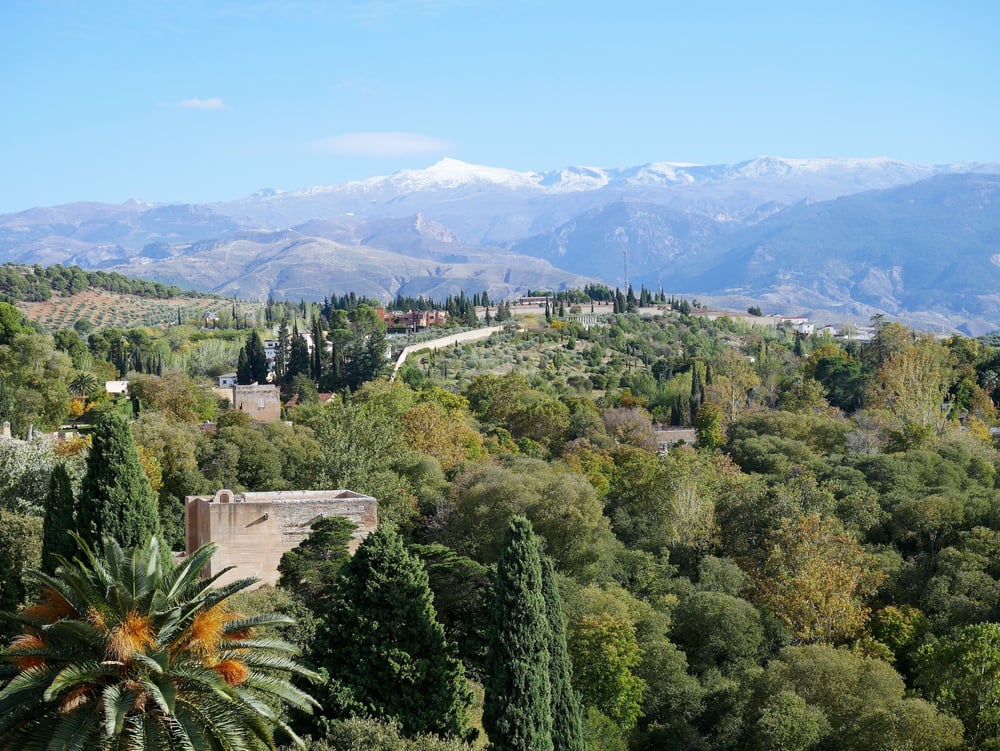
Watchtowers and walls surrounded by green landscape and the Sierra Nevada in the back.

View of the Alhambra from the Generalife.
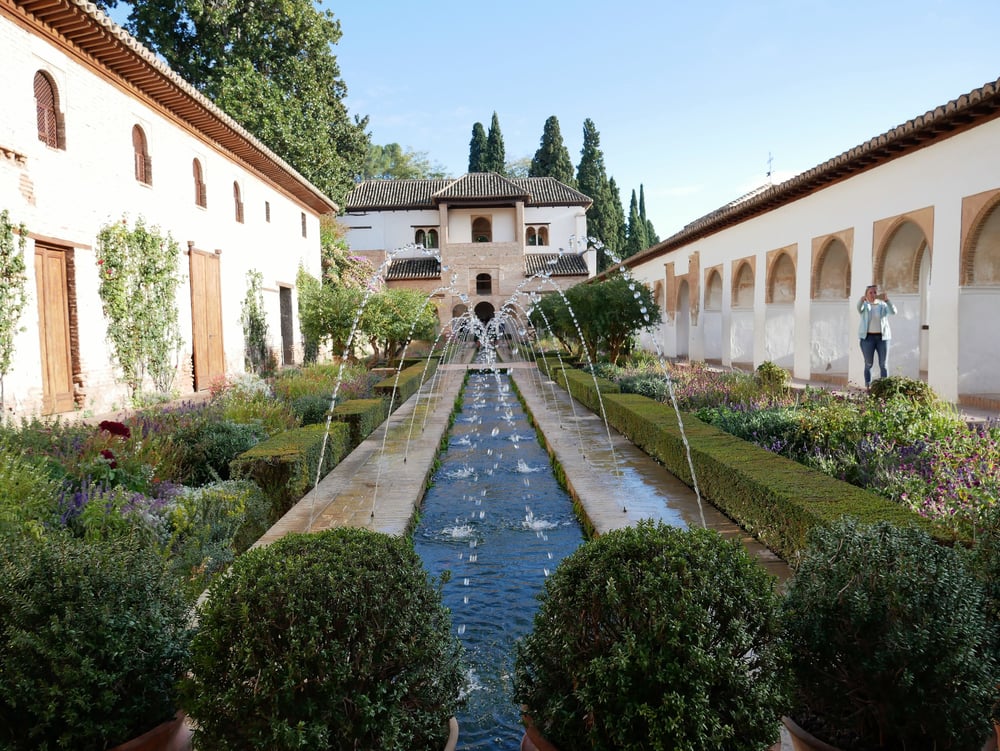
The Main Canal Court. - The Gerneralife.
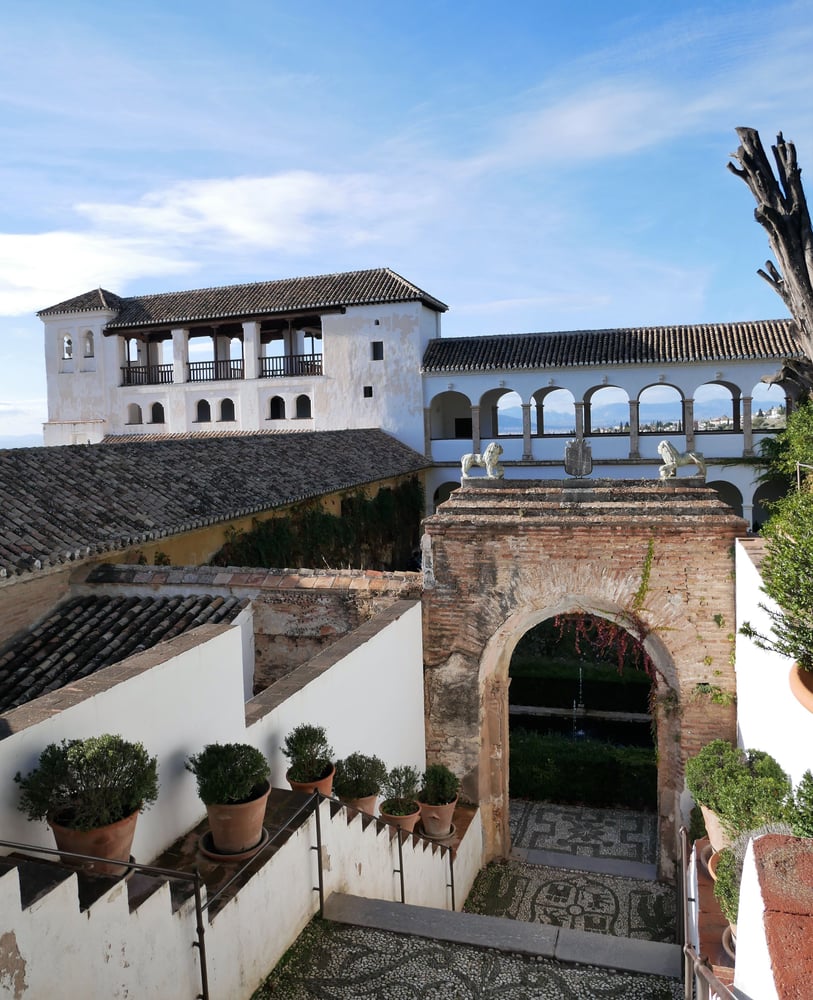
The Palace area for the comfort of the Nasrid monarchs, the concubines also stayed in this area.
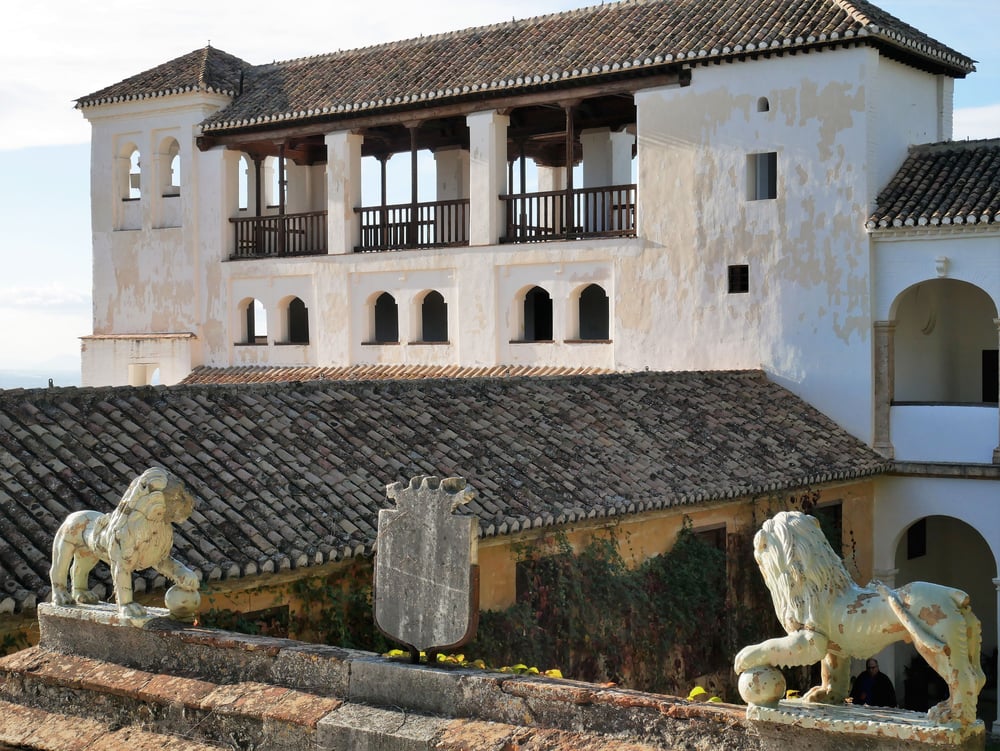
Lions. - The Palace.
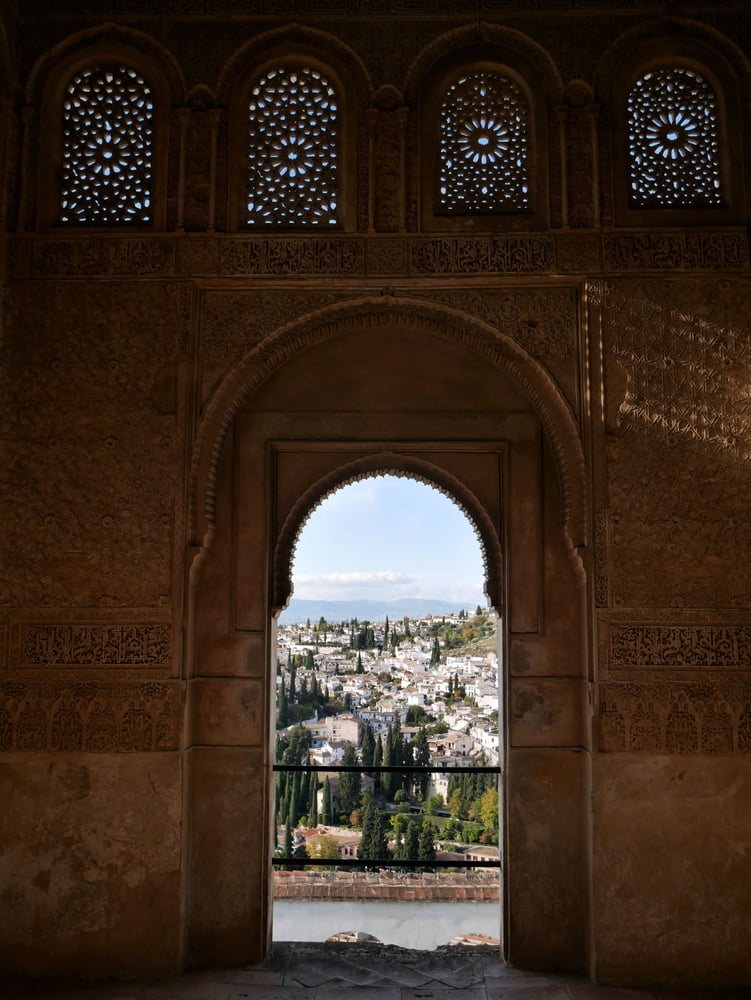
View from the Royal Chamber. - The Palace.
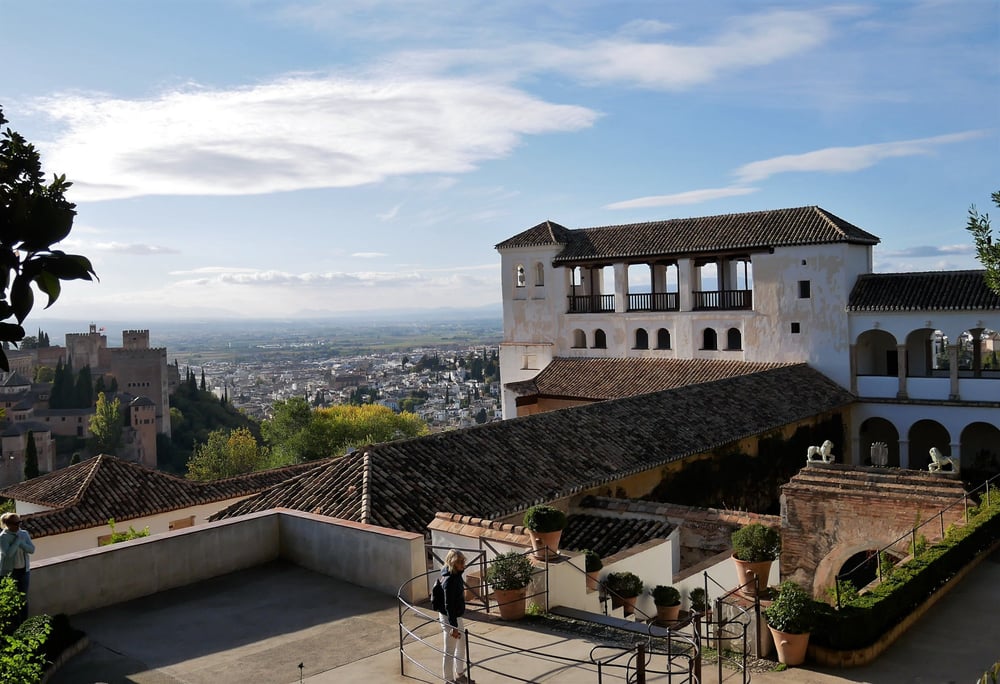
The Palace and residental area. - The Generalife with the Alhambra to the left.
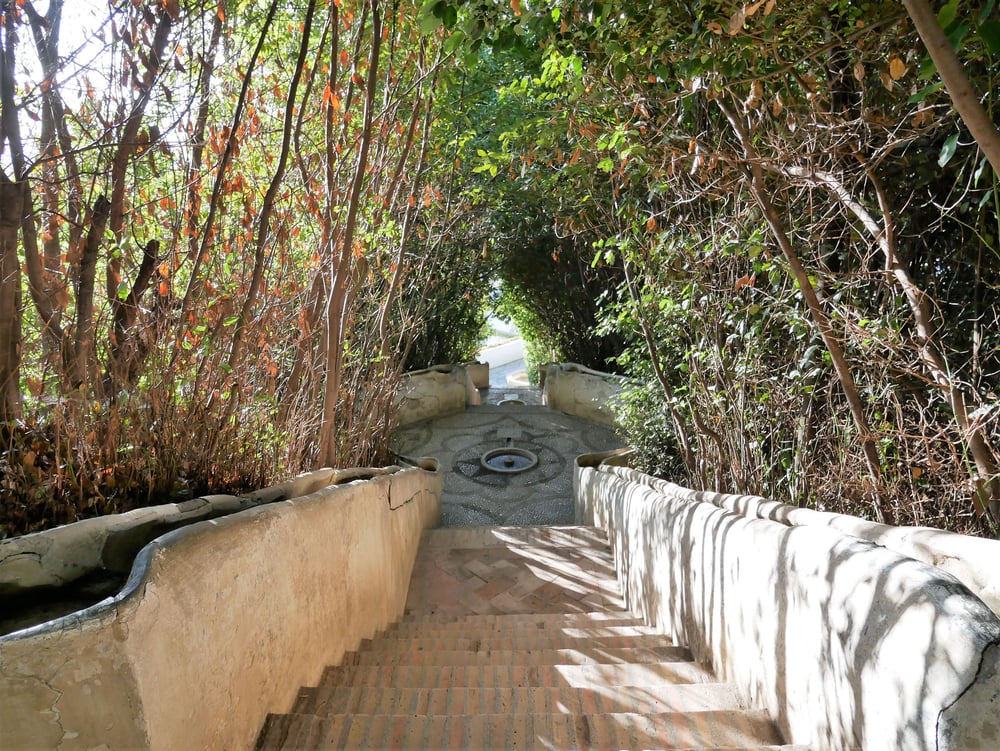
Water staircase flanked by canals, originally led to an oratory room. - The Generalife.

Courtyard. Entrance to the Throne Room and the monumental Comares Tower. - The Court of Myrtles.

The alcoves originally contained glasses of water, they also might have held perfumes or flowers.

Inscriptions . The Nasrid kingdom's motto was; "There is no victor but God".

Court of the Lions.

View over the Court of the Lions.

12 lions, symmetrically distrubted around the basin, believed to have been used to calculate time. Fountain of the Lions.

Fountain of Lions, also believed to symbolice the twelve lost tribes of Israel, the twelve months or the temple of King Solomon in Jerusalem.

The marble lions is believed to have been carved by Jewish artisans. - Fountain of the Lions.

Hall of the Two Sisters.

Craftmanship. - Hall of the Two Sisters.

Muslim dignatories, inspired by Gothic art. - Hall of the Kings.

Chivalrous scenes and virtues of sacrifie, courage and generosity. - Hall of the Kings.

View overlooking garden, room believed to have been used for the Sultan's favourite wife to unwind. - Mirador de Lindaraja.

Archways.

Saint Mary's Church, built between 1581 and 1618, over the site of Alhambra's Great Mosque.

The Partal, the oldest ancient royal palace remaining.

Watchtower & Fortification.

Restaurant inside the Alhambra complex.

Hand, the idea of welcome and blessing. - The Gate of Justice.

Courtyard. - Palace of Charles V. Charles V never got to stay or see his palace finished.

Greco-Roman formulas absorbed by the Italian Renaissance. The Palace of Charles V.

Doric-Tuscan pillars on the lower level, and Ionic columms on the upper level. - The Palace of Charles V.

War scenes. - The Battle of Mühlberg. -The Palace of Charles V.

The Wine Gateway.

The Palace of Charles V (in the back), he was defender of the unity of Christianity, he ruled over an extensive empire as diverse and distant as Spain, Peru, the Netherlands and Mexico.

Wattower and view over Granada.

Former warehouses, dungeons, oven and steam baths for the soldiers. - The Alcazaba.

Stronghold, built on rugged hill. - The Alcazaba.

Military district. - The Alcazaba

Barracks with the Palace of Charles V in the back.

Housing, stores and warehouse. Military base/area. - The Alcazaba.

Cathedral Capilla Real de Granada, constructed between 1505 and 1517, burial place of the Spanish monarchs, Queen Isabella I and King Ferdinand, the Catholics.

Watchtowers and walls surrounded by green landscape and the Sierra Nevada in the back.

View of the Alhambra from the Generalife.

The Main Canal Court. - The Gerneralife.

The Palace area for the comfort of the Nasrid monarchs, the concubines also stayed in this area.

Lions. - The Palace.

View from the Royal Chamber. - The Palace.

The Palace and residental area. - The Generalife with the Alhambra to the left.

Water staircase flanked by canals, originally led to an oratory room. - The Generalife.



















